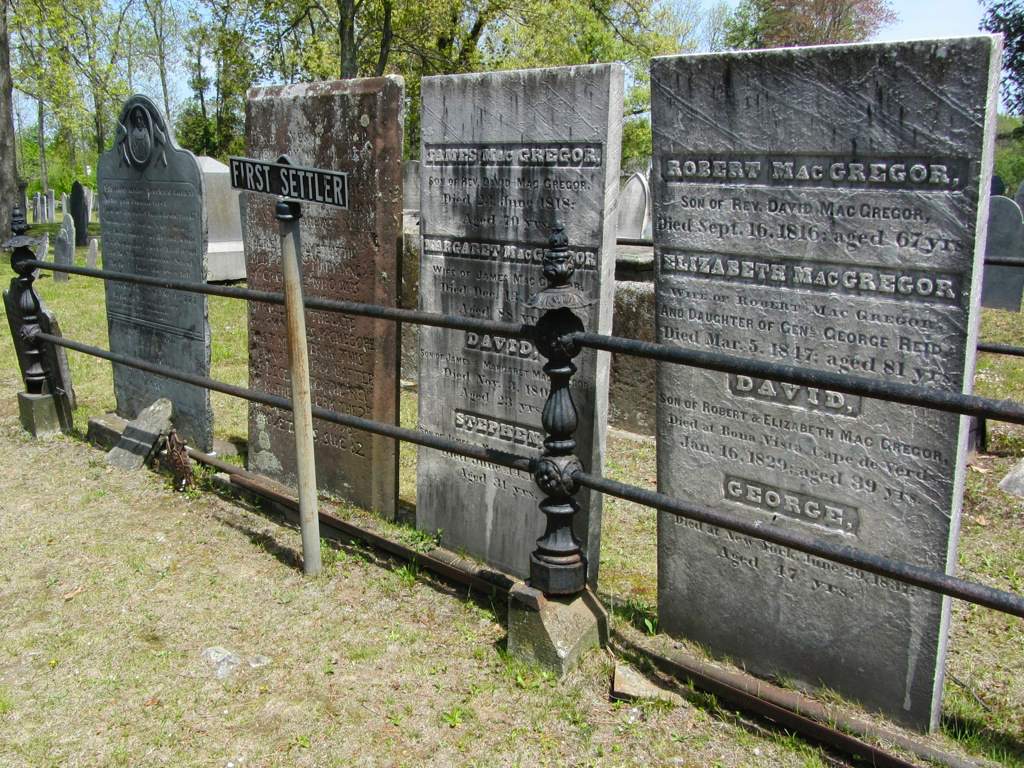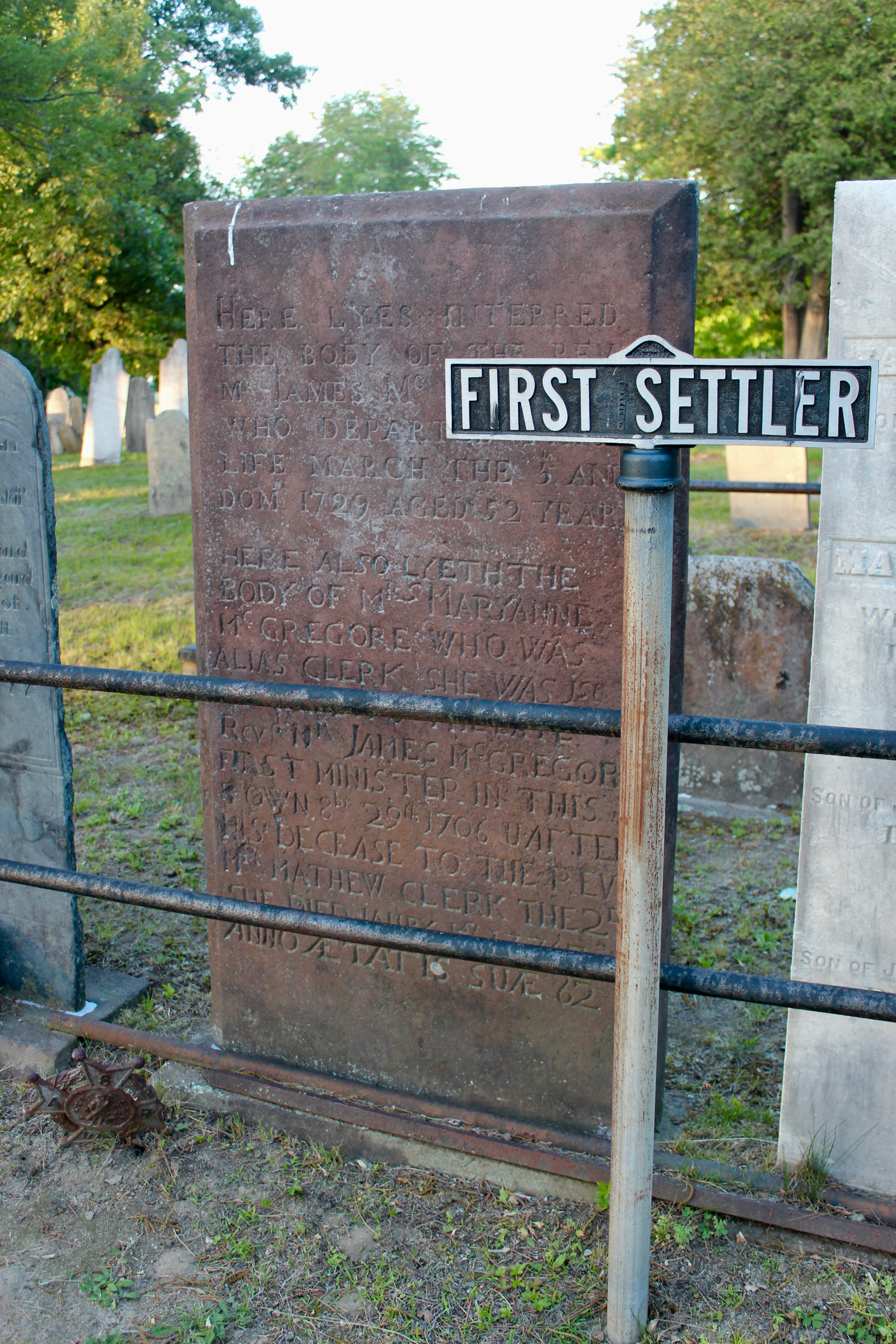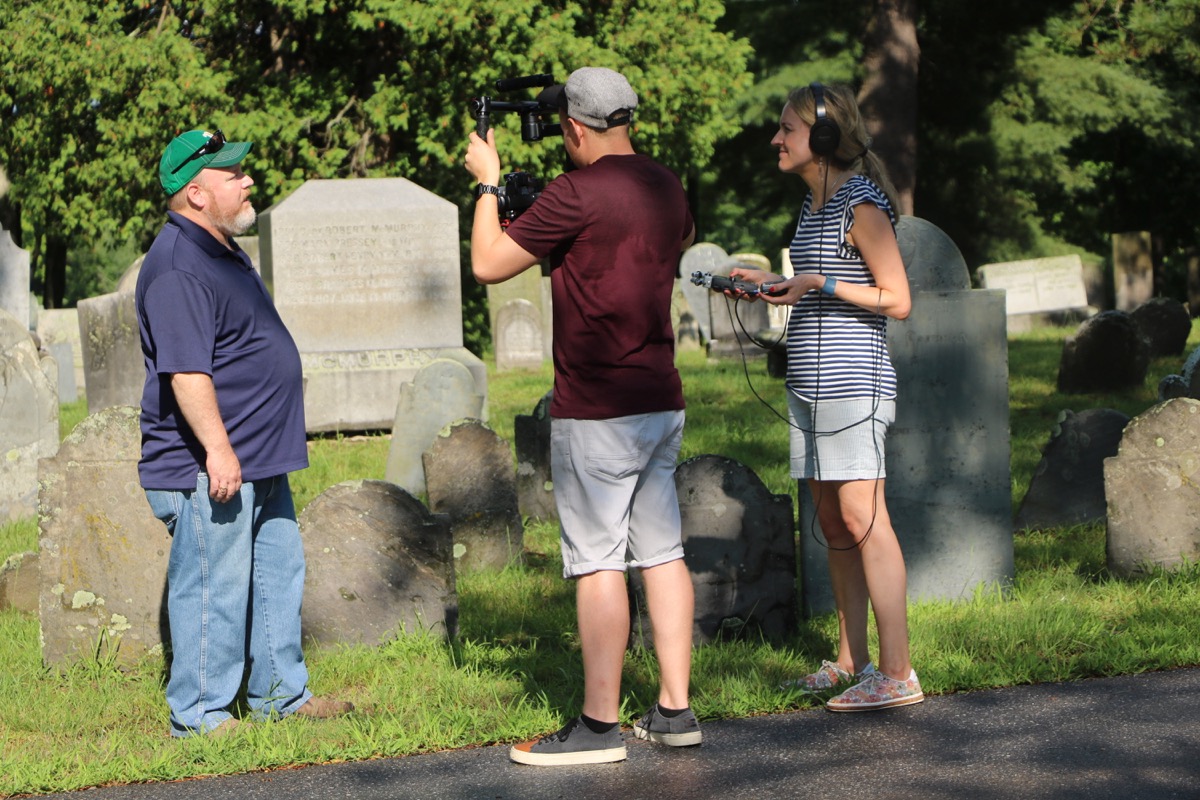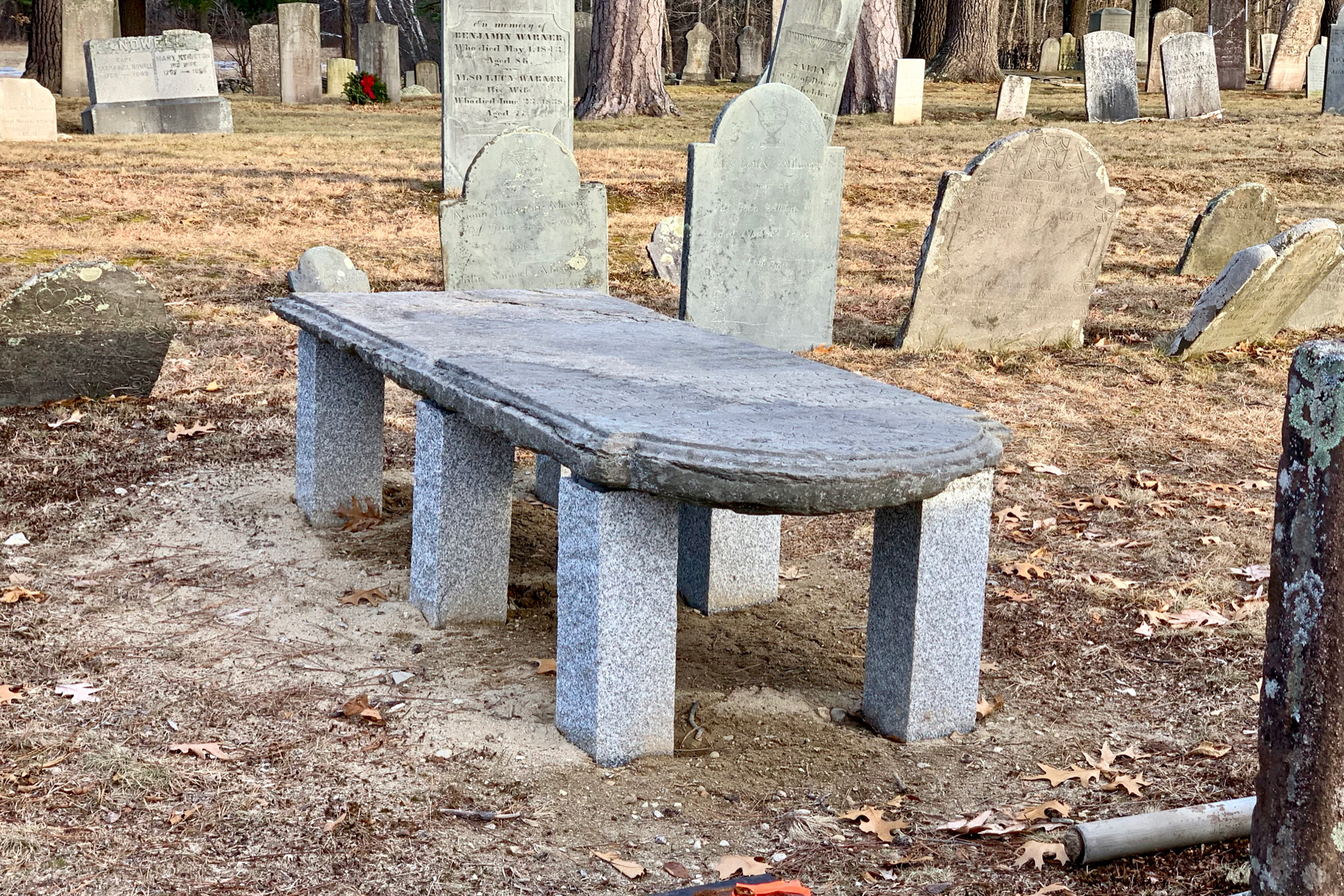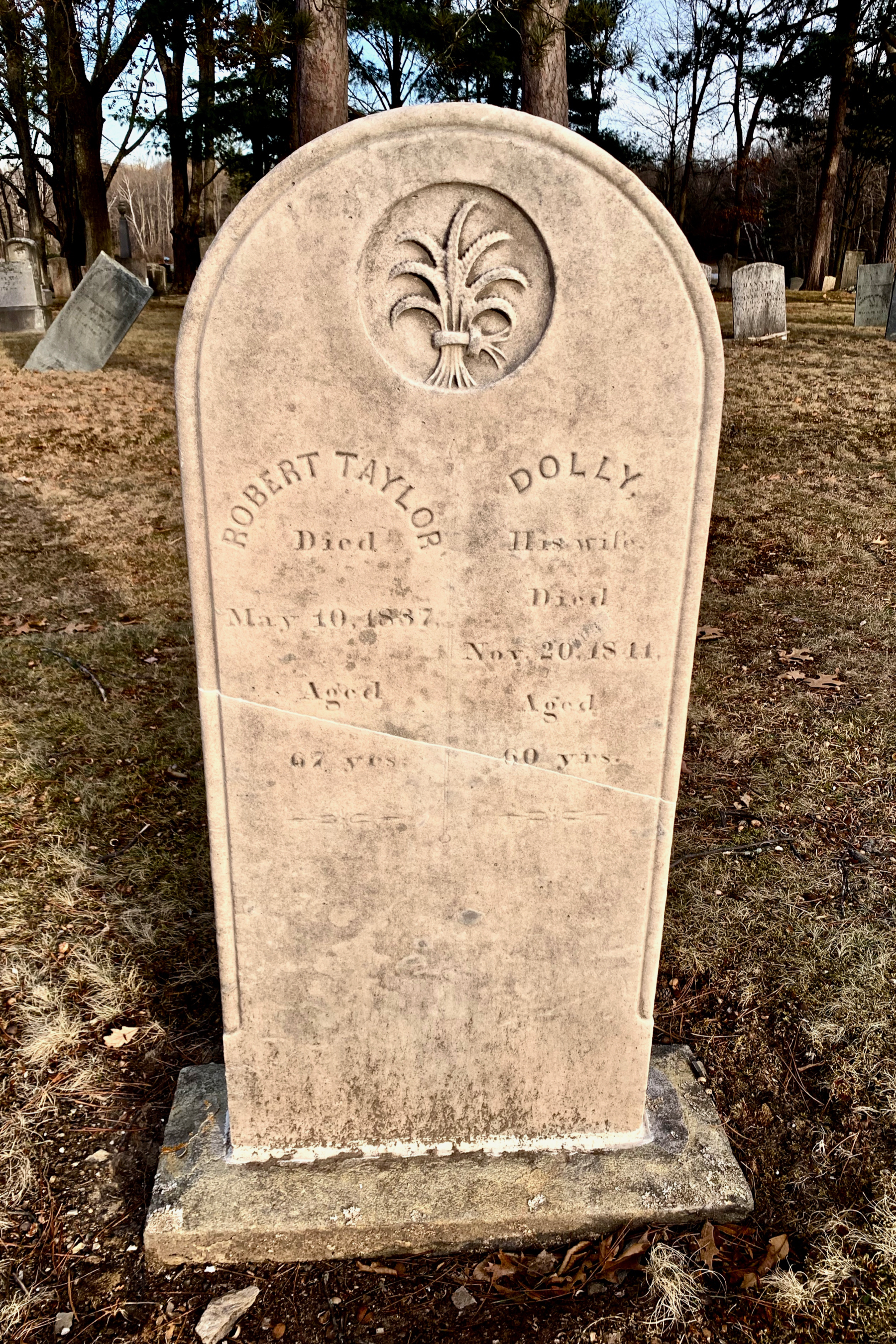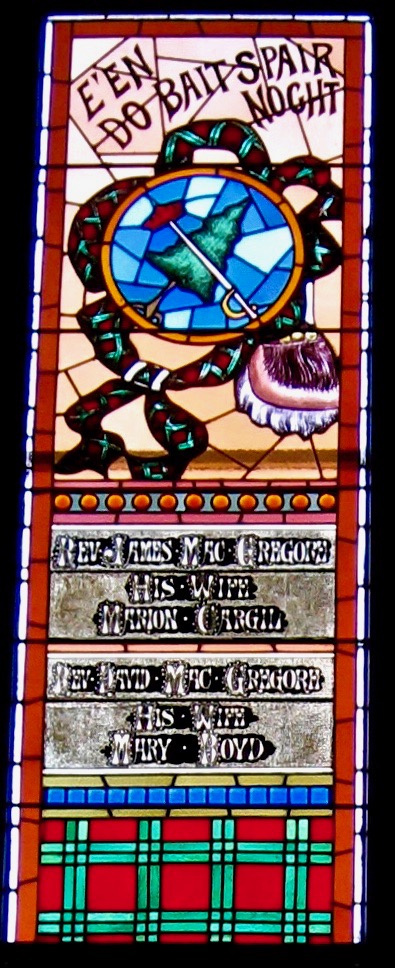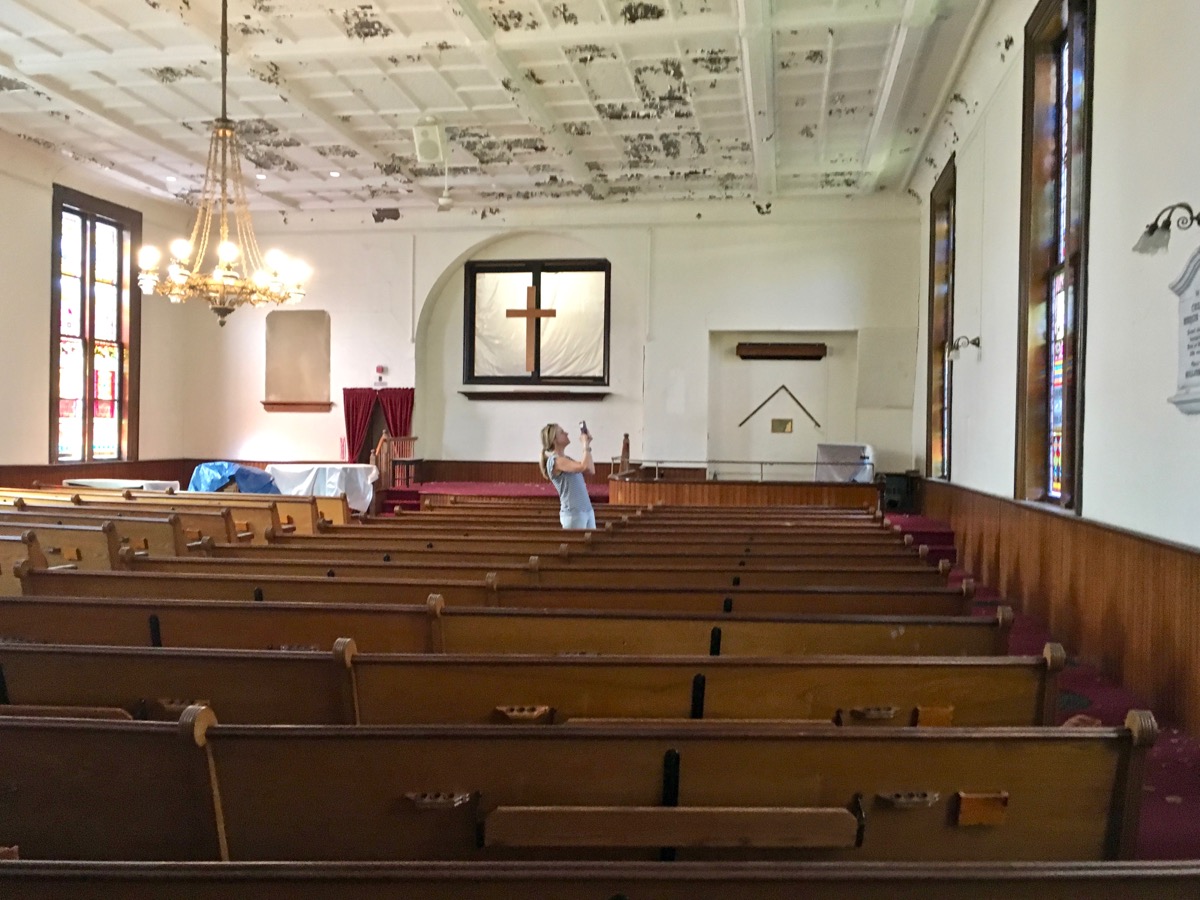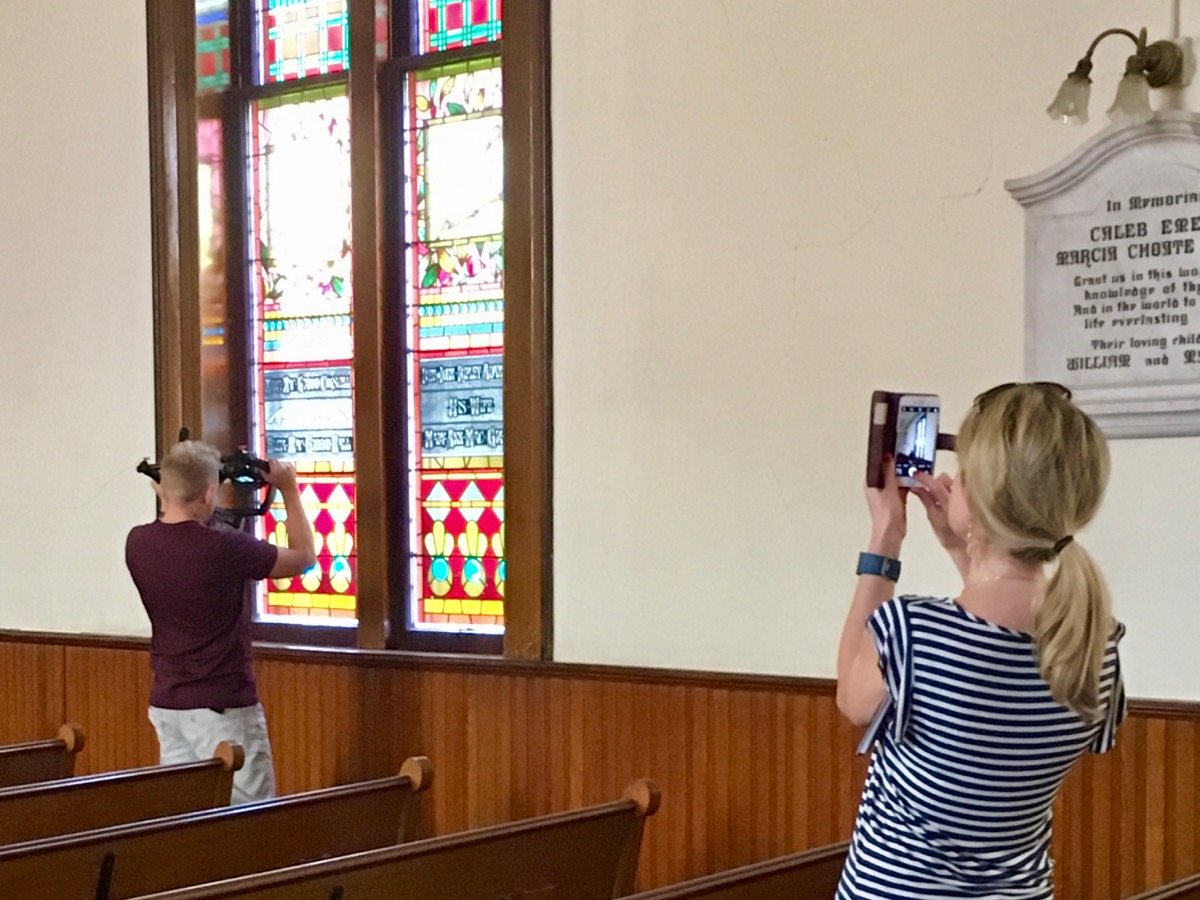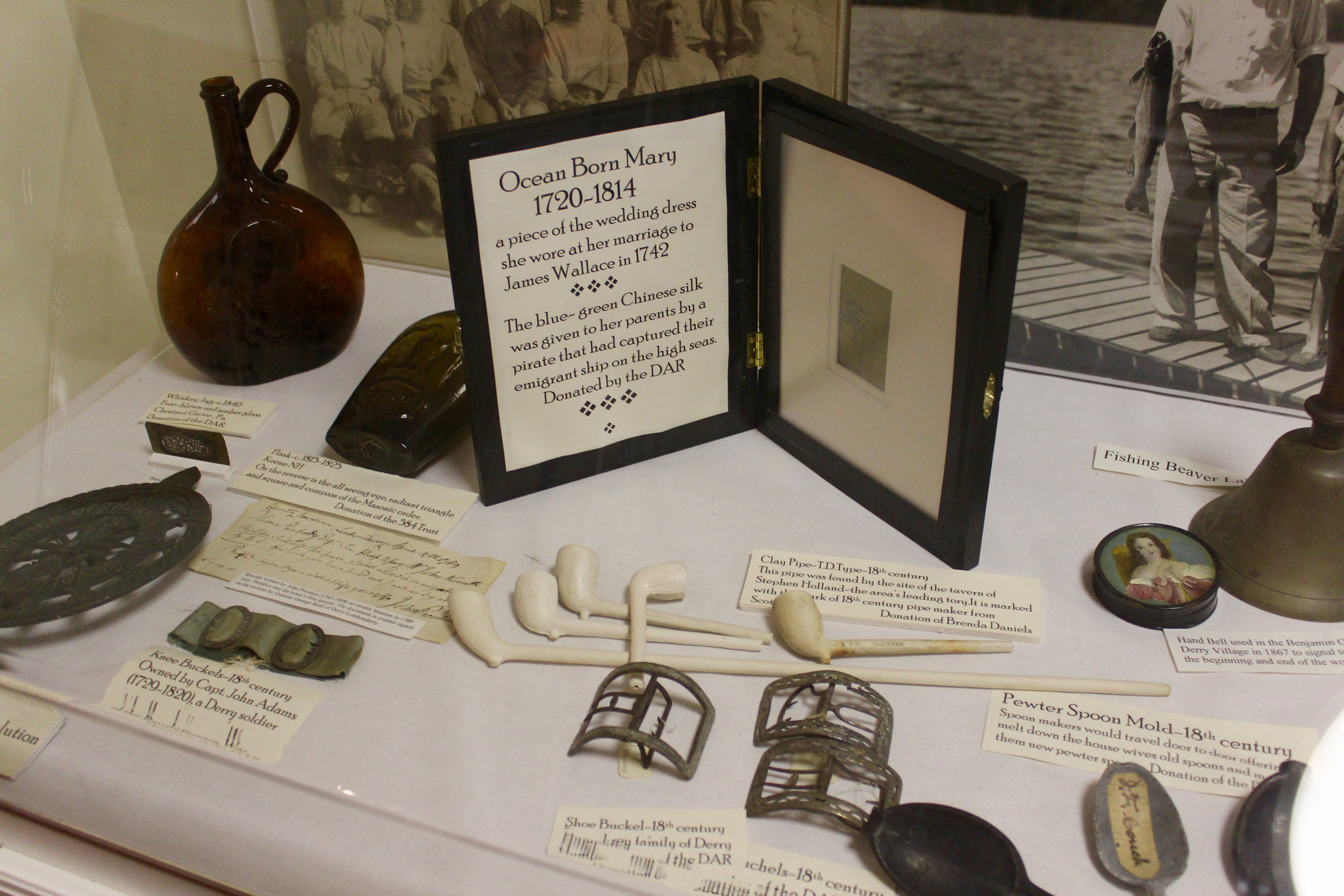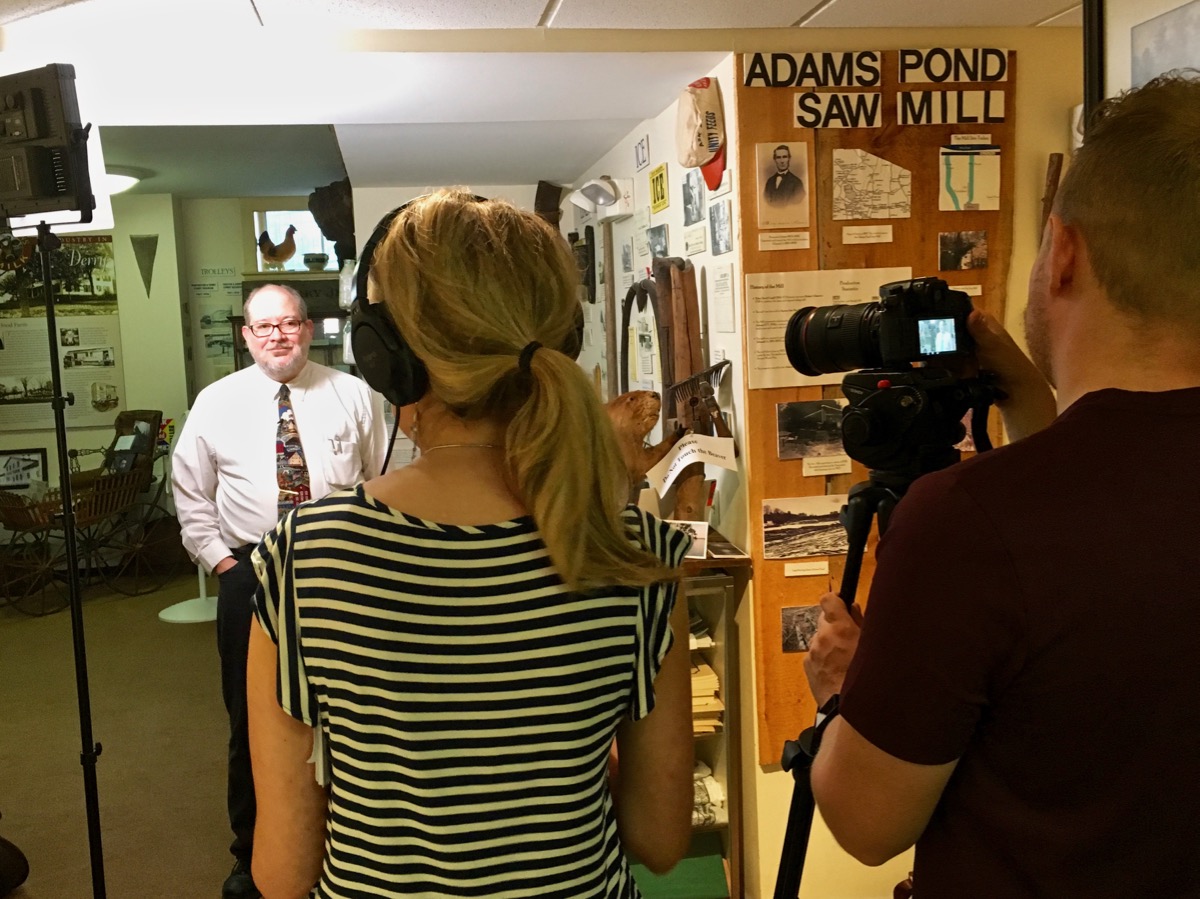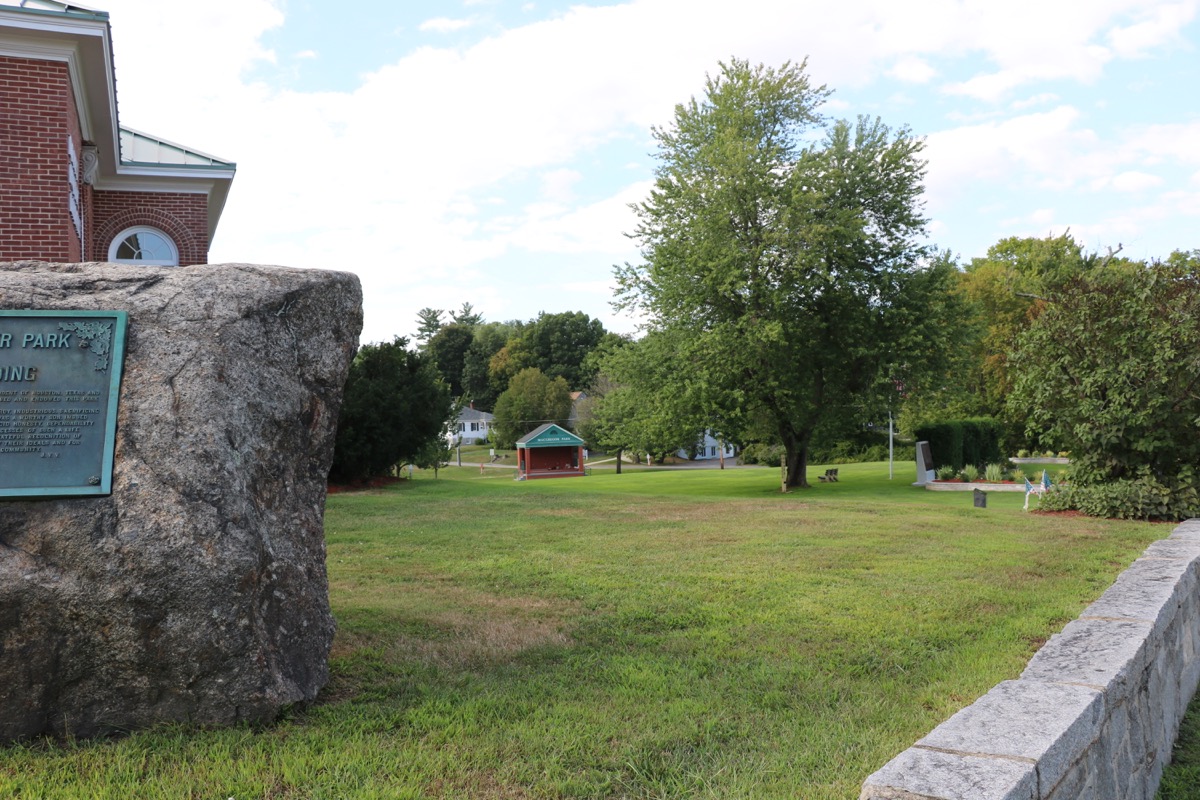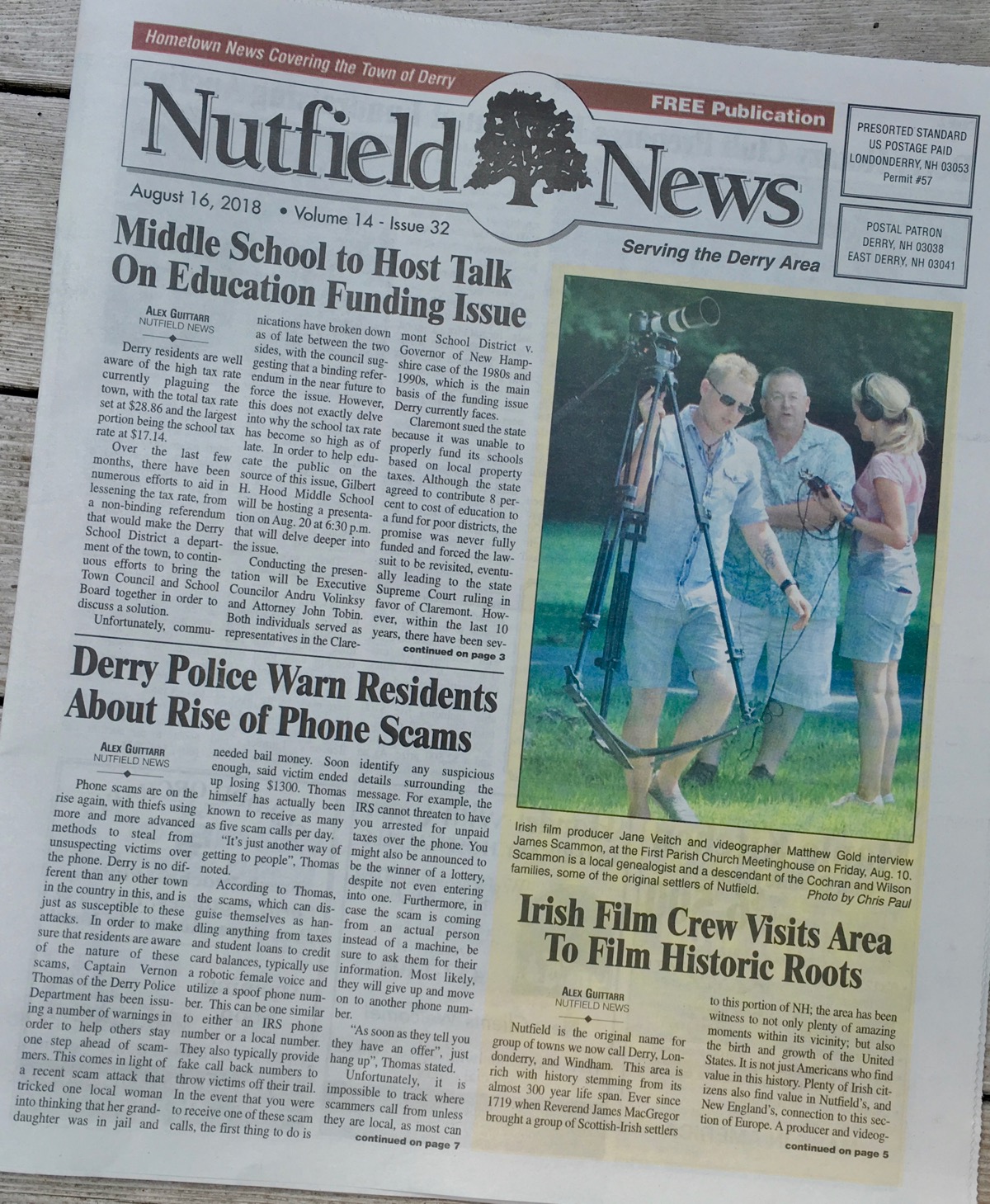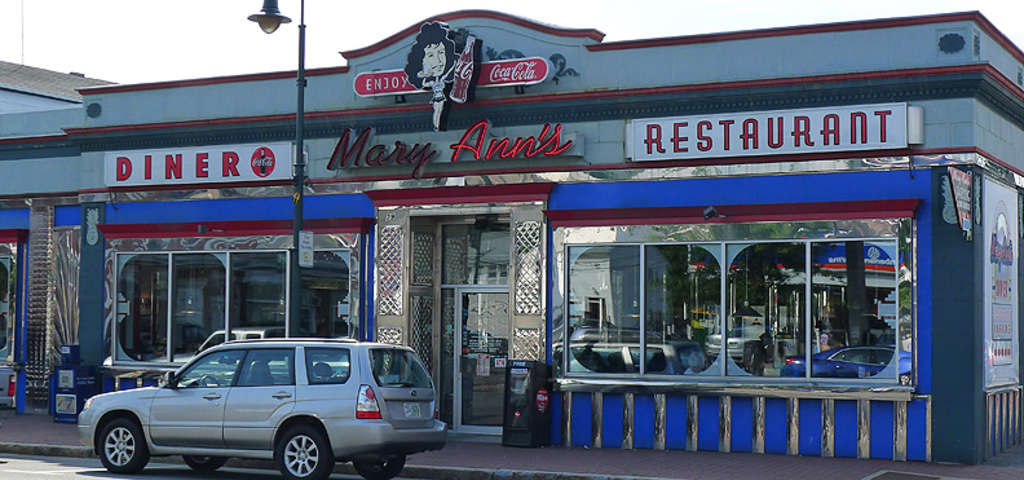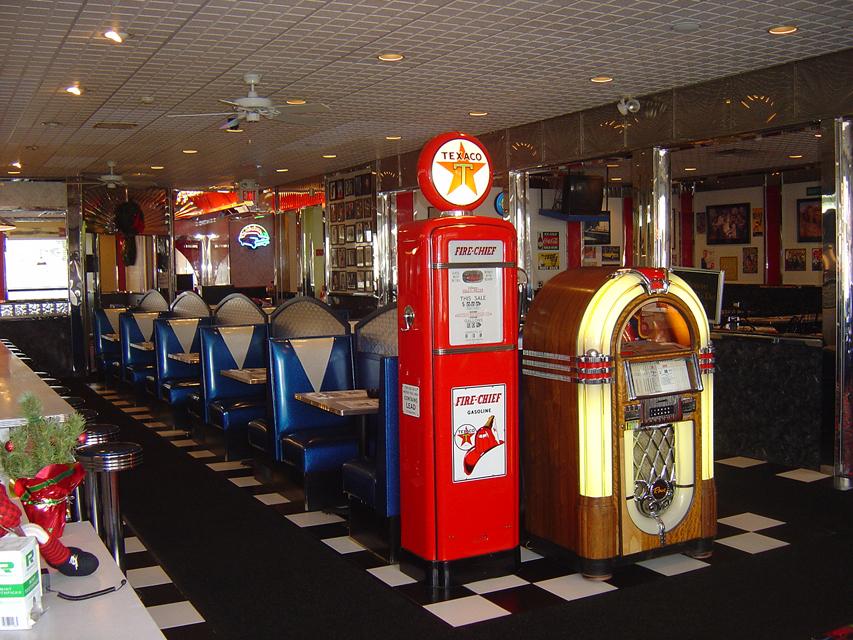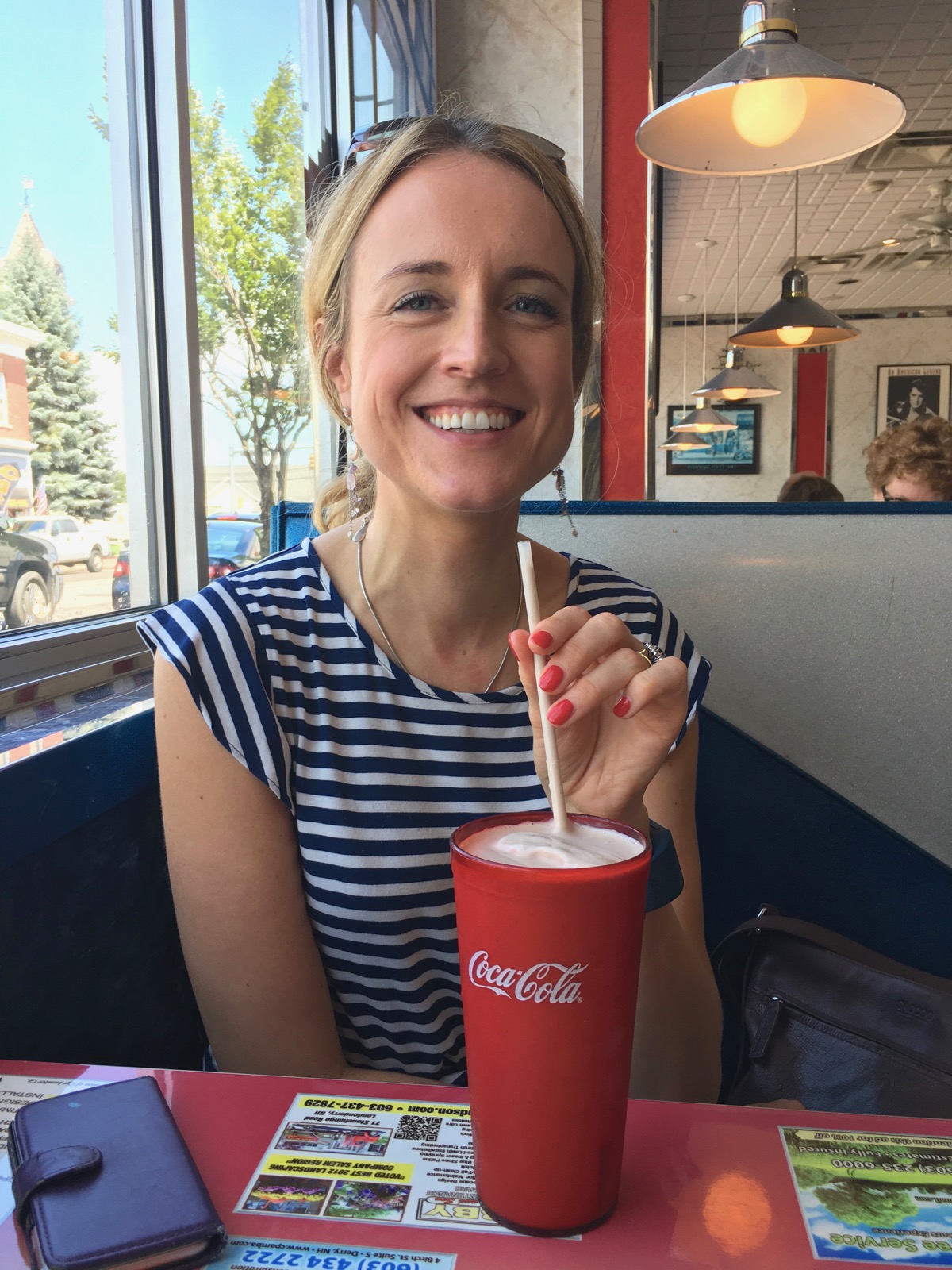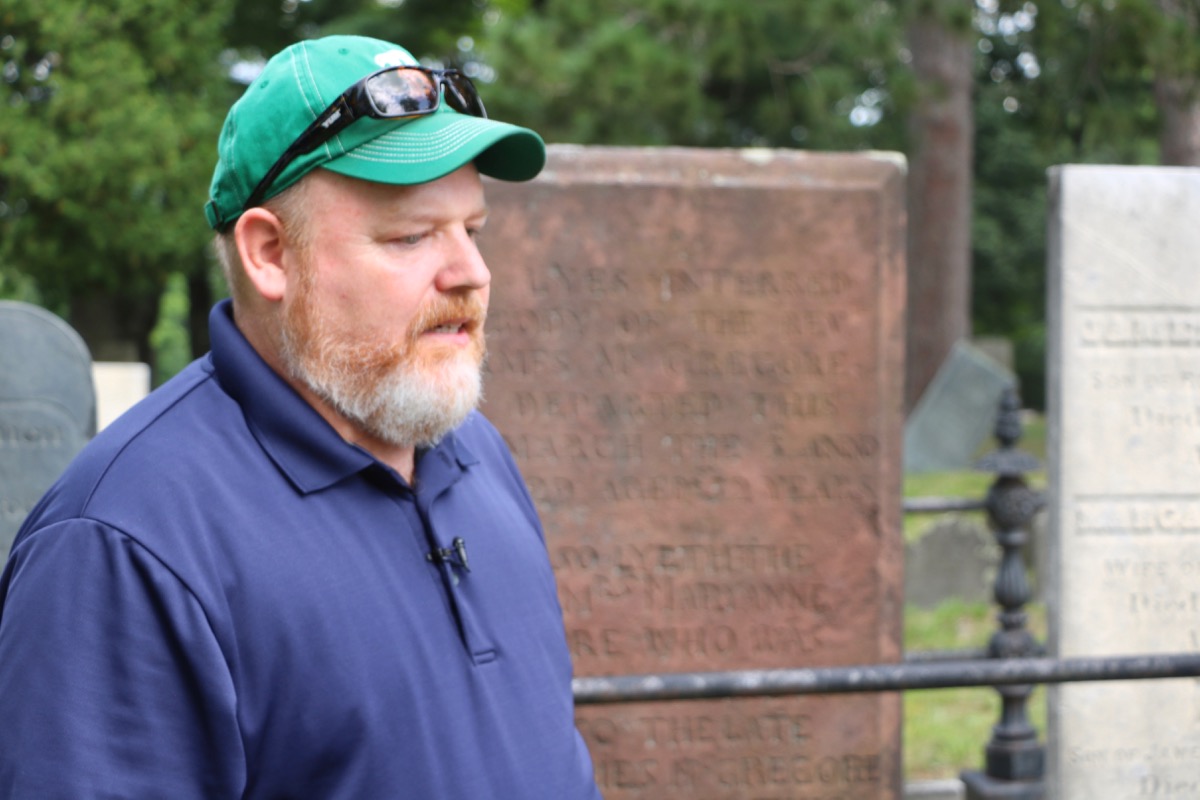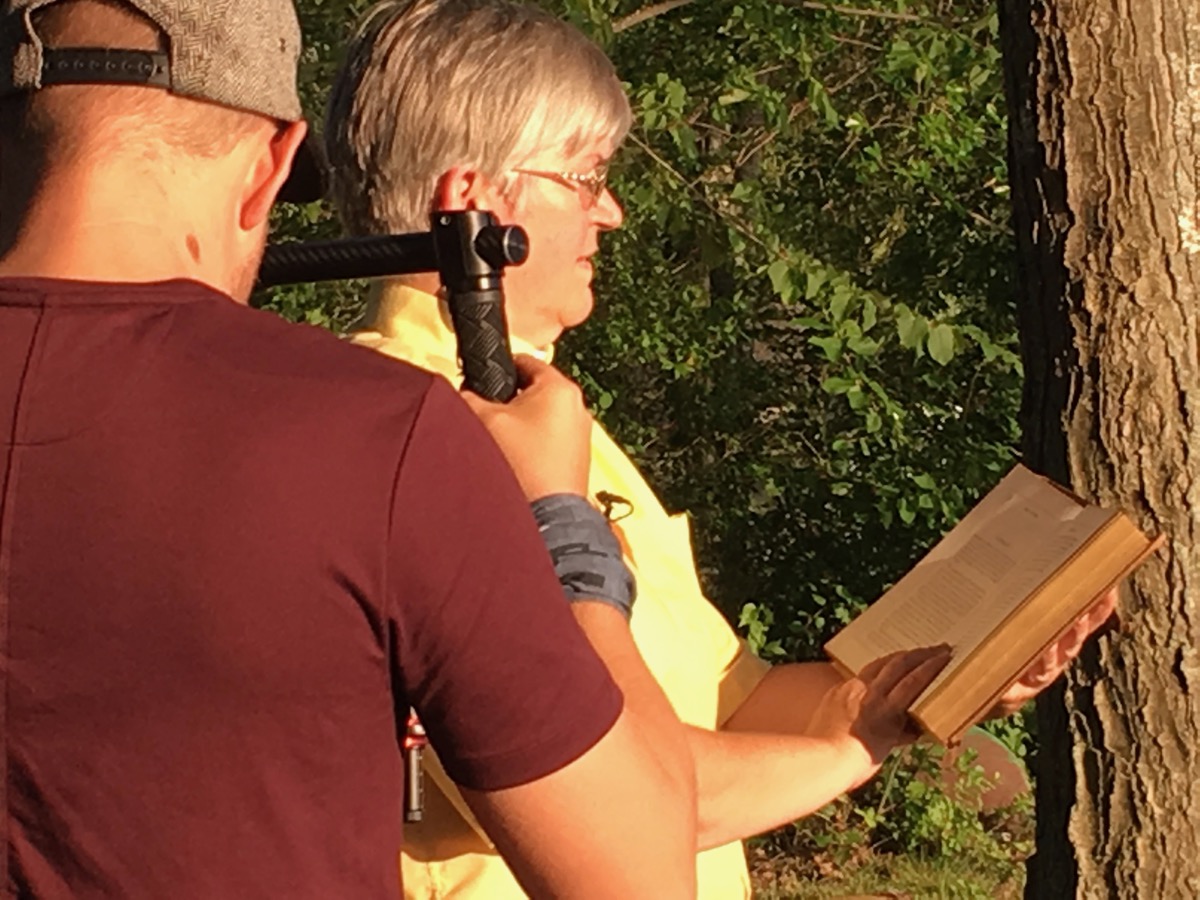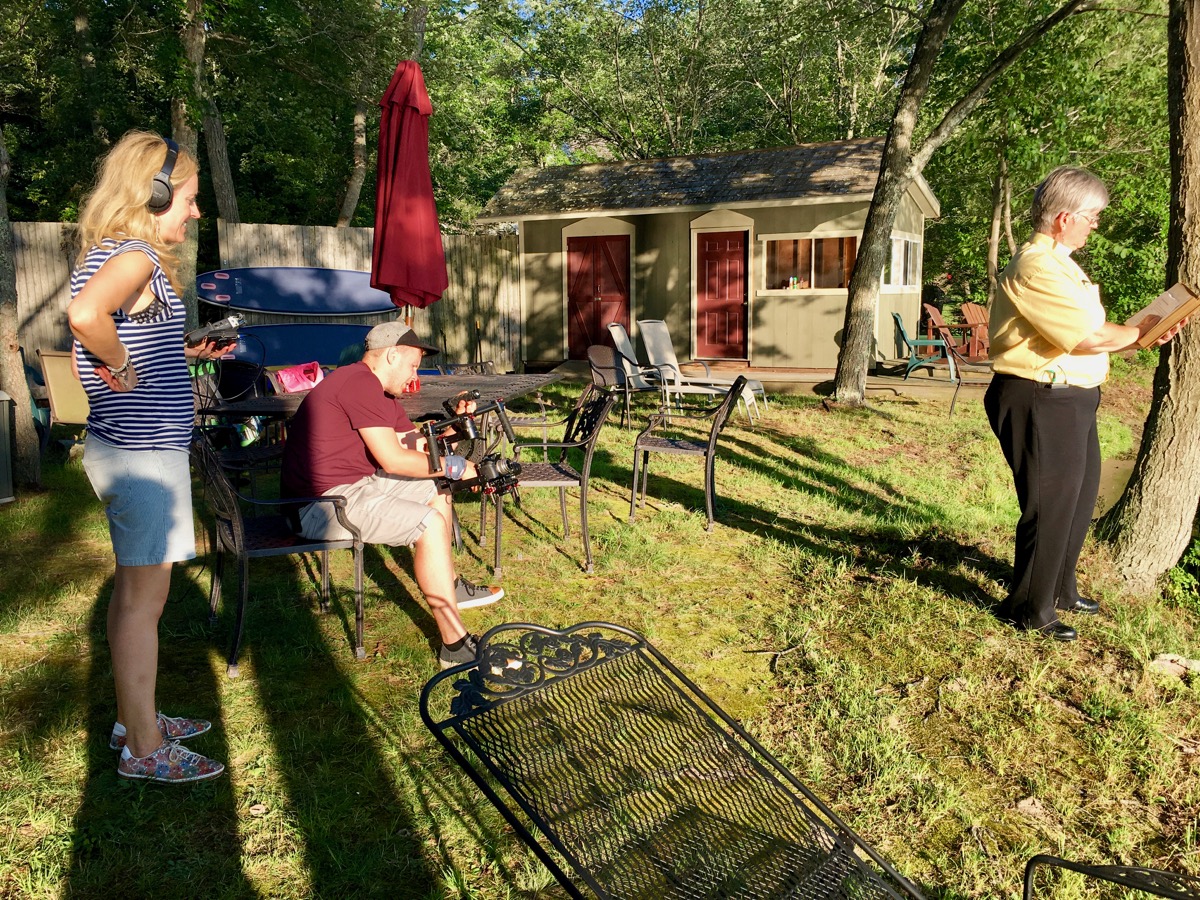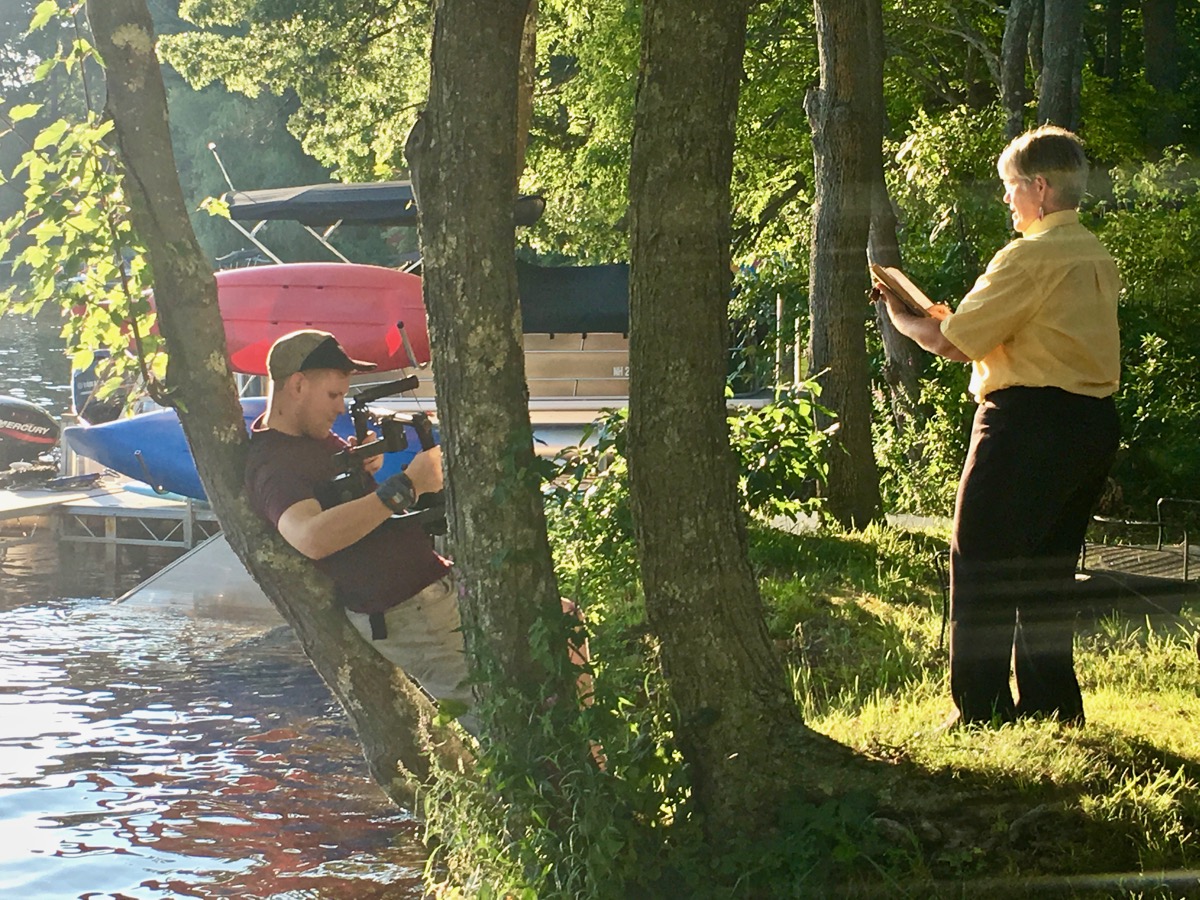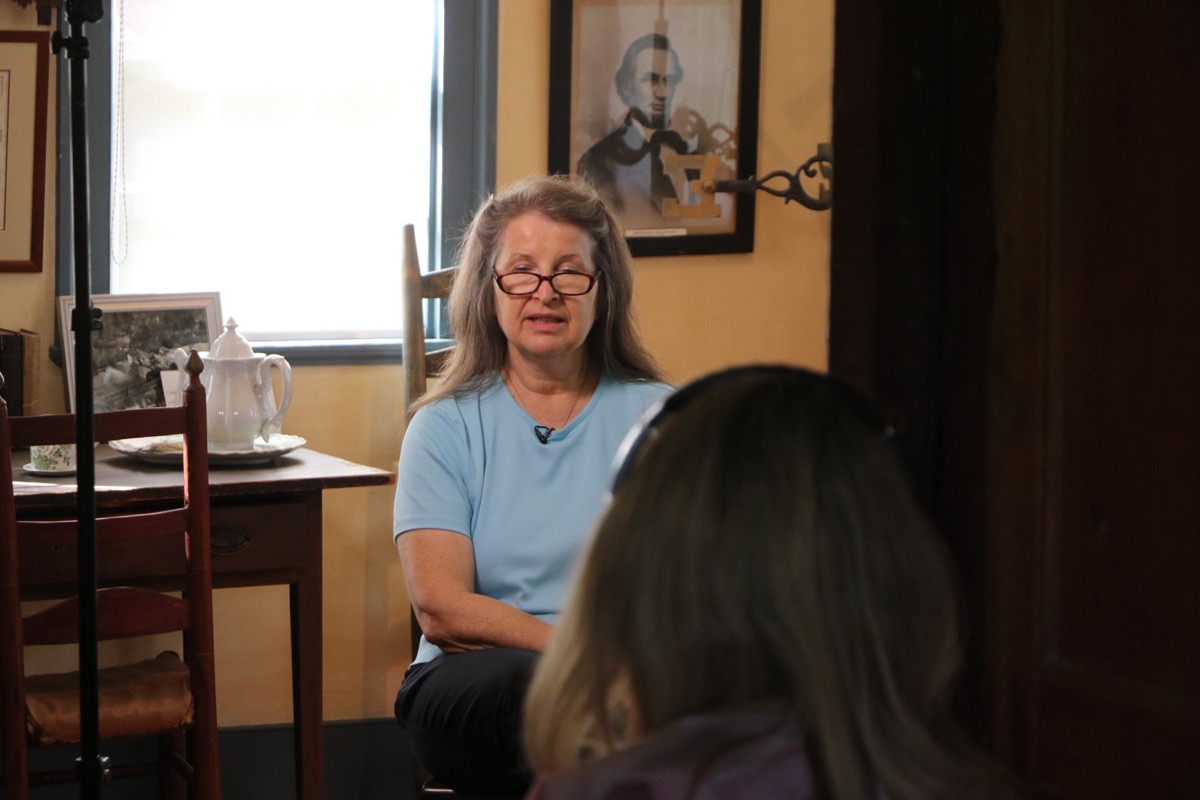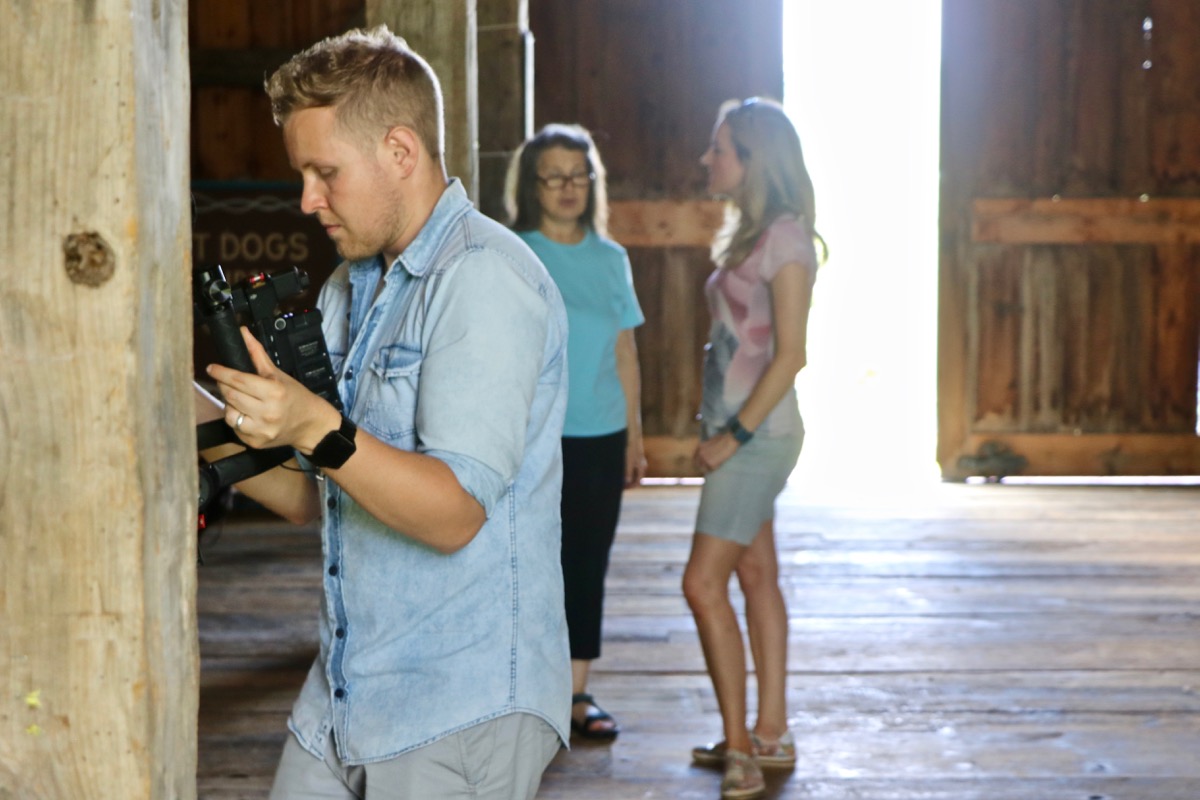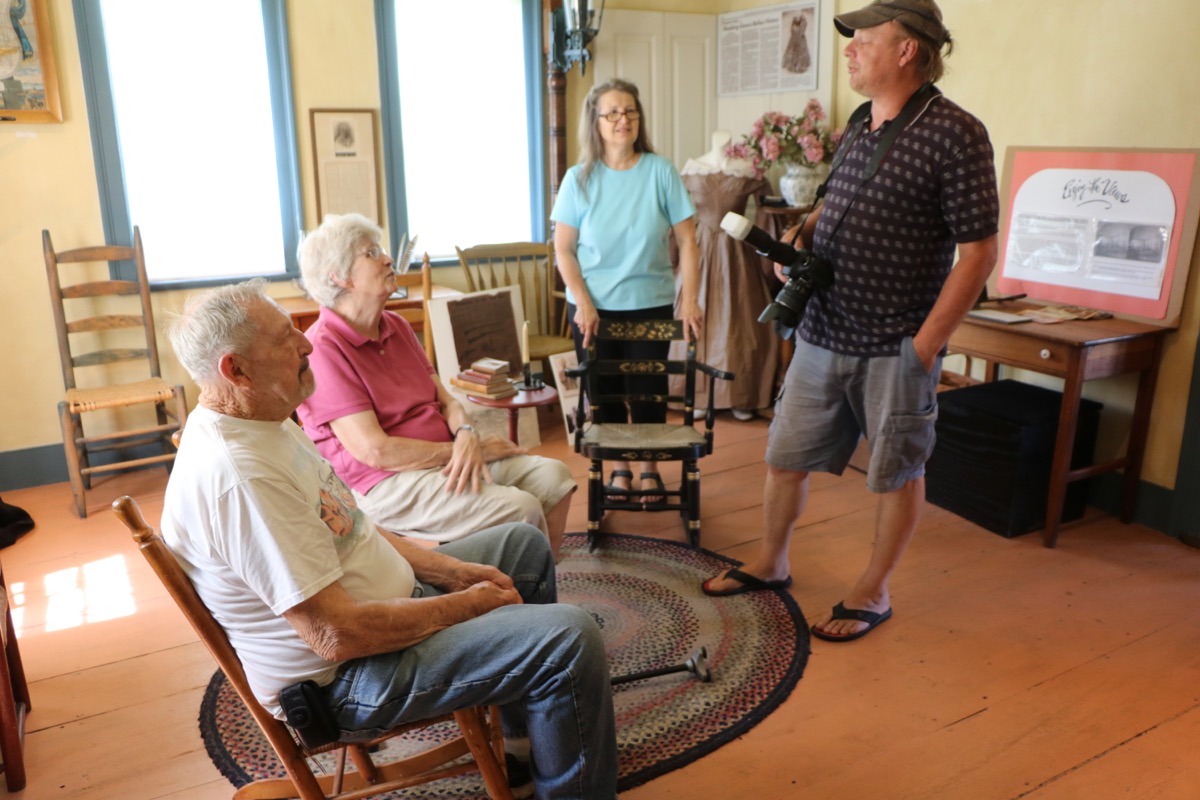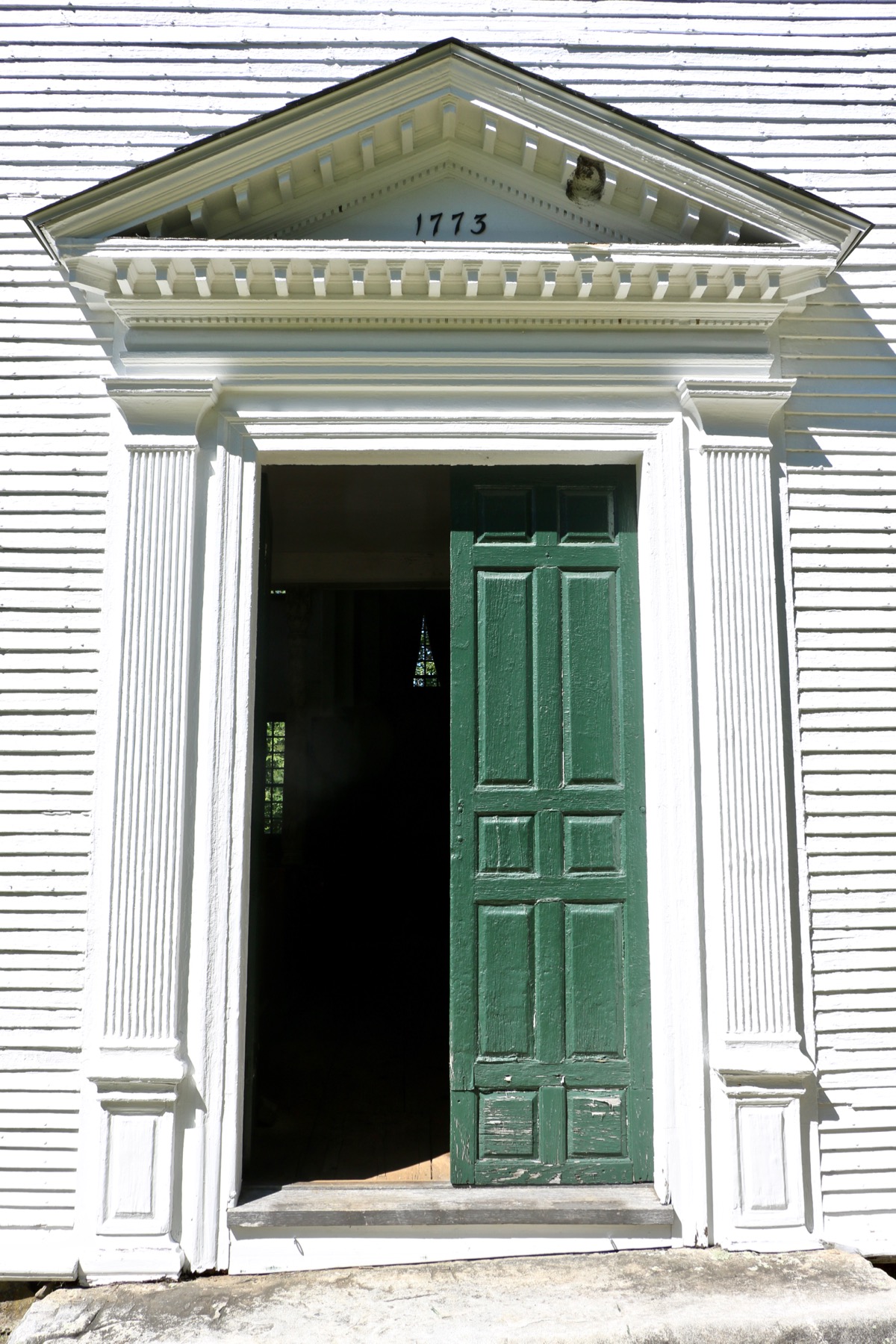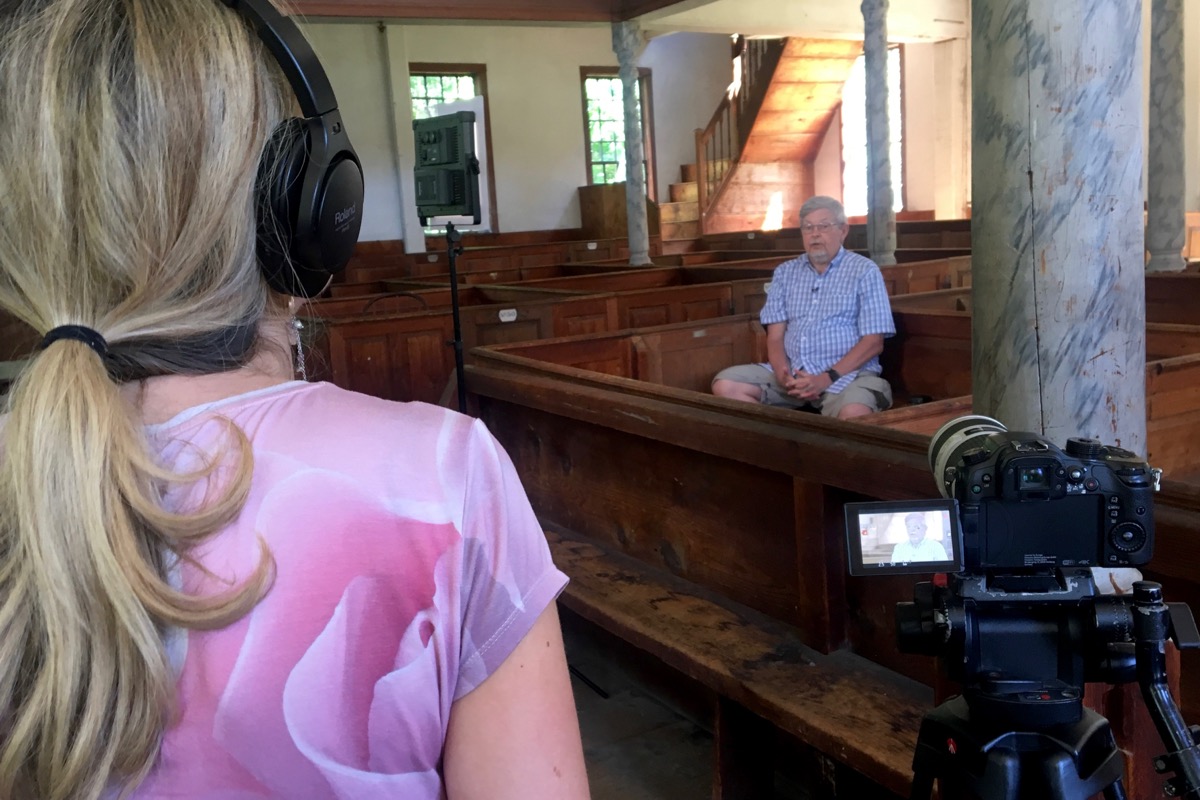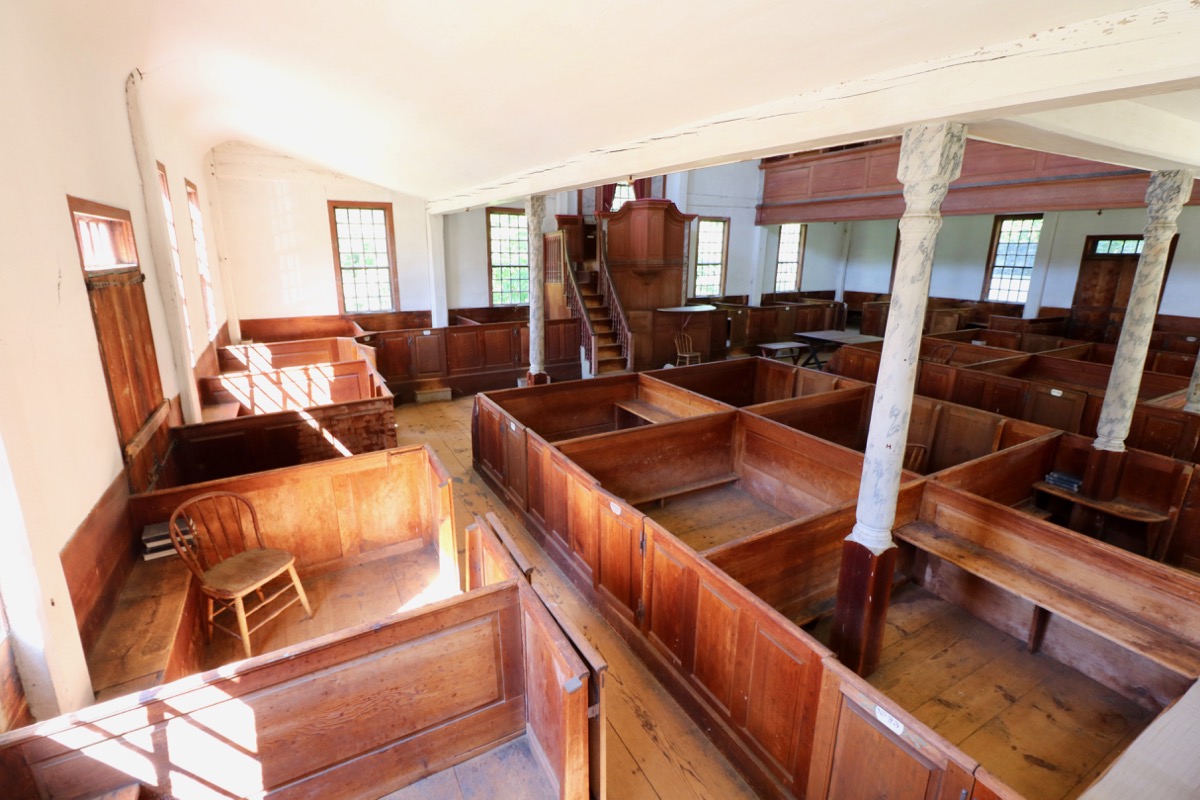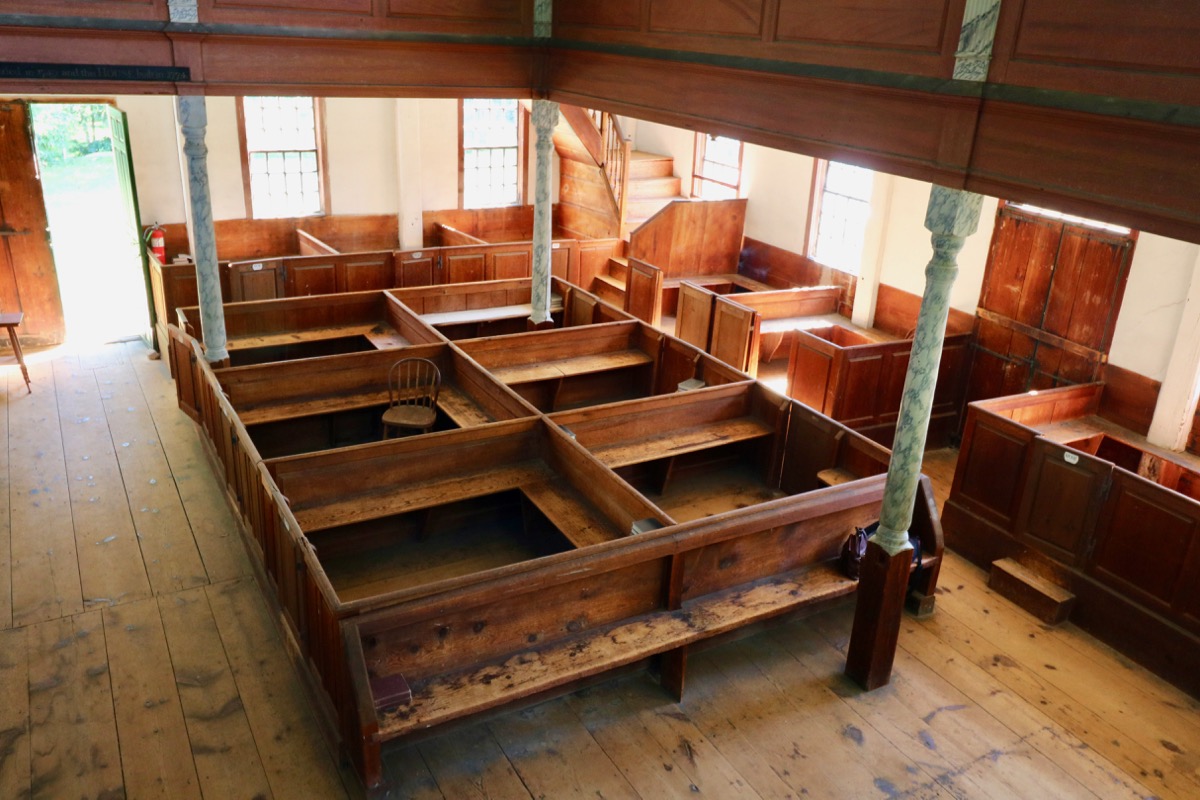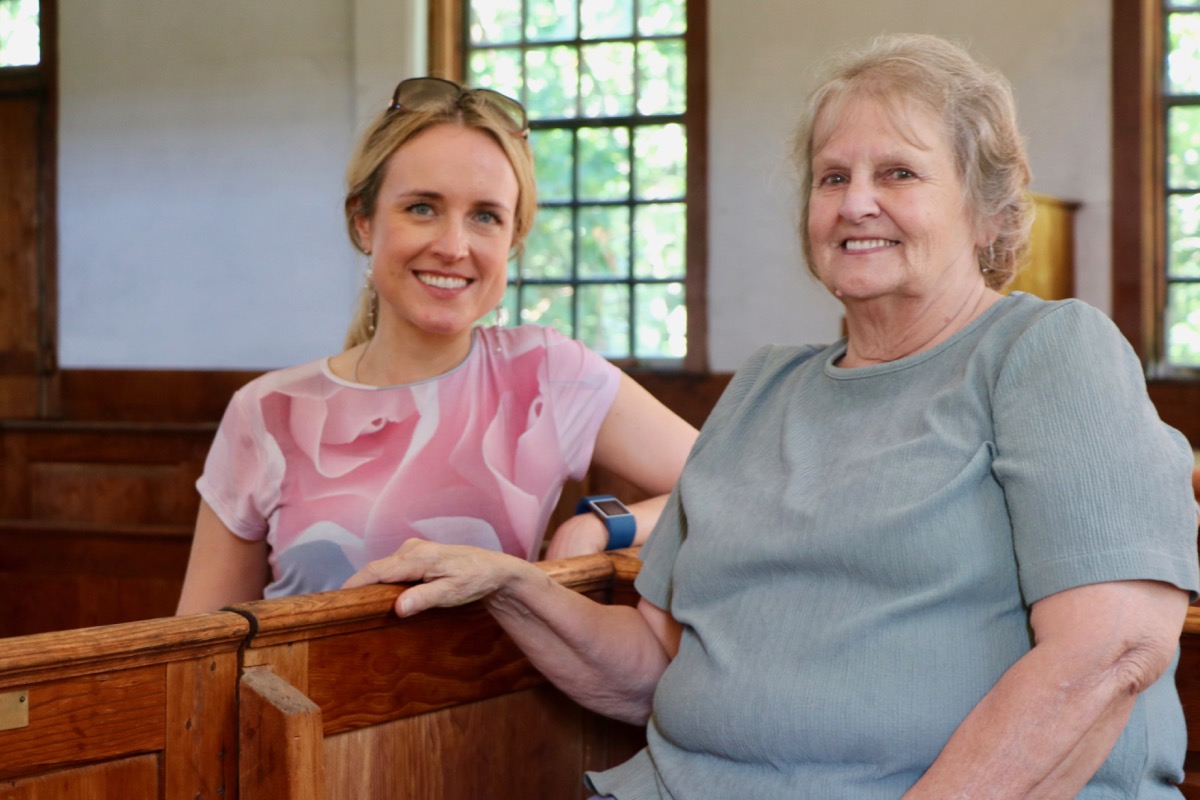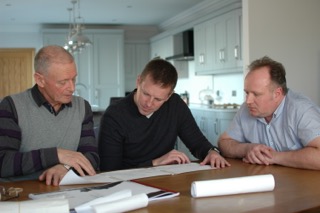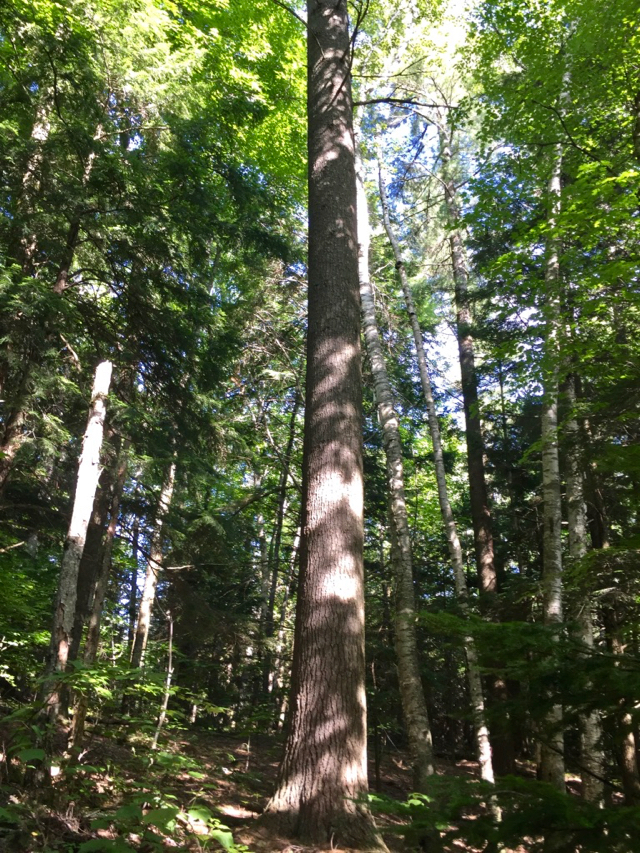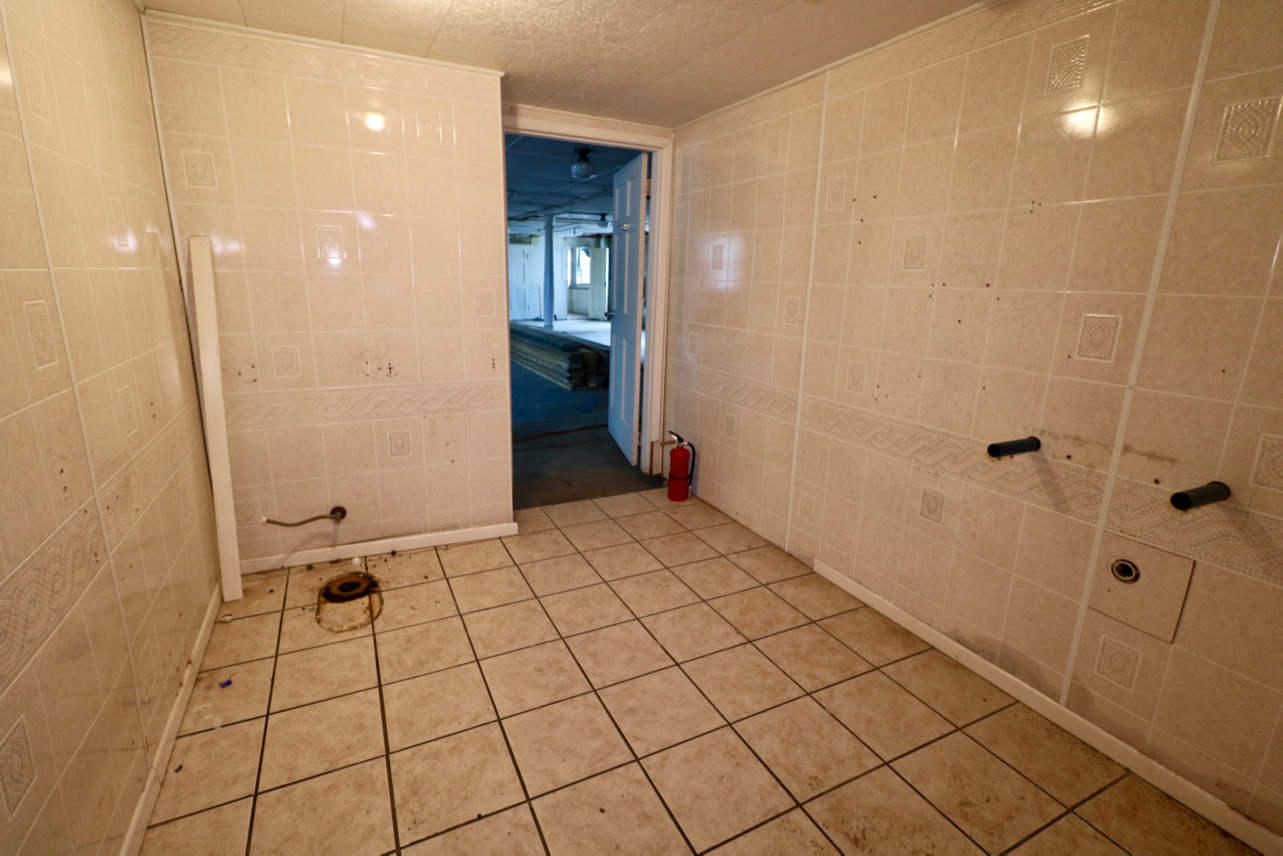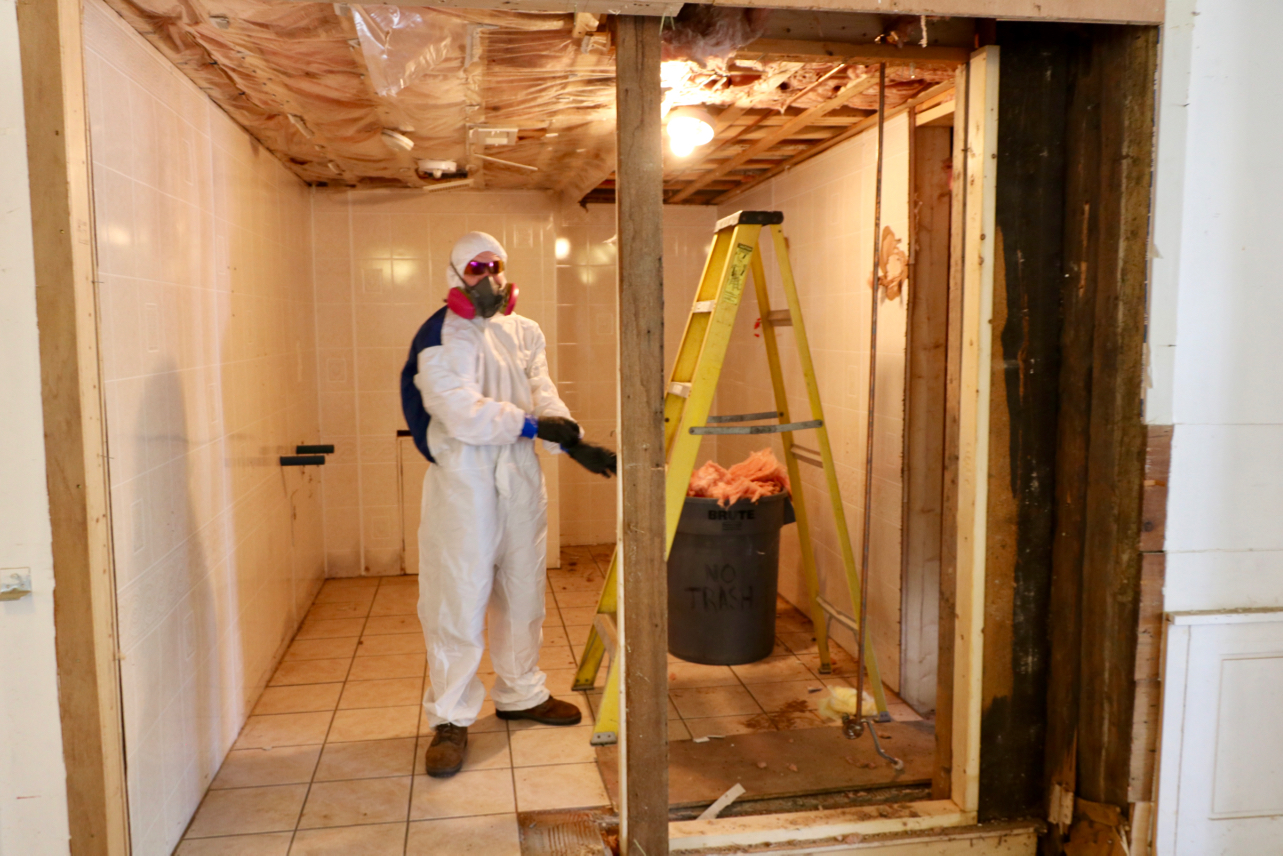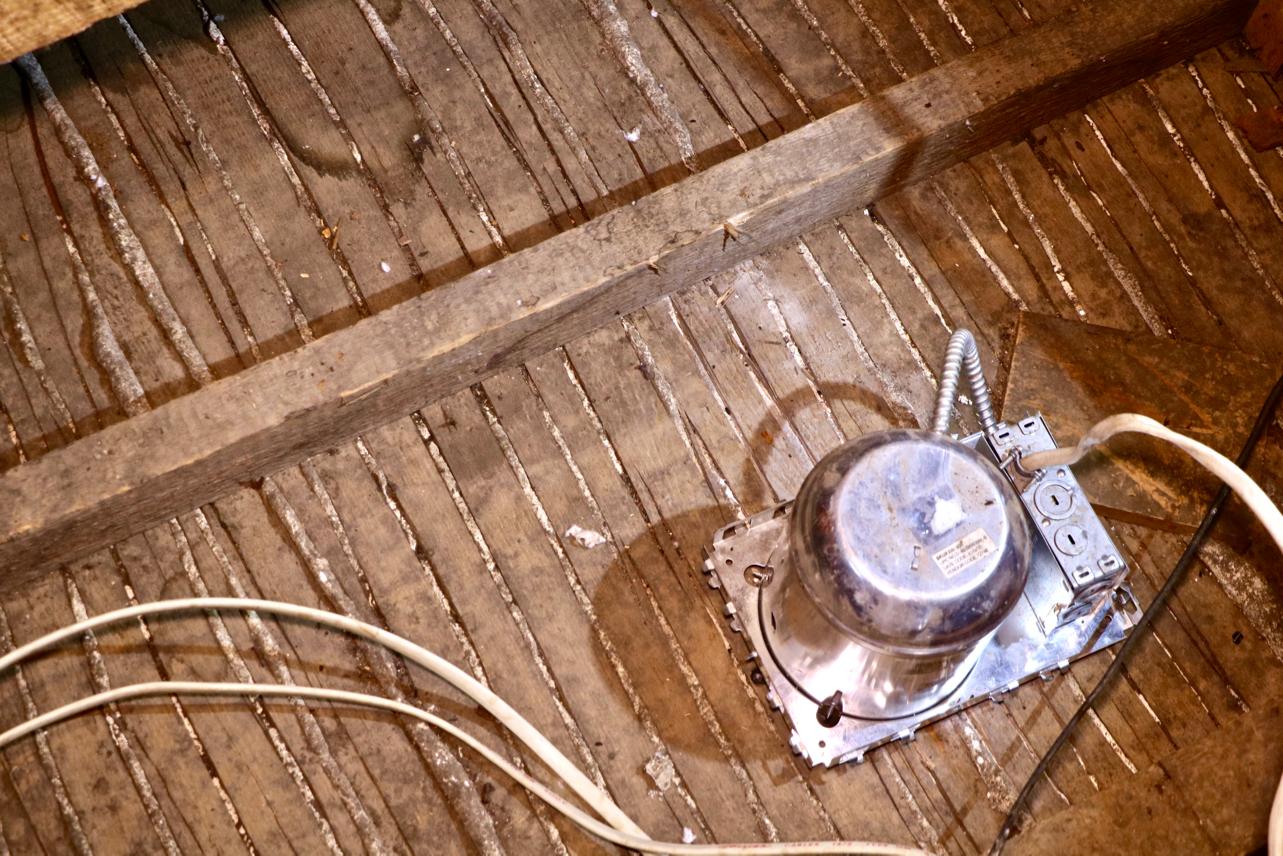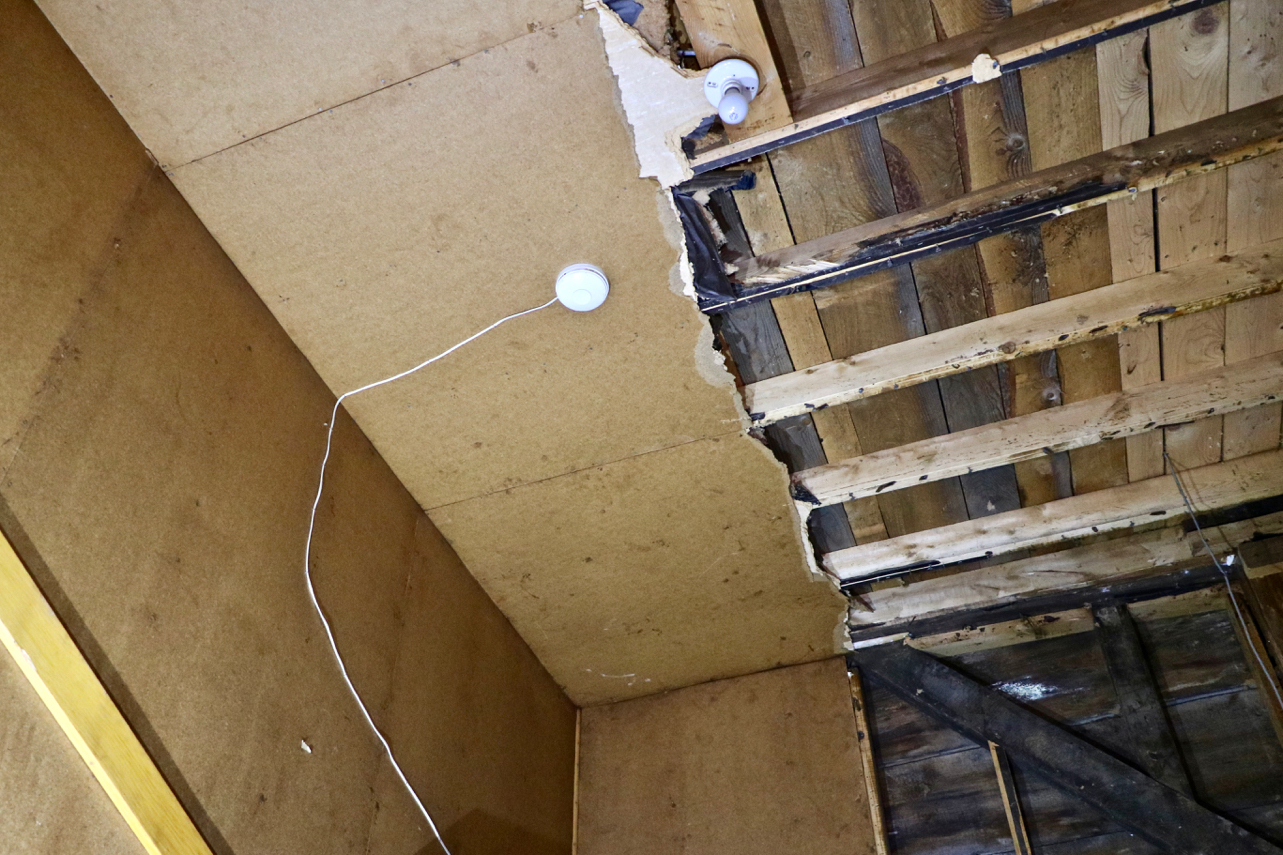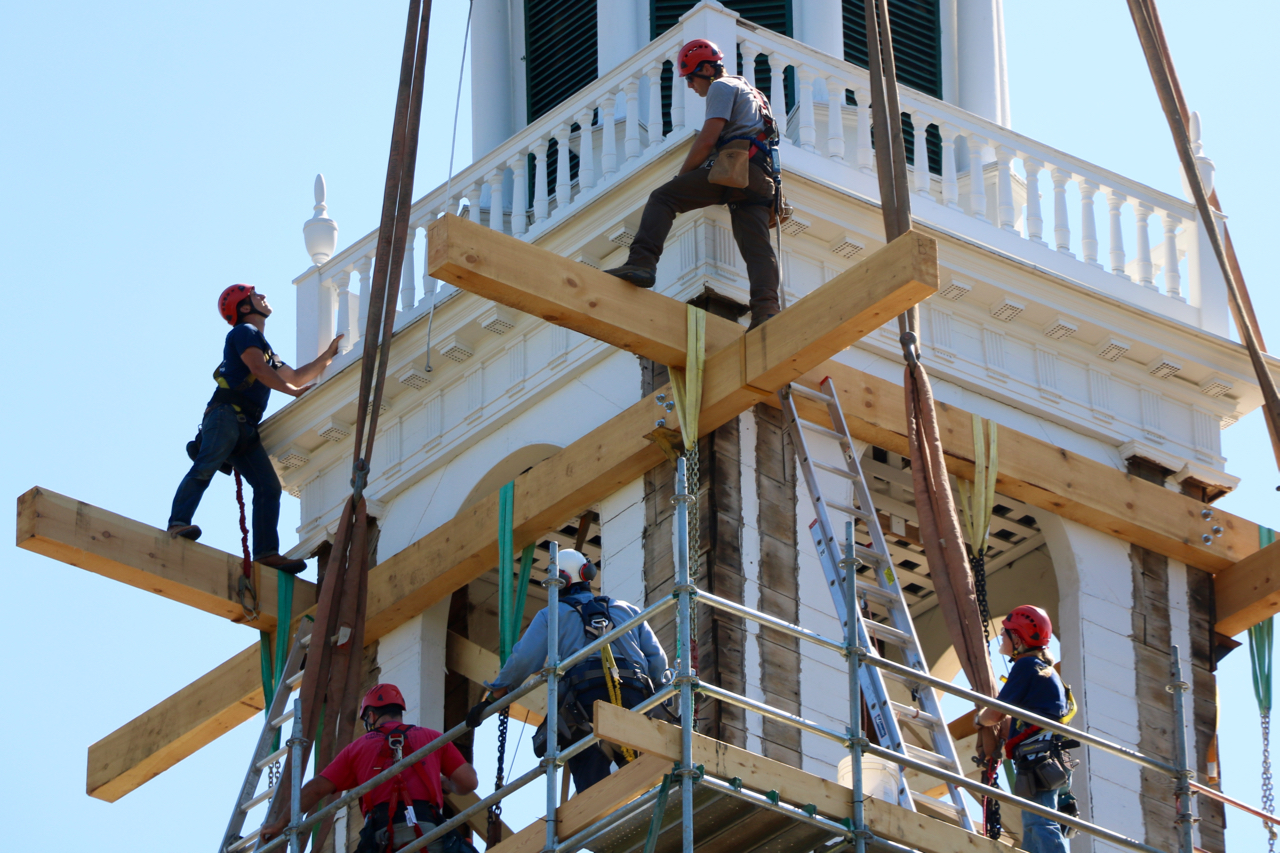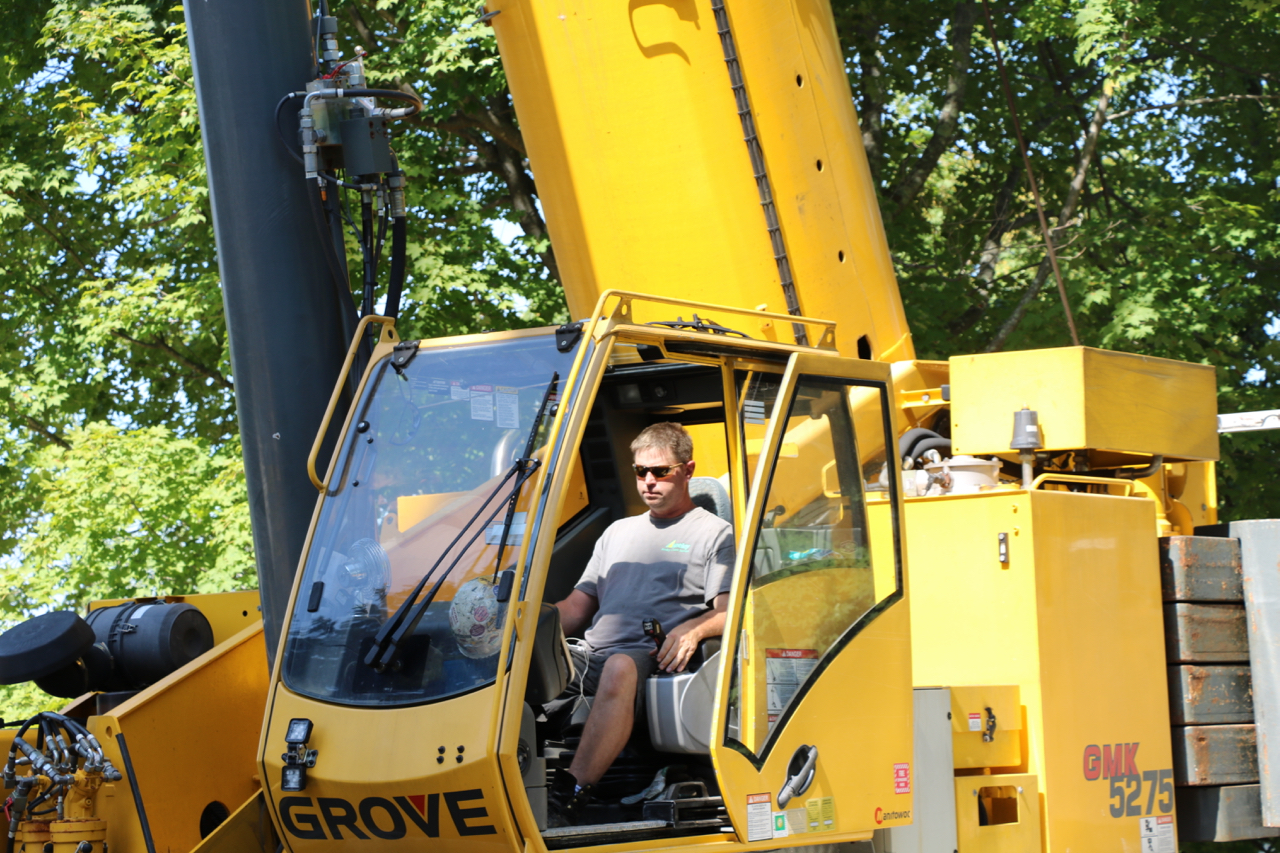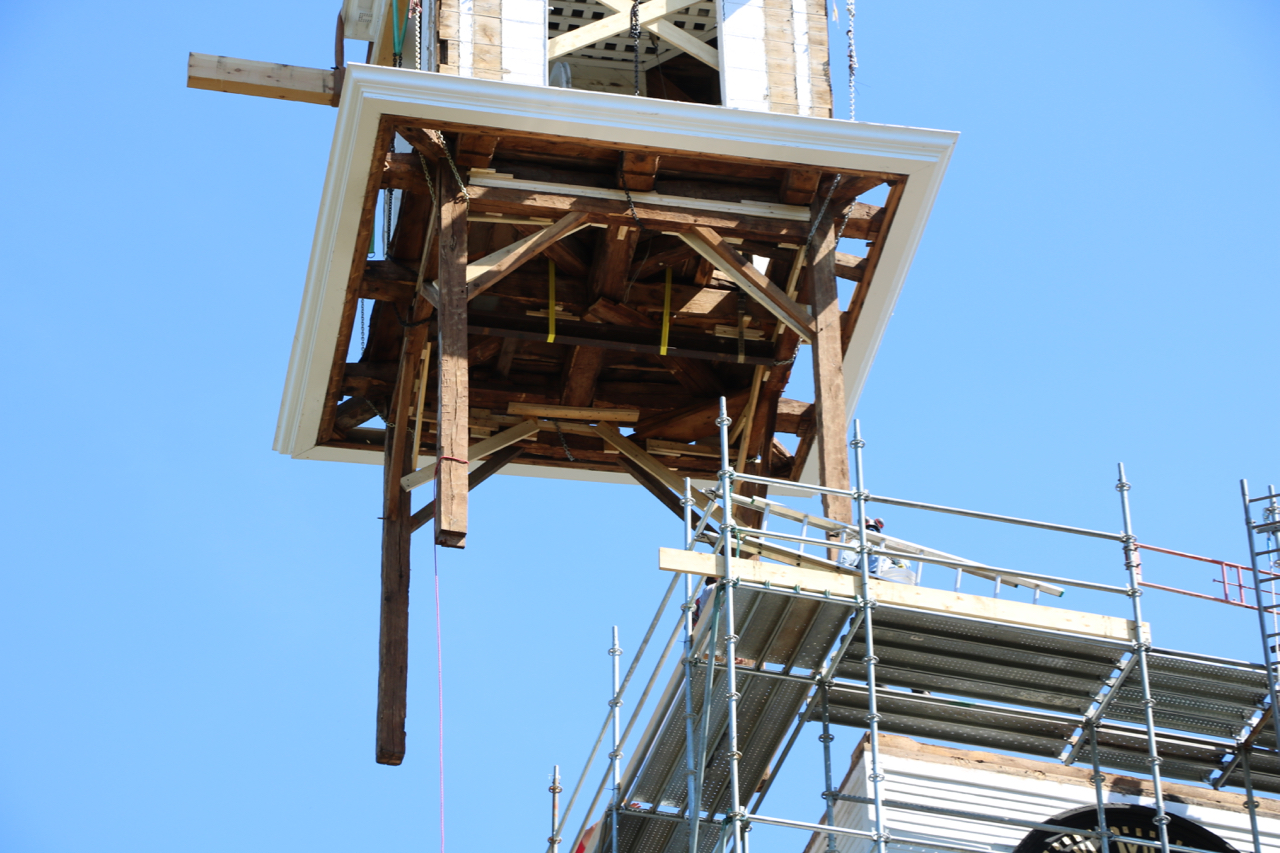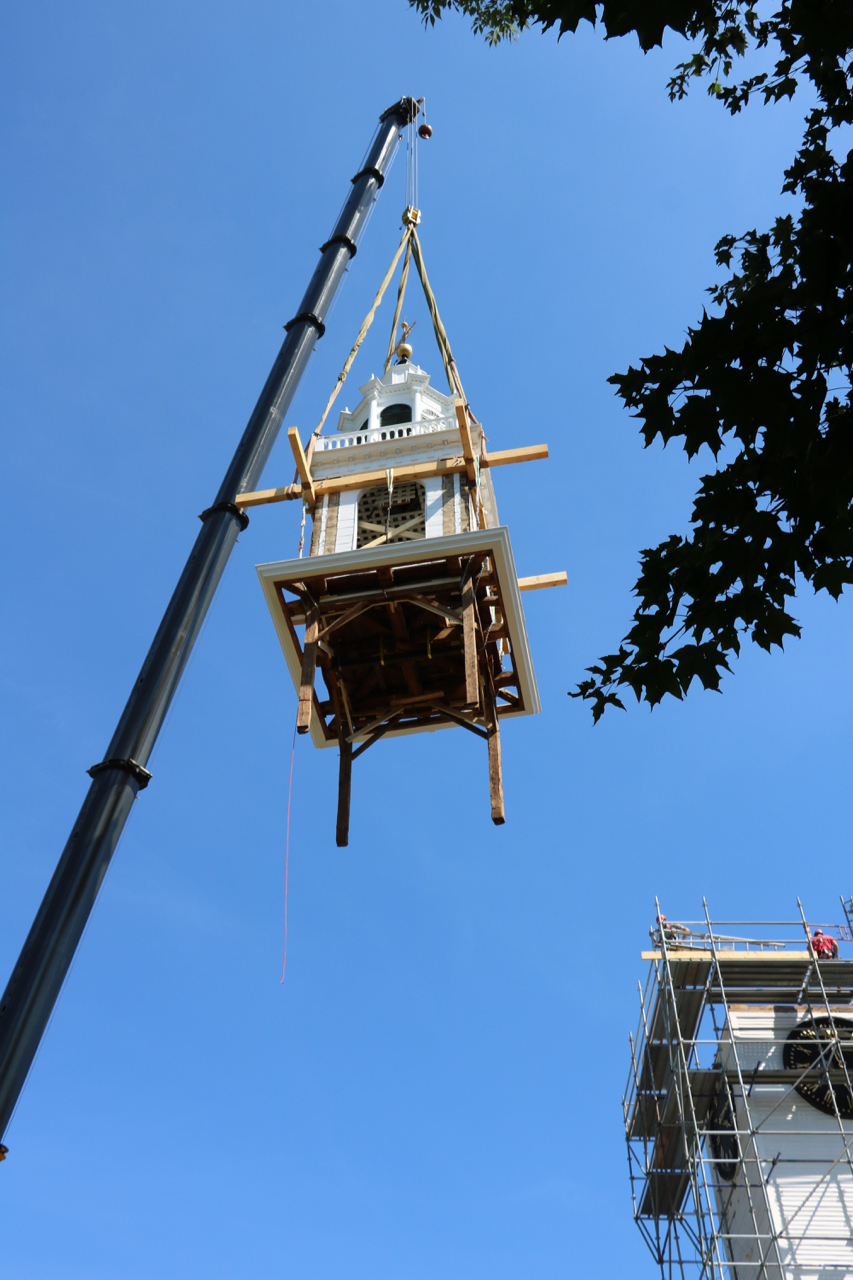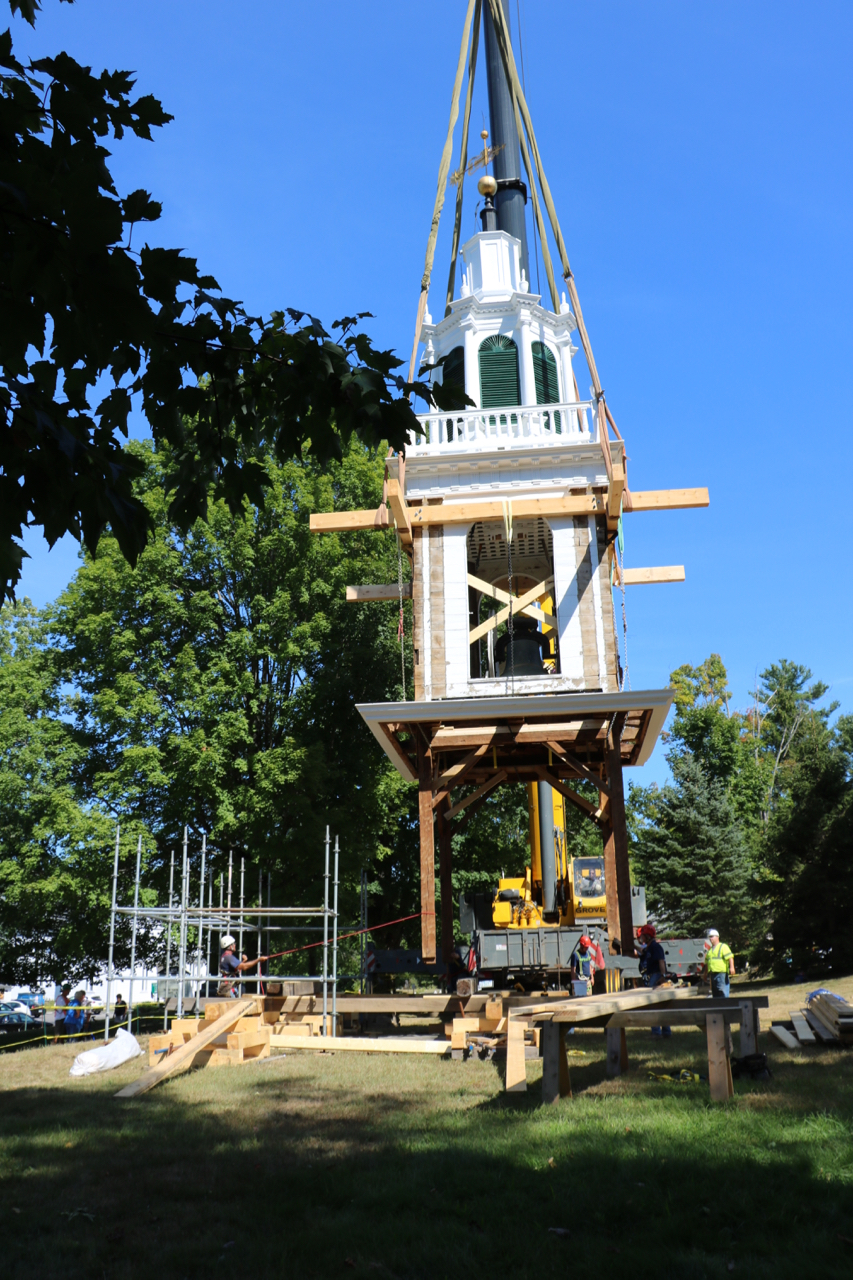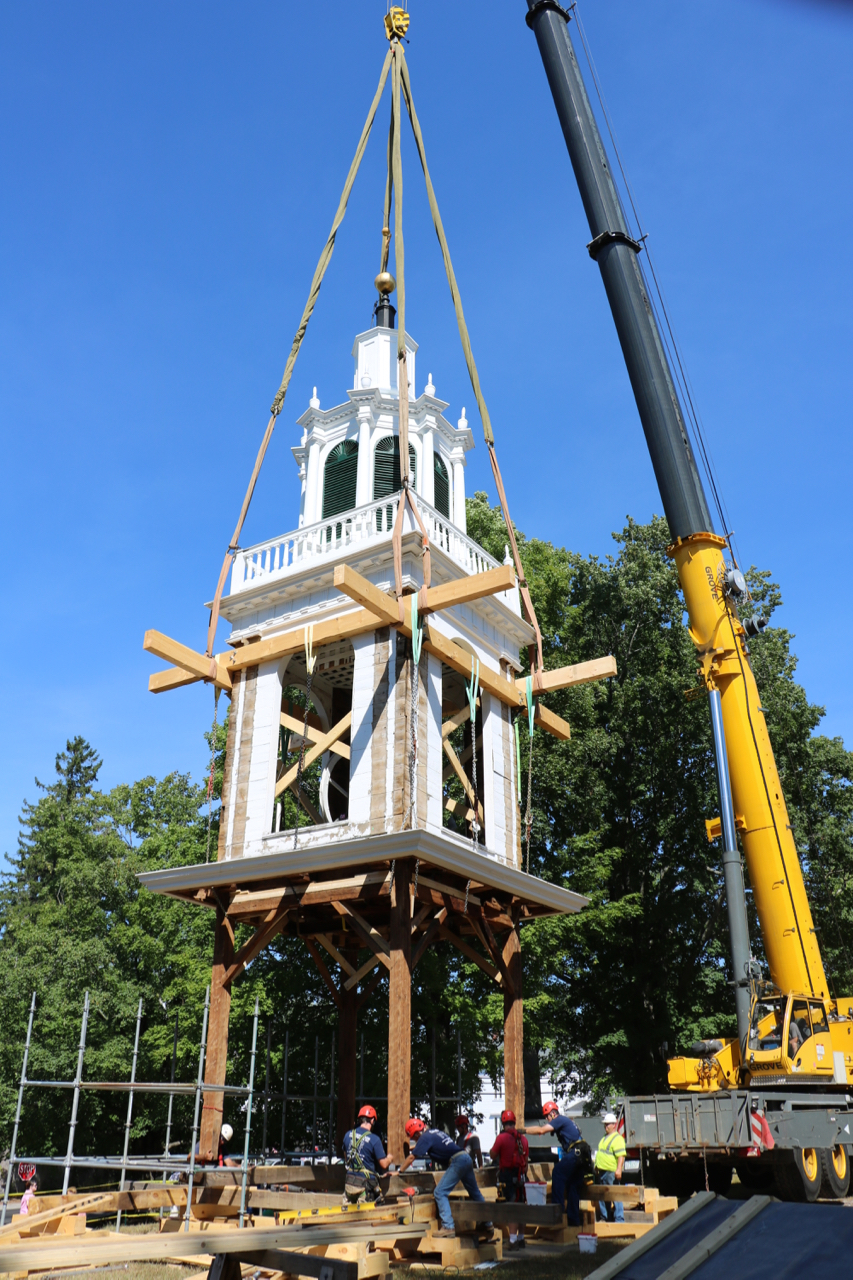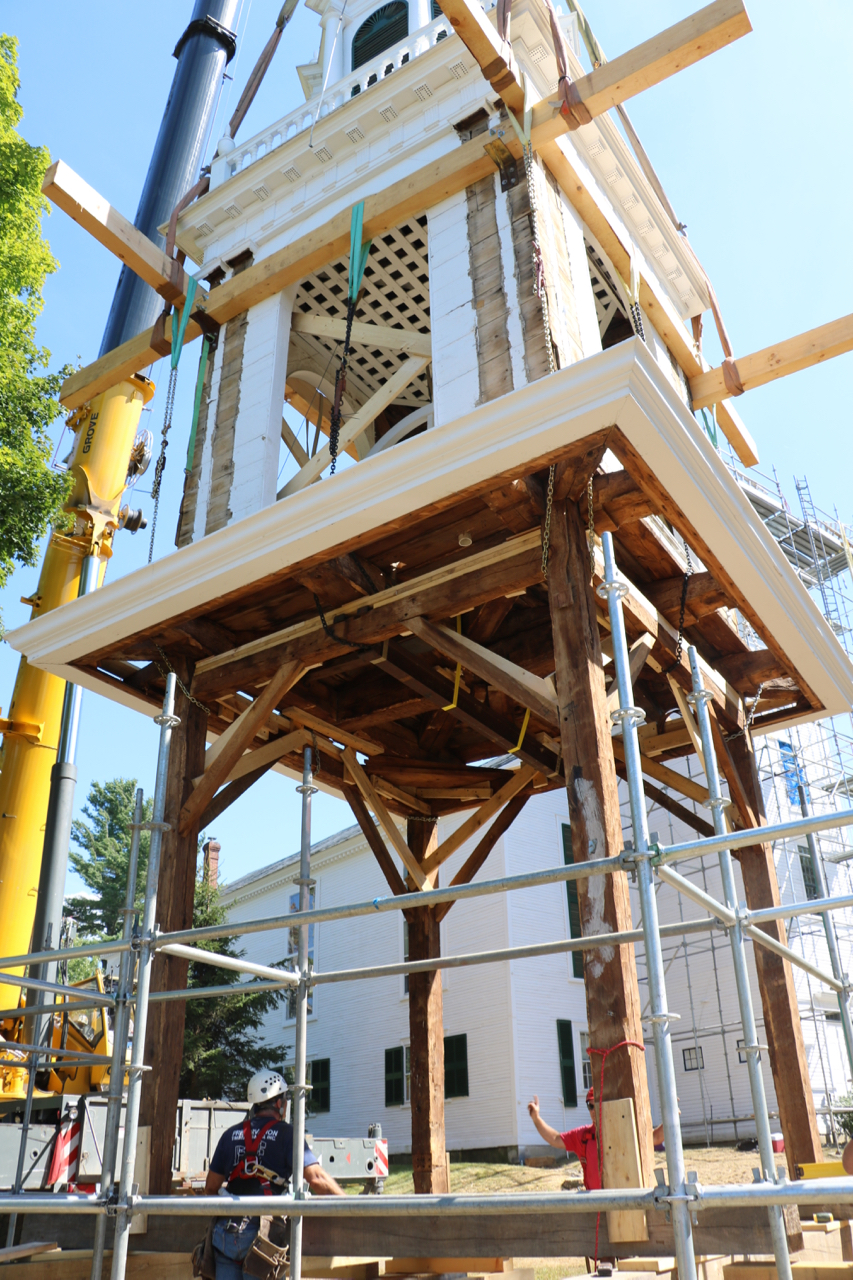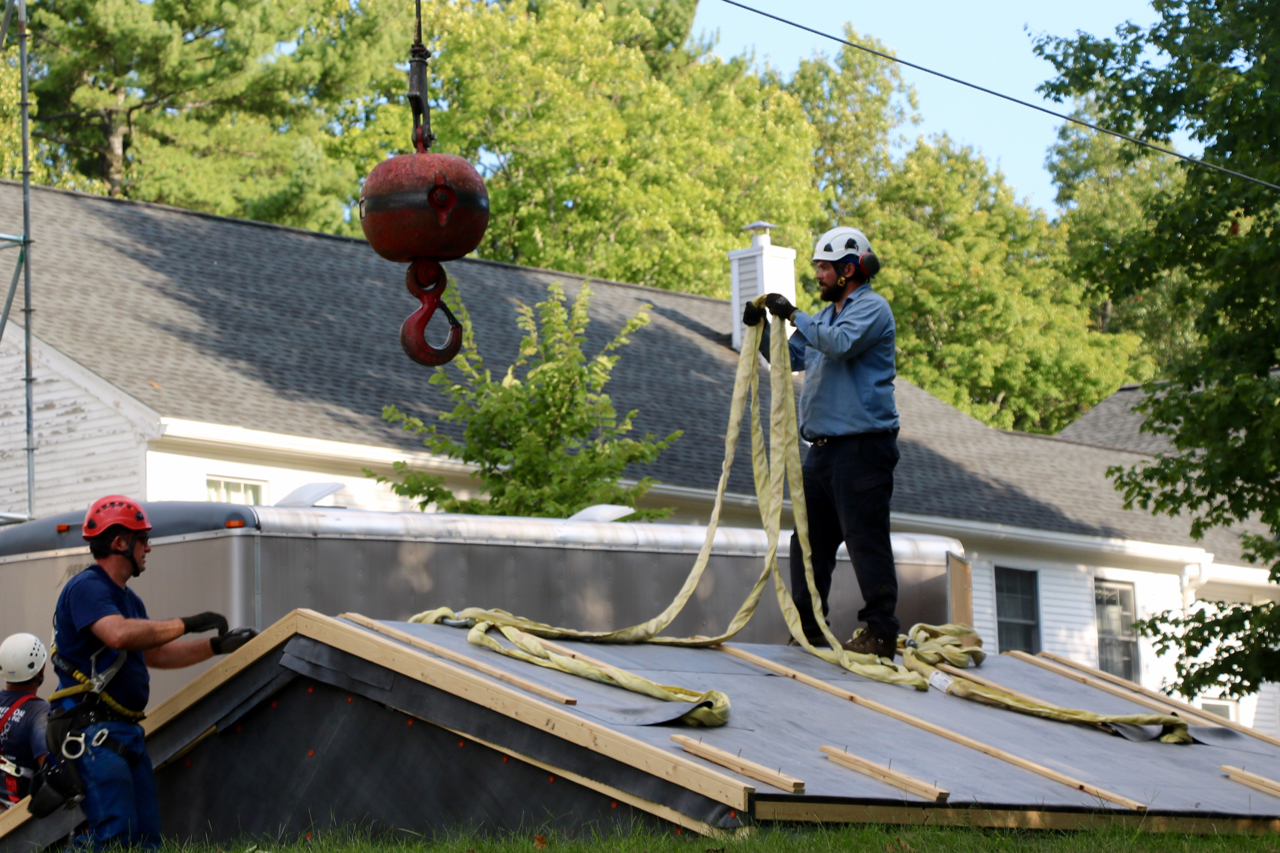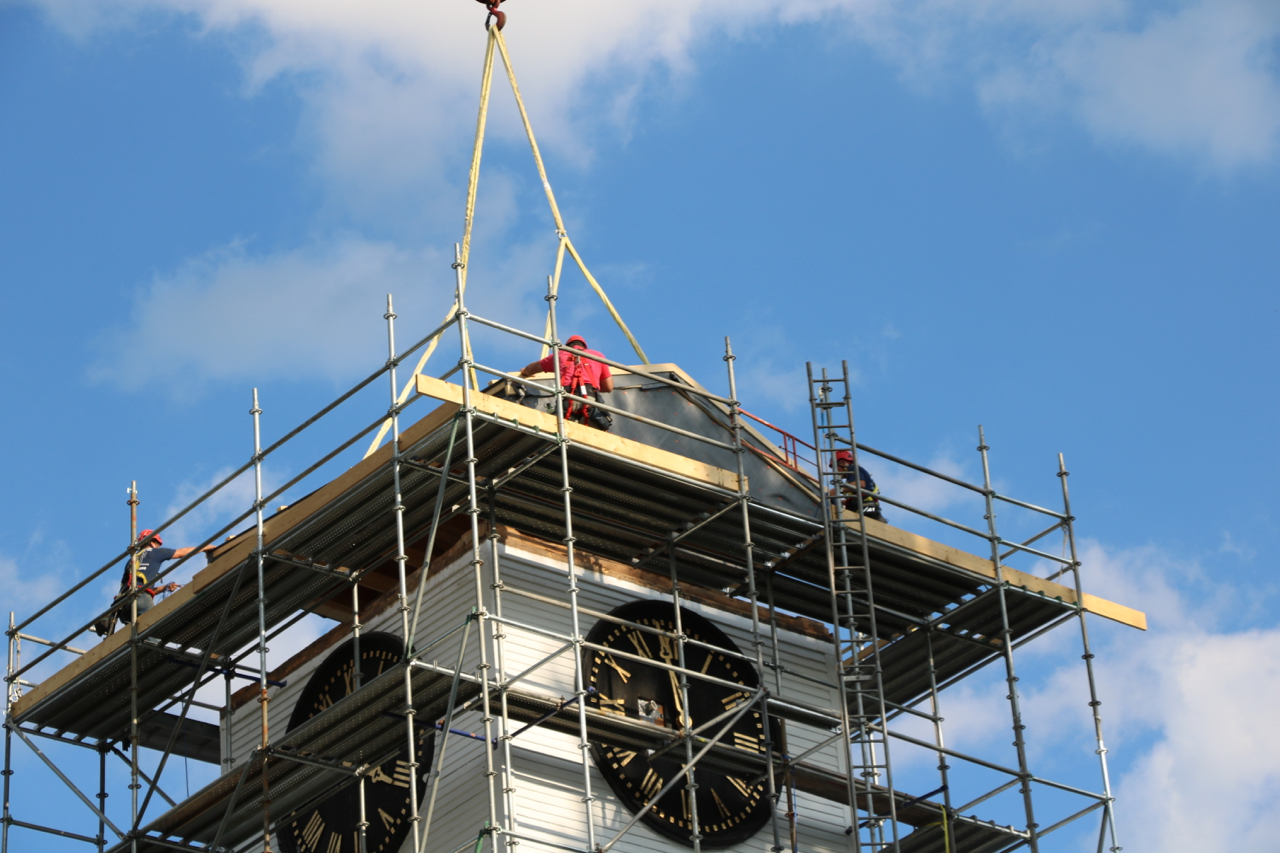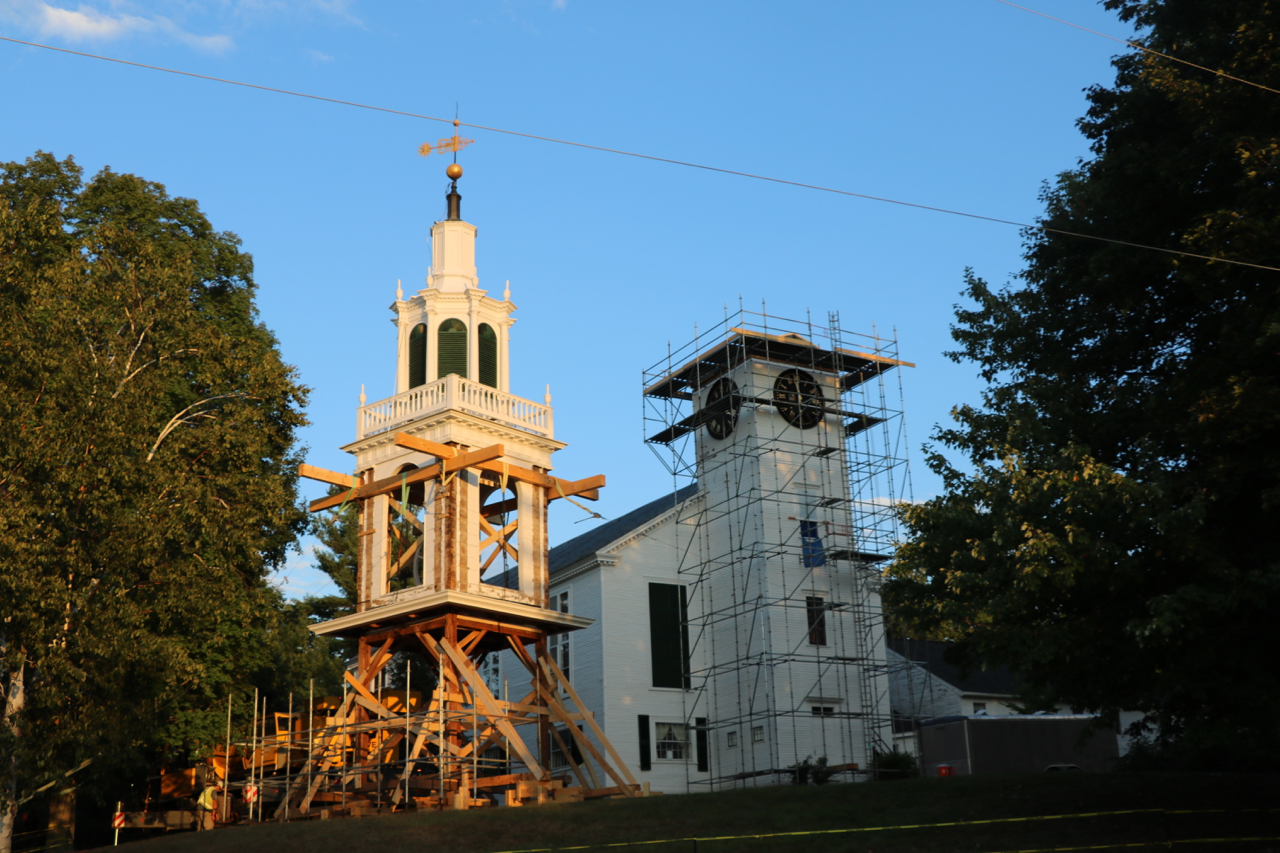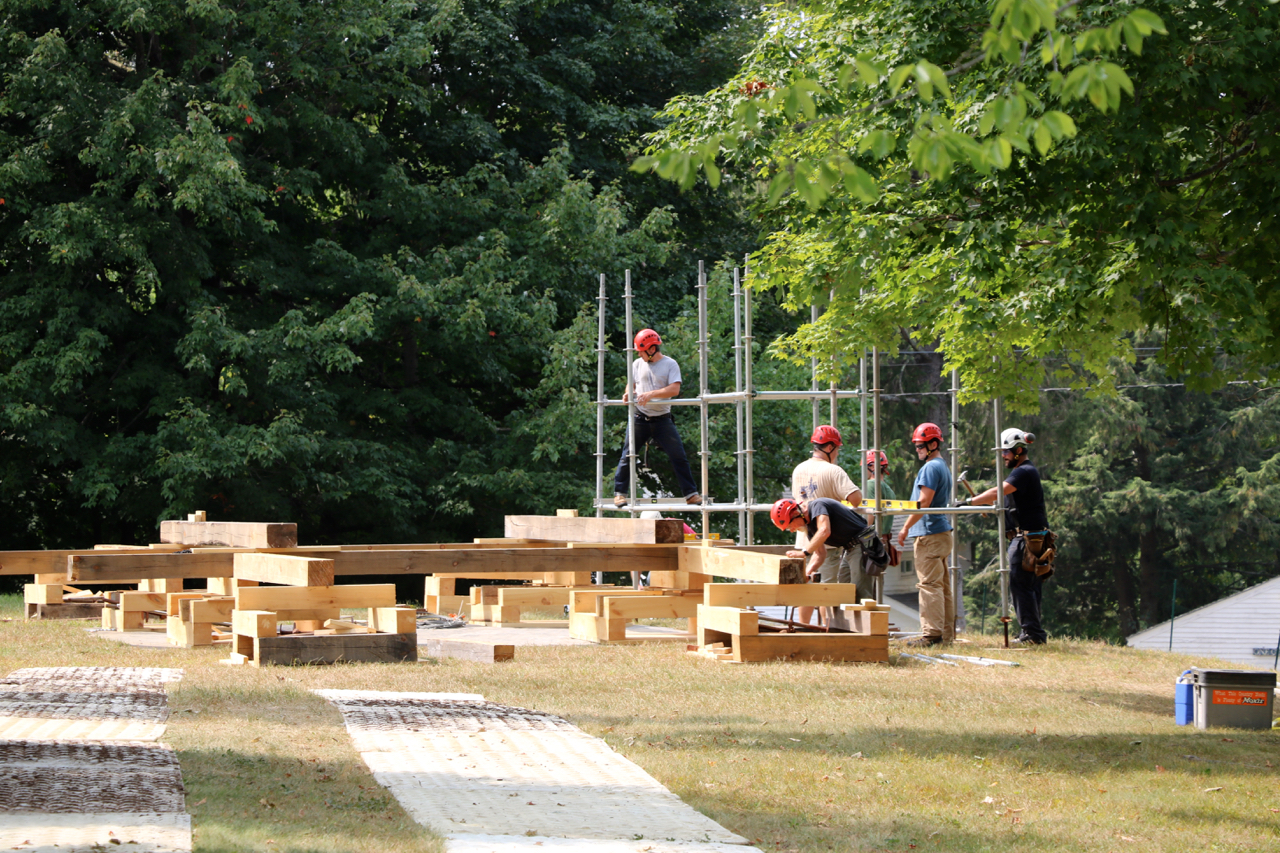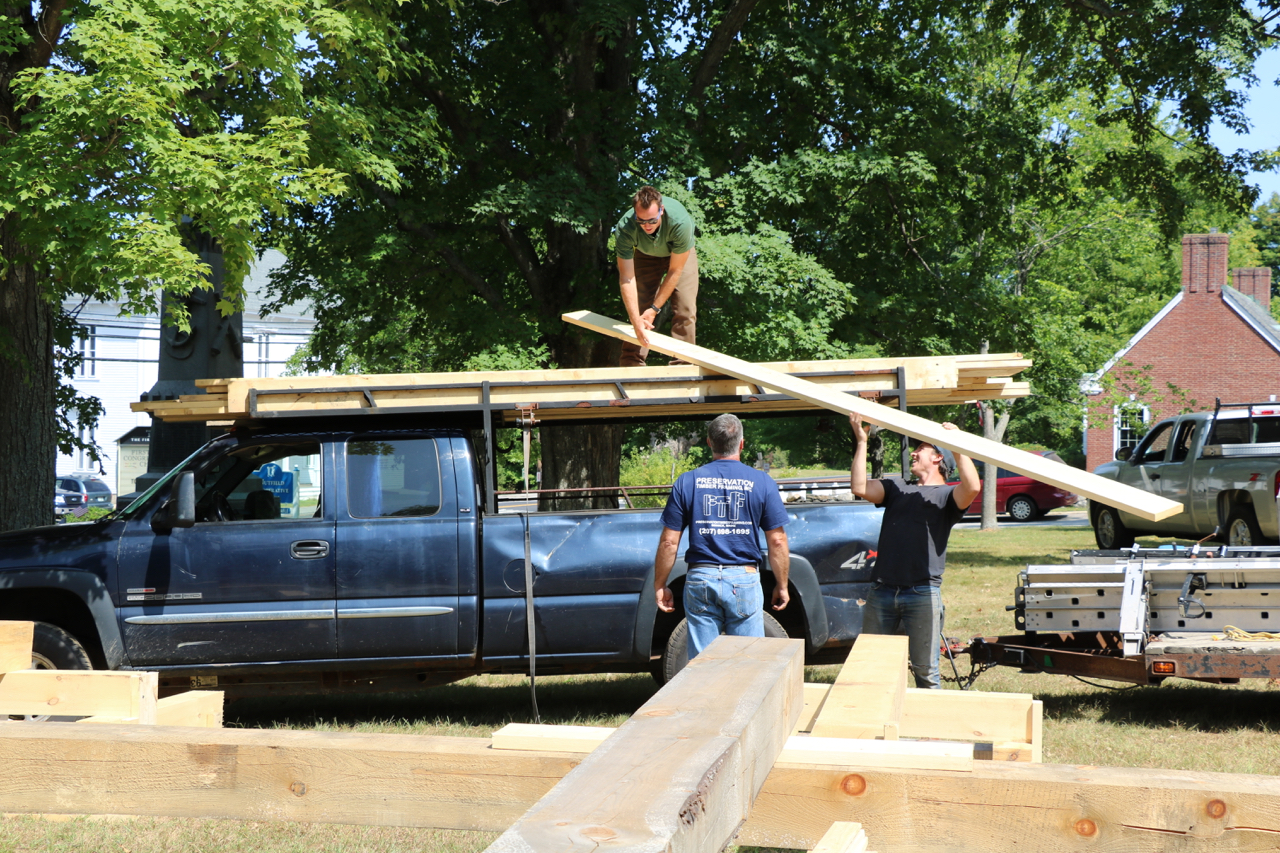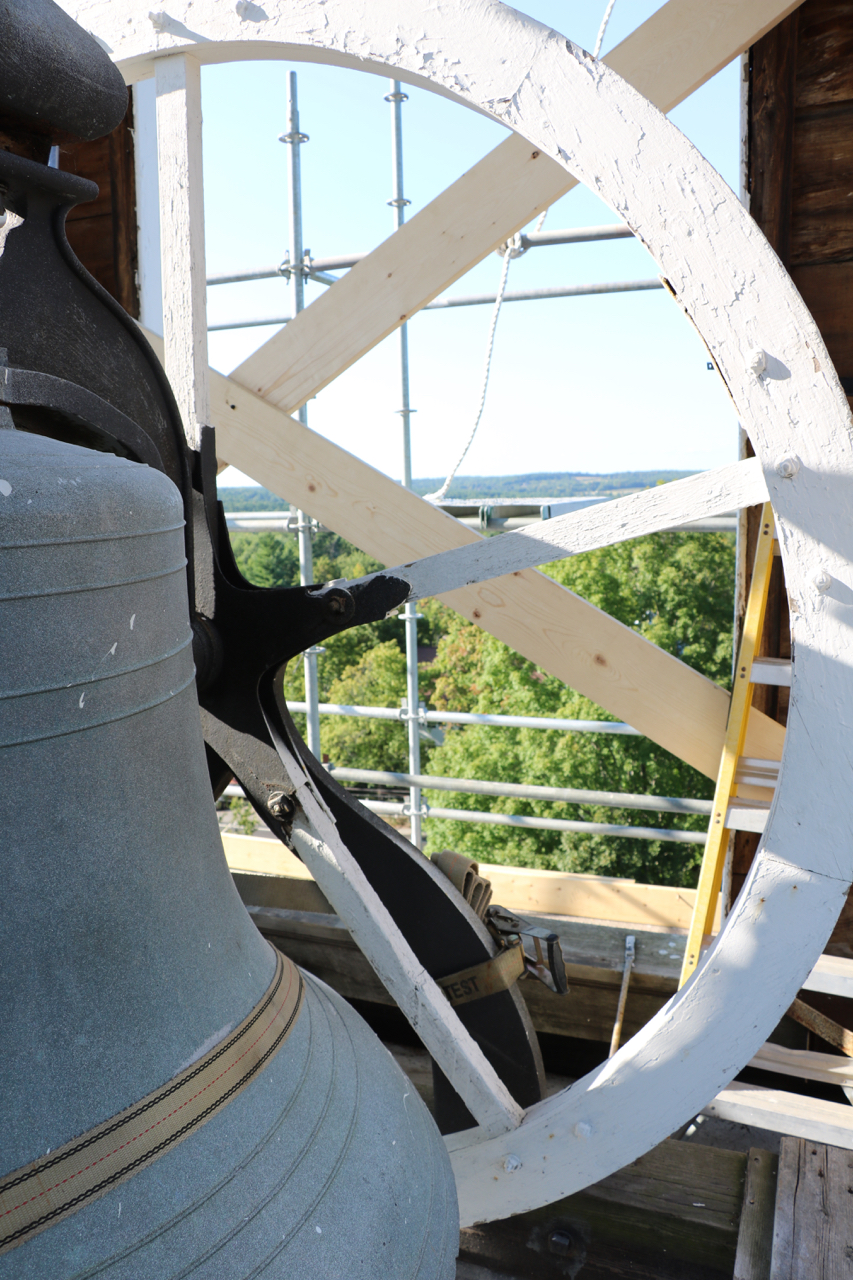
NUTFIELD HISTORY BLOG
Articles, news, and more
Forest Hill Cemetery — Early Settlers Plot Refurbishments
Refurbishments in Forest Hill Cemetery for the Nutfield 300th focus on the historic plots in the Early Settlers area.
One Nutfield 300th project the Derry Heritage Commission has underway is the refurbishment of the early settlers plots in Forest Hill Cemetery.
This row of headstones includes Rev. James MacGregor—the “Moses of the Scotch-Irish” and founder of Nutfield who was buried in 1729—and his wife and sons and their wives. For perhaps a century it was surrounded by an iron fence, and in recent years sported a street sign identifying the “First Settler.”
The iron rods in the fence obscured the stones, and the handsome iron posts at the corners and midpoints of the fence needed refreshing. Local historian and Forest Hill Cemetery authority TJ Cullinane has been working with monument experts Cornerstone Cemetery Services LLC to develop a new, refined design to mark and protect these treasured headstones.
The new design will reuse the iron posts, first stripping, repairing and repainting them to restore their original appearance. The iron rods will be replaced with chains, which can be moved out of the way for occasional photography or videography. A new, distinguished granite post already in place identifies the plots as those of the “Early Settlers.”
From TJ Cullinane:
”It’s heartening to see the support from the town and its residents for improving the First Settlers lot in honor of the Nutfield 300th observance. Equally gratifying is knowing that this support extends to our ancestral homes overseas, as this sacred spot continues to be a magnet for historians and documentary producers from throughout the North of Ireland and Scotland.”
Filming in Forest Hill for a BBC documentary (June 2012), by Waddell Media for a
BBC show on MacGregor’s descendants (March 2018),
and MacMillan Media for the Ulster Scots Agency (August 2018).
The work also includes refurbishing nearby historic gravesites, whose dilapidated condition detracted from the overall appearance of this historically significant area. Two have been completed already:
A table stone memorializing Thomas and Martha Steel
-An upright marker commemorating Robert and Dolly Taylor
Cullinane further commented:
“Here in Derry, we hold ourselves to the high standard set by the legendary British Prime Minister William Gladstone who wrote, ‘Show me the manner in which a nation cares for its dead and I will measure with mathematical exactness the tender mercies of its people, their respect for the laws of the land, and their loyalty to high ideals.’ I strongly feel that we are meeting Gladstone's standard and perhaps exceeding it."
All the work should be completed in time for Founders Weekend (April 12–14, 2019), when the Early Settlers plot and the rest of the historic Forest Hill Cemetery will be featured in tours and talks.
Film Crew Travels from Northern Ireland to Capture Nutfield Stories
A film crew from Northern Ireland visited Derry and Londonderry NH for two days of filming historic sites and interviews for the Ulster Scots Agency.
The worldwide historical significance of old Nutfield was made vivid once again by the visit of a film crew from Northern Ireland on August 9th and 10th, 2018.
May 2018 issue of The Ulster Scot publication (download PDF)
Production house Macmillan Media in Belfast, Northern Ireland, sent the crew to work on projects commissioned by the Ulster Scots Agency. That agency works to educate the world about and vigorously promote the importance of the Scots-Irish heritage worldwide. They have been instrumental in this year’s 1718 Migration activities—which mark the 300th anniversary of the departure of Rev. James MacGregor and other Scots-Irish early settlers from Northern Ireland—and will probably be helping with our own 300th anniversary celebration of the founding of Nutfield by those settlers next year.
Jane Veitch and Matt Gould, the visitng film crew for MacMIllan Media
The visiting Macmillan Media crew included producer/writer/presenter Jane Veitch, and videographer/drone pilot Matthew Gould.
Arriving at Logan Airport Wednesday afternoon, they traveled to their temporary Nutfield home in the beautiful Stillmeadow B&B before spending two very full days of local filming (described below).
On Saturday they headed up to Maine for filming of more northern Scots-Irish historic sites. They also participated in the week-long international 1718 Scots-Irish Migration and Family Reunion conference at Bowdoin College conducted by the Maine Ulster Scots Project.
Telling the Nutfield Story
Jane and Matt were focused on capturing video of historic places and artifacts as well as doing interviews with local experts and descendants.
Unlike other commercial filming outfits we’ve hosted, the videos they produce will be available to us as we work with the Ulster Scots Agency to spread the word of Nutfield and our upcoming 300th anniversary.
This mostly pictorial article gives a look at how the filming experience went, only lightly covering the actual historic subjects that got filmed. (We'll see more once Jane and the Macmillan home team finish the significant editing and production work.)
The filming site map.
Where Nutfield Began: the Meetinghouse at First Parish
We started Day 1 (Thursday) suitably enough with an introductory and planning meeting at the Meetinghouse.
SInce its construction in 1769, this historic building has been the continuous home to the church community Rev. MacGregor founded. It’s the second First Parish Meetinghouse, built to accommodate the rapidly growing community’s civic as well as religious needs, and it has undergone significant changes as that community evolved.
The Macmillan Media team got a tour and then filmed scenes throughout the building. The 1884 MacGregor family stained glass window in the Sanctuary was of particular interest. See the team in action—plus some other shots of the Sanctuary and exterior in—the photos.
Meetinghouse Preservation Project
We are halfway through a $2M project to rehabilitate the entire Meetinghouse following strict historic preservation guidelines. Learn more in this 30-minute presentation to the Derry Town Council, and help support this work by visiting the Friends of the Meetinghouse site
Downtown Derry: History Museum, Library, and an All-American Lunch
From the Meetinghouse on the hill we went down to the Derry Museum of History in the Adams Memorial Building on West Broadway.
There curator Mark Mastromarino gave a tour of the Museum’s huge collection of reference-quality artifacts and documents which cover all of the community’s three hundred year heritage. He then did a gracious and informative on-camera interview, and with this first Derry interview "in the can" the crew was visibly excited about the sort of footage they would be capturing on this trip.
Next we drove to the Derry Public LIbrary, which has been largely made possible by a gift from MacGregor descendants. In the special local history research space—the New Hampshire Room—Matt filmed the MacGregor stained glass window while Jane was interviewed by reporter Alex Guittarr for the Nutfield News.
A quick walk from the Library took us to MaryAnn’s Diner, for an all-American lunch and the first of the many over-calories treats Jane and Mary would enjoy throughout their visit. Quite taken by the town, the team later visited Derry’s Central Fire Station and the Robert Frost Farm in their “free time.”
First Parish CHurch and Forest Hill Cemetery
After lunch we returned to First Parish in East Derry to conduct an inspiring interview with the pastor there, The Reverend Doctor Deborah Roof.
Then we packed up and moved just beyond the Meetinghouse and church facility to Forest Hill Cemetery, the final resting place of most of the First Settlers and the many generations to follow.
Expert TJ Cullinane gave an excellent tour and interview segments covering several interesting topics. (See the clip for a glimpse of just how glamorous these video interviews tend to be.)
The three-hour Forest Hill session concluded with Matt capturing some fantastic aerial footage using his DJI Inspire 2 drone.
Site of Rev. MacGregor’s First Sermon
The First Sermon in Nutfield" from Willey's Book of Nutfield, p. 52.
From the cemetery we went with Pastor Deborah to the site on nearby Beaver Lake where it is said Rev. MacGregor preached the First Sermon. (That was April 12, 1719; our Nutfield Founders Weekend will take place 300 years later.)
The site is on private property today, and we appreciate the owner giving us permission to film there. There is some debate whether the sermon took place right on the shore or closer to today's road. We chose to film at the more scenic shore location.
Pastor Deborah did a very nice reading of Isaiah 32:2 KJV, the verse Rev. MacGregor featured in his sermon. Matt captured this from various angles, then got more beautiful drone footage over Beaver Lake as the sun began to set.
Friday: Londonderry Historical Society
Friday morning we visited the Londonderry Historical Society next door in the separate town of Londonderry. (Yes Northern Ireland readers, here Derry and Londonderry are two individual towns that coexist peacefully, without the debate you're accustomed to.)
Society member and Morrison House Museum curator Ann Chiampa gave a wonderful tour of the Museum's collections and displays—which Matt then expertly captured—and sat for an in-depth interview by Jane.
Lunch and Interviews at First Parish
We stayed too long at the fascinating Londonderry site and rushed to meet several people for lunch back at First Parish in East Derry. With pizza and salad from the historic East Derry General Store across the street, the crew conducted interviews with several local history volunteers (see the photos and Acknowledgements down below).
We were thrilled to also have early settler descendants join us for lunch. James Scannan and his mother Josephine Eleanor Wiggin Scamman trace their family tree back to the Cochran and Wilson families, and traveled from Stratham, New Hampshire just for our lunch.
Doorway to the Past: The Sandown Meeting House
Our last stop with the film crew was a visit to the Old Meeting House in the nearby town of Sandown, New Hampshire. There trustee Arlene Bassett let us in and showed us around. While not a direct part of the Nutfield story, this beautiful meetinghouse was built in 1774, just five years after the current First Parish building, and has remained nearly unchanged since then.
Stepping through the old door was a very inspiring experience, as the pulpit, galleries, box pews, and other interior features we've described so frequently at First Parish were still there to be seen. With the interior looking very much as first built, it was easy to imagine the people whose lives had been centered on this religious and civic structure.
We'll provide more photos and compare the Sandown and East Derry meetinghouses in a future blog post.
Conclusion, Acknowledgements, & Links
It was a pleasure working with Macmillan Media's Jane Veitch and Matt Gould, and we're honored they chose to film so much here in old Nutfield. We'll be sure to share their results locally once available. We also hope they are able to come back next year and help capture our exciting Nutfield 300th Celebration activities!
Many thanks to our local volunteers and friends who prepared material and gave interviews with very little advance notice:
Mark Mastromarino, curator of the Derry Museum of History
Pastor Deborah Roof, First Parish Church
TJ Cullinane, expert on Forest Hill Cemetery and area military history
Ann Chiampa, Londonderry Historical Society
Heather Rojo, Nutfield Genealogy
Karen Blandford-Anderson, Derry Heritage Commission
Nancy Heywood, FPC Historical Preservation Committee
James and Josephine Scamman, descendants of the Cochran and Wilson Families
Arlene Basset, Trustee of the Sandown Old Meeting House
Thanks also to our local reporters and bloggers for their support and articles:
Julie Huss, Derry News — History put down on film: Northern Ireland crew captures local history
Alex Guittarr and Chris Paul, Nutfield News — Irish Film Crew Visits Area To Film Historic Roots (PDF)
Heather Rojo, Nutfield Genealogy — Documentary Filming in Nutfield
BBC Filming Rev. MacGregor's Story
A BBC film crew is covering a Rev. MacGregor family reunion and historic Nutfield sites on Saturday, March 3, 2018.
Rev. James MacGregor—“the Moses of the Scotch-Irish in America” —led the first of thousands of Scots who migrated from Northern Ireland to North America in the 1700s. Now some of his descendants are retracing Rev. MacGregor’s journey, in the company of a film crew making a documentary for the BBC.
This Saturday (March 3, 2018) they’ll be in Derry and East Derry, New Hampshire, the heart of the old Nutfield territory that Rev. MacGregor and the sixteen First Settler families made home.
Discovering A Famous Ancestor
Waddell Media, Ireland’s largest factual independent production company, is filming for the BBC Northern Ireland’s Family Footsteps series on living history and genealogy.
Rev. MacGregor descendent Alan Laughlin and son Ainsley with BBC presenter Gavin Andrews (center) study their long family tree.
They have already filmed retired Northern Ireland teacher Alan Laughlin taking a journey of discovery through his family tree, revealing how and where his Ulster-Scots ancestors lived during the 19th and 20th century, and ultimately revealing an ancestral link to Rev. MacGregor.
Alan’s son Ainsley is also part of the story. He, his wife Kerry, and their three daughters recently experienced the daily life of their ancestors at the Ulster Folk Park in Cultra, county Down. As described by Waddell production coordinator Sharon Whittaker, “Ainsley swapped software development for manual labour, Kerry the microwave for the open fire, and the girls got a taste of rural education in the 1800s.”
Now as this post is published, Alan and son Ainsley are traveling to New England with well-known BBC Northern Ireland presenter Gavin Andrews and a sizable film crew.
A recent depiction of Rev. MacGregor by Derry-area artist Rosalind Giuffrida Hartley.
Here the Laughlins will learn more about the legacy of of an ancestor whom prior to last week they didn’t even know they had. They will visit the port where MacGregor and his flock first landed, trace the settlers' path through New England, explore remnants of early settler life, and stop in Derry to see the legacy of the Nutfield settlement MacGregor helped establish and meet other MacGregor descendants.
Derry Locations
The filming will take place this Saturday, March 3rd, for most of the day. Area relative Colin Brooks will join Alan and Ainsley on the adventure. The film crew hopes to record key historic sites, and also to capture the look and feel of MacGregor’s town as it is today.
MacGregor family coat of arms window in the Derry Public Library (photo courtesy DPL).
The highlight is a surprise event for Alan and Ainsley: a 12:30 pm family reunion and luncheon reception for MacGregor descendants at the Derry Public Library. (Though not open to the public, the team is seeking additional MacGregor descendants to attend and meet Alan, Ainsley, and Colin. Please email if you’re interested. See also this story at Nutfield Geneology.)
The Derry Museum of History is downstairs in the Adams Memorial Building in downtown Derry, at 29 W. Broadway.
Earlier (about 11:00 am), the crew will arrive in Derry and be welcomed at the Adams Memorial Building by the Derry Heritage Commission. After a tour of the Derry Museum of History and its collection of MacGregor and Nutfield displays, the group will take a filming walk along Broadway to the Derry Public Library. They’ll shoot outside scenes of the library—which was first built thanks to the generosity of a MacGregor descendent—and the adjacent MacGregor Park, then join the reunion inside.
MacGregor memorial plaque at the Derry Public Library.
First Parish Church with its Meetinghouse anchoring the Upper Village, a National Register of Historic Sites location.
After, the crew will drive up the hill to the historic Upper Village in East Derry. About 3:00 pm the First Parish Historic Preservation Committee will give a tour of the 1769 Meetinghouse at First Parish Church, which is currently undergoing a massive historic preservation project. The Friends of the Forest Hill Cemetery will then host the crew’s visit to the First Settlers plots in the adjacent graveyard. (The public is welcome to observe at both sites.)
The First Settlers plot in Forest Hill Cemetery.
The day will then wrap with filming on Beaver Lake, near the site where MacGregor preached the First Sermon on April 12, 1719, marking the founding of Nutfield.
Depiction of the First Sermon on April 12, 1719, under an oak tree on the shore of Beaver Lake (from Willey's Book of Nutfield).
As our local preparations for the Nutfield 300th Anniversary Celebration ramp up, it’s exciting to see how important the story of Rev. MacGregor and Nutfield are to their descendants in Northern Ireland, and to participate by hosting this BBC filming. We will share news of the production and TV show as it develops.
Tower Base Rehab: Getting Started
Work is underway to repair the base of the Tower at the Meetinghouse in East Derry, part of the ongoing multi-year preservation effort.
Preservation construction work has resumed on the Meetinghouse at First Parish in East Derry.
Arron Sturgis and the team from Preservation Timber Framing are working now through probably October to rehabilitate the Base of the Tower. This involves:
- Updating the structural analysis of the timber frame elements based on further disassembly and examination done since the last study in 2013.
- Removing layers of wooden and steel reinforcements added to the interior of the Tower through the centuries, which won't be necessary when the original timber frame is properly repaired.
- Repairing the timber frame throughout the Tower Base, including replacing the two main vertical posts against the Meetinghouse wall (which are 12" x 12" x 60' long pine timbers). Two tall pines in northern Vermont have been carefully selected for this role. They come from Currier Forest Products, a sixth-generation family farm in Danville, Vermont, where the Currier Family has practiced sustainable forestry for 200 years.
- Repairing the Meetinghouse west end gable wall, which has been damaged internally by leaks around the connection to the Tower and was temporarily shored up in 2013. This also includes repairing the roof in that area with matching slates and proper copper flashing.
- Repairing the Tower sills, the main horizontal timbers at the bottom of the frame, which will require temporarily lifting and supporting the Tower to relieve pressure on the existing damaged sills.
- Finishing the Tower base exterior with matching clapboards and trim.
This work is part of the overall Tower Rehab Project for which First Parish Church (FPC) won a state LCHIP grant award in 2015. It constitutes phase number three of that large project, defined in the grant as:
Phase 3: Rehabilitate Base (Summer 2017) — Rehabilitate the Tower Base and adjoining Gable Wall and immediate roof structure.
The cost for this work is covered by part of that $125K grant award, and the matching cash FPC put aside when the award was won.
Progress So Far
Active work officially began August 2, 2017. Significant cleaning, preparation, and demolition have already been completed.
A dumpster arrived on the north lawn, and 2" x 10" dimensional lumber was delivered and stored in MacGregor Hall in preparation for its use as temporary staging throughout the Tower Base.
Demolition commenced in three areas:
- In the bathroom at the bottom of the Tower, the ceiling, floor, and much of the walls must be removed to expose the internal framing. FPC's Facility Board had previously removed the fixtures and salvageable elements, and PTF has started the rest of the demo.
- Inside the Meetinghouse in the first bay of the Sanctuary attic, insulation was removed, materials stored there taken out (and sorted into historic artifacts like old window frames and junk like scraps of wood), and a plastic wall installed isolating that first bay from the rest of the attic.
- The Organ Pipe Room (behind the cross and pulpit areas of the Sanctuary) was partially demo'd to gain access to the Tower frame.
The cleaning of these areas was especially difficult and hazardous due to the abundant presence of bat guano. The recent bat population is quite small, but in years past tens of thousands of bats were documented (by UNH) as living in the Meetinghouse attic and Tower. Areas such as inside the ceiling of the Organ Pipes Room had never been cleaned, and were filled with guano up to eight inches deep.
Next Steps
With much of the preparation and cleaning completed, work will next focus on repairs of the timber frame from the bottom up, starting with the sills.
Tower Top Disassembly & Transport
Breaking down the Tower Top and moving its pieces to offsite storage.
After considerable preparation and planning (and waiting for the ground to freeze in this bizarre winter), Crane Day came on January 20, 2016.
The early morning temperature was 17°F and a fierce cold wind whipped up the hill. Preservation Timber Framing (PTF) gently lowered the pieces down, starting from the top:
- first the Upper Lantern, which was laid to rest intact on a trailer;
- then the large Lower Lantern, which was set on the ground for later disassembly;
- then the huge rigging timbers that had been applied for the Tower Top Takedown last September;
- then the bell, raised vertically out of its long-time home in the Belfry and placed on its own trailer for transport to Nottingham; and
- then finally some of the larger timbers from the Belfry itself.
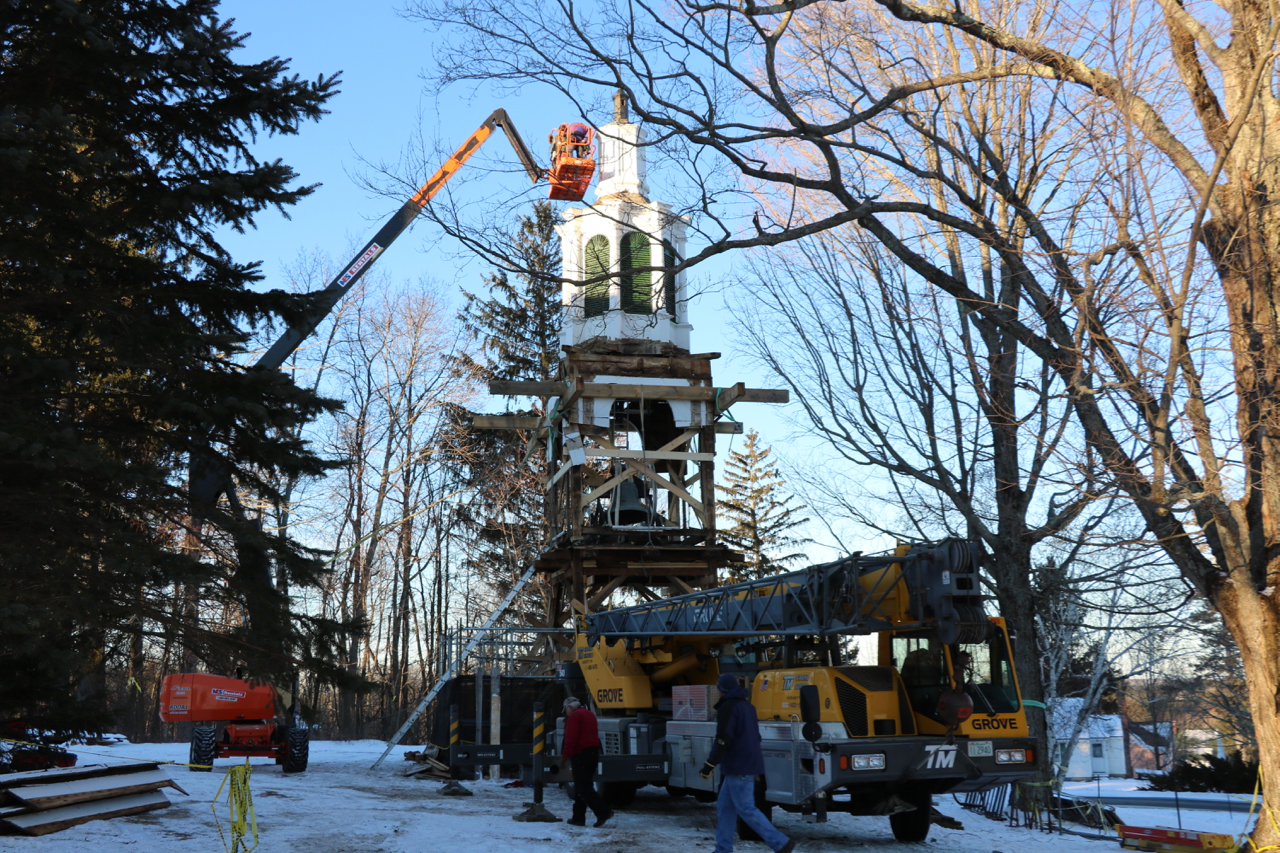
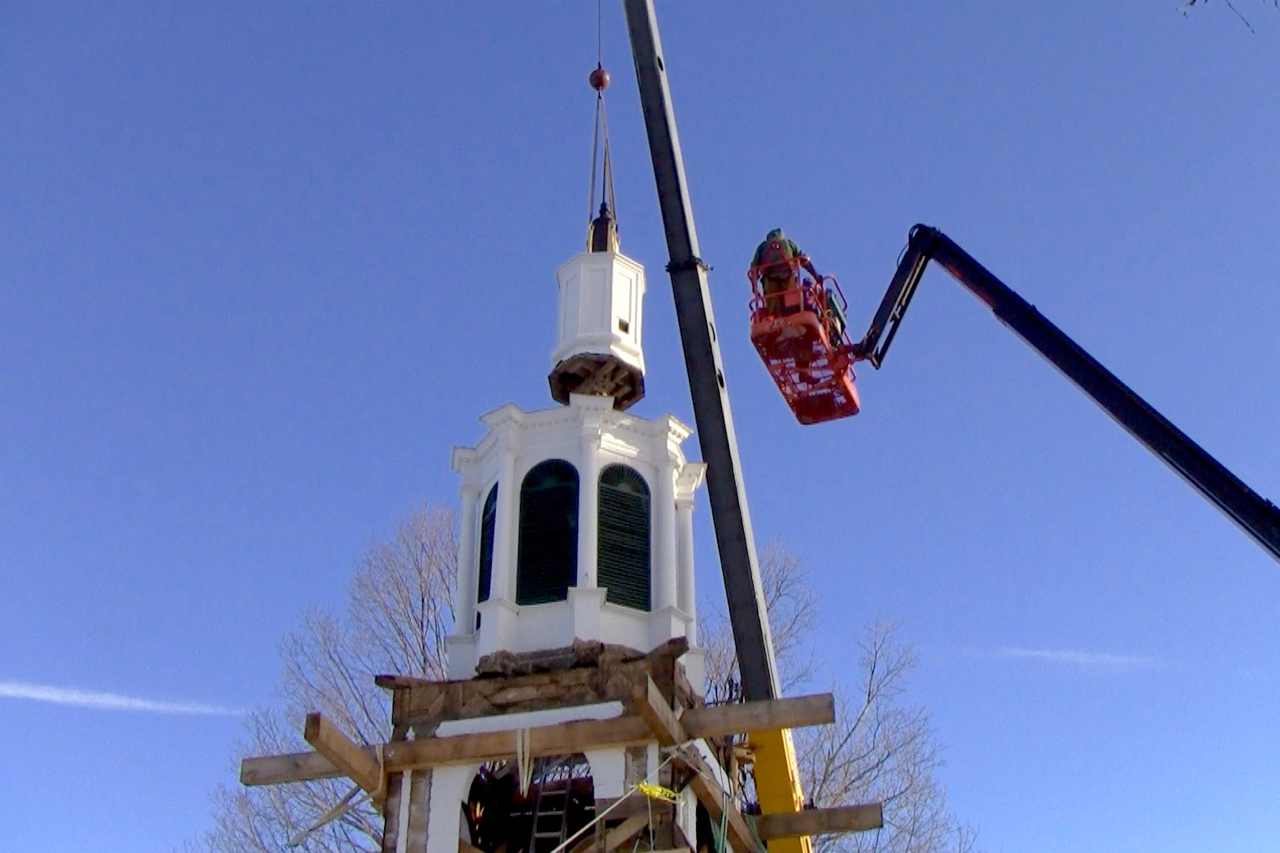
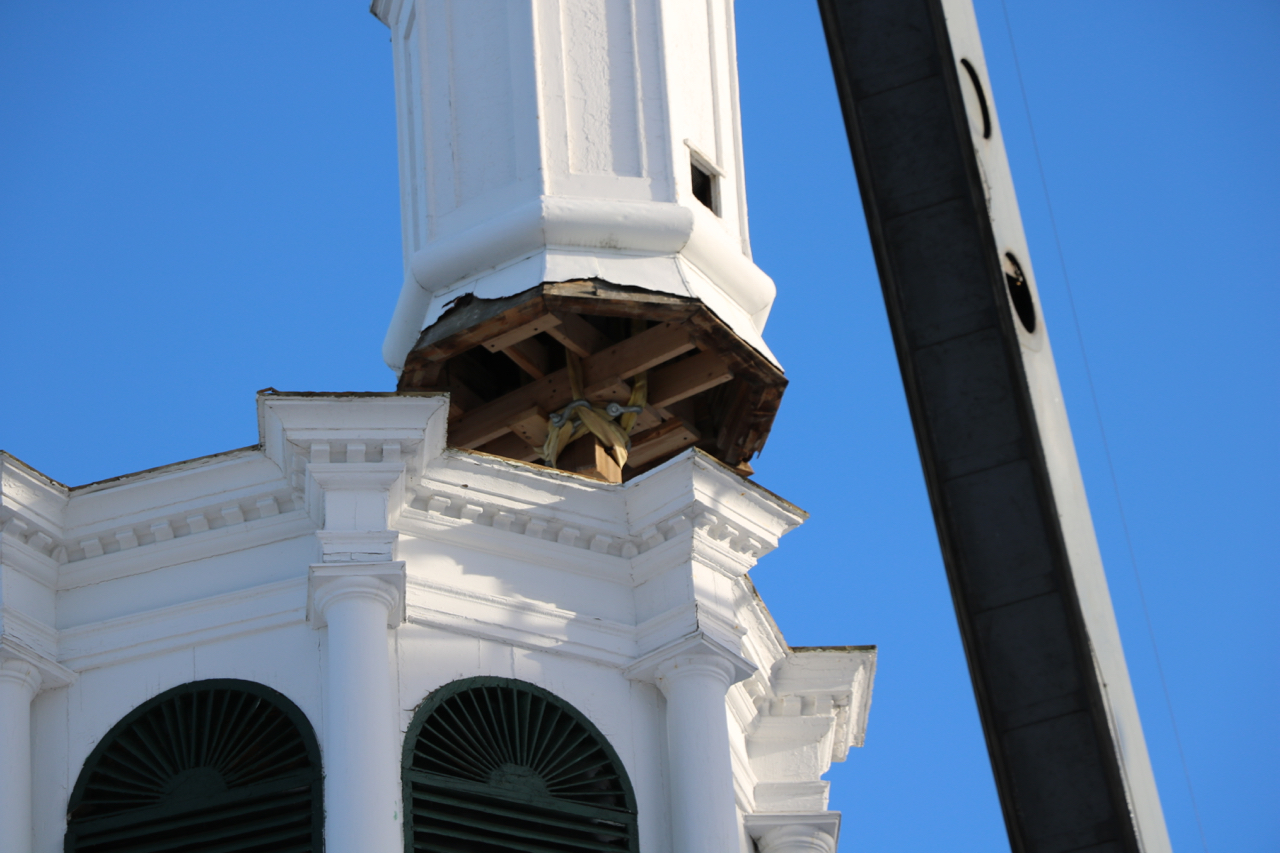
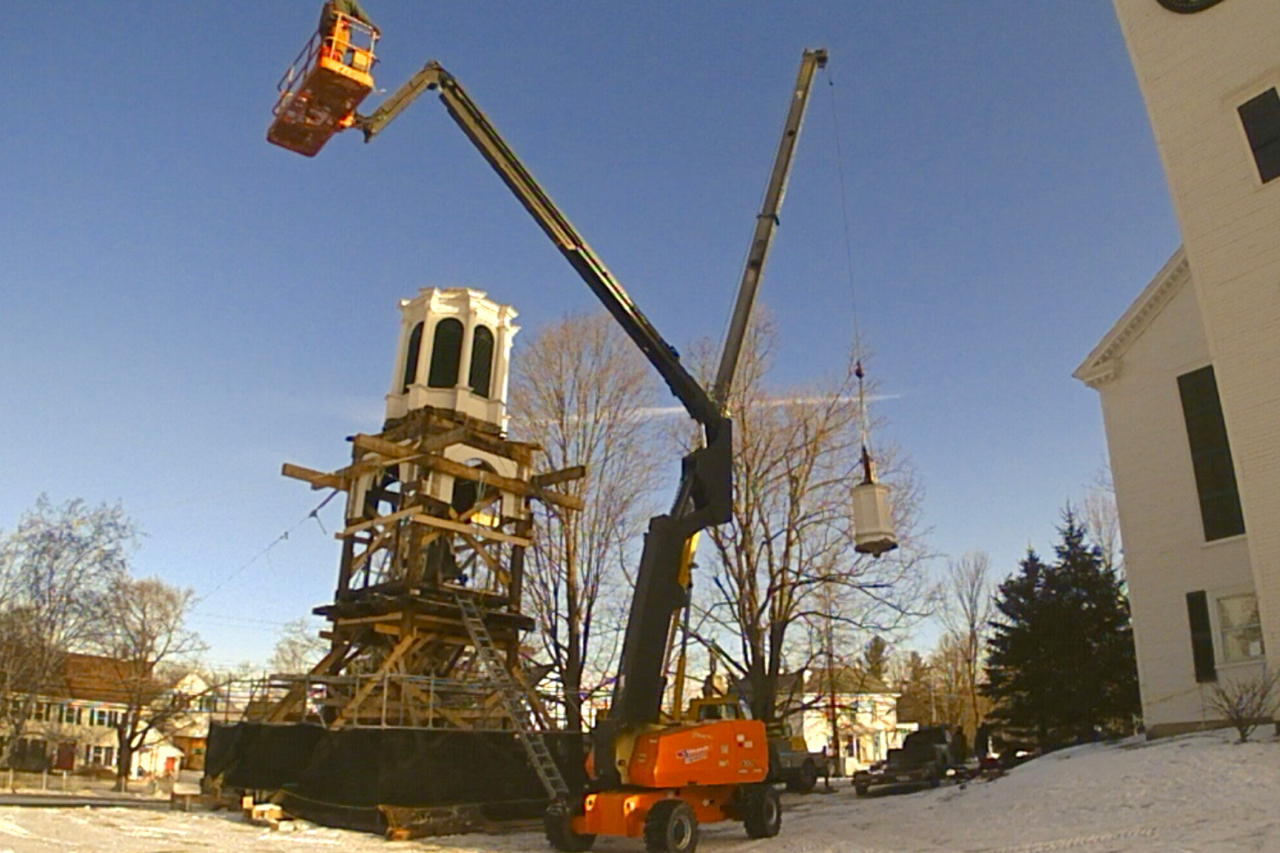
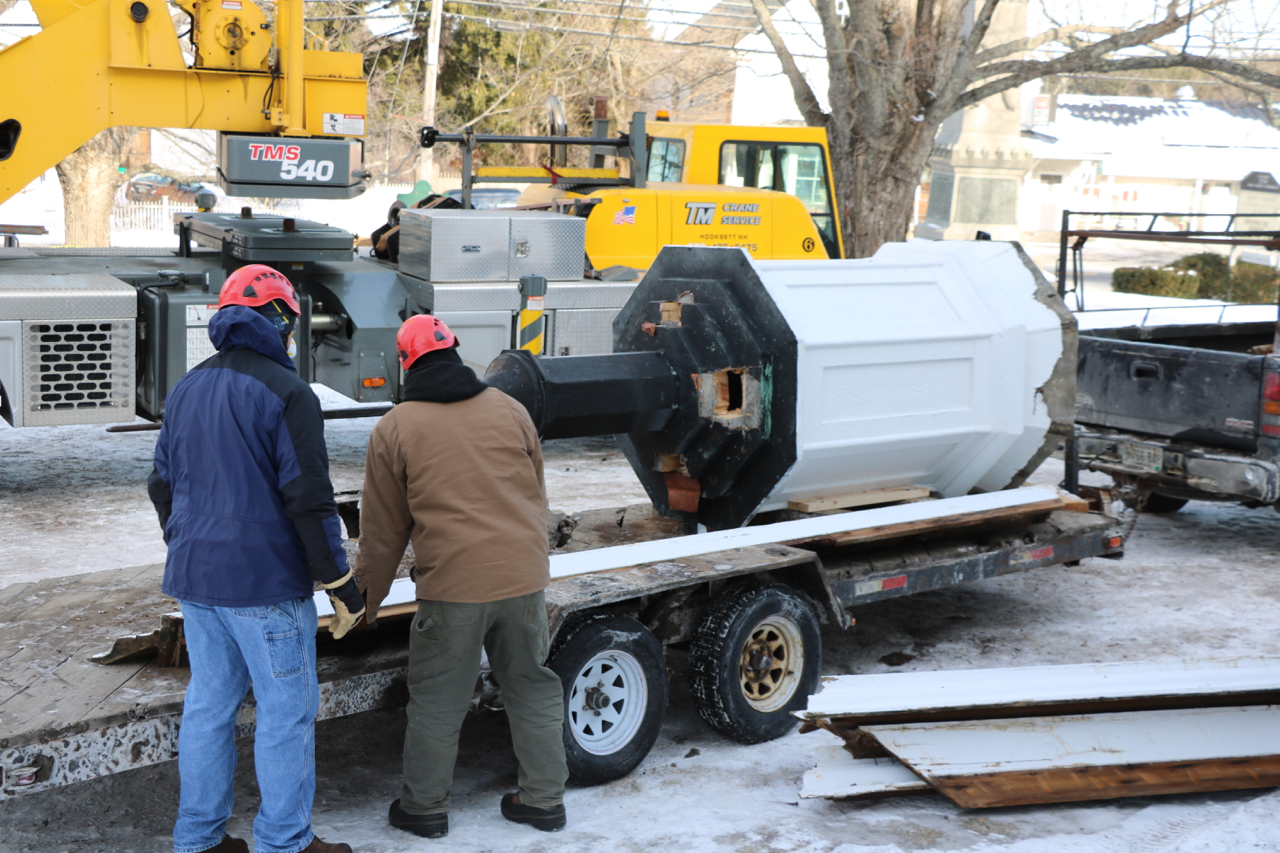
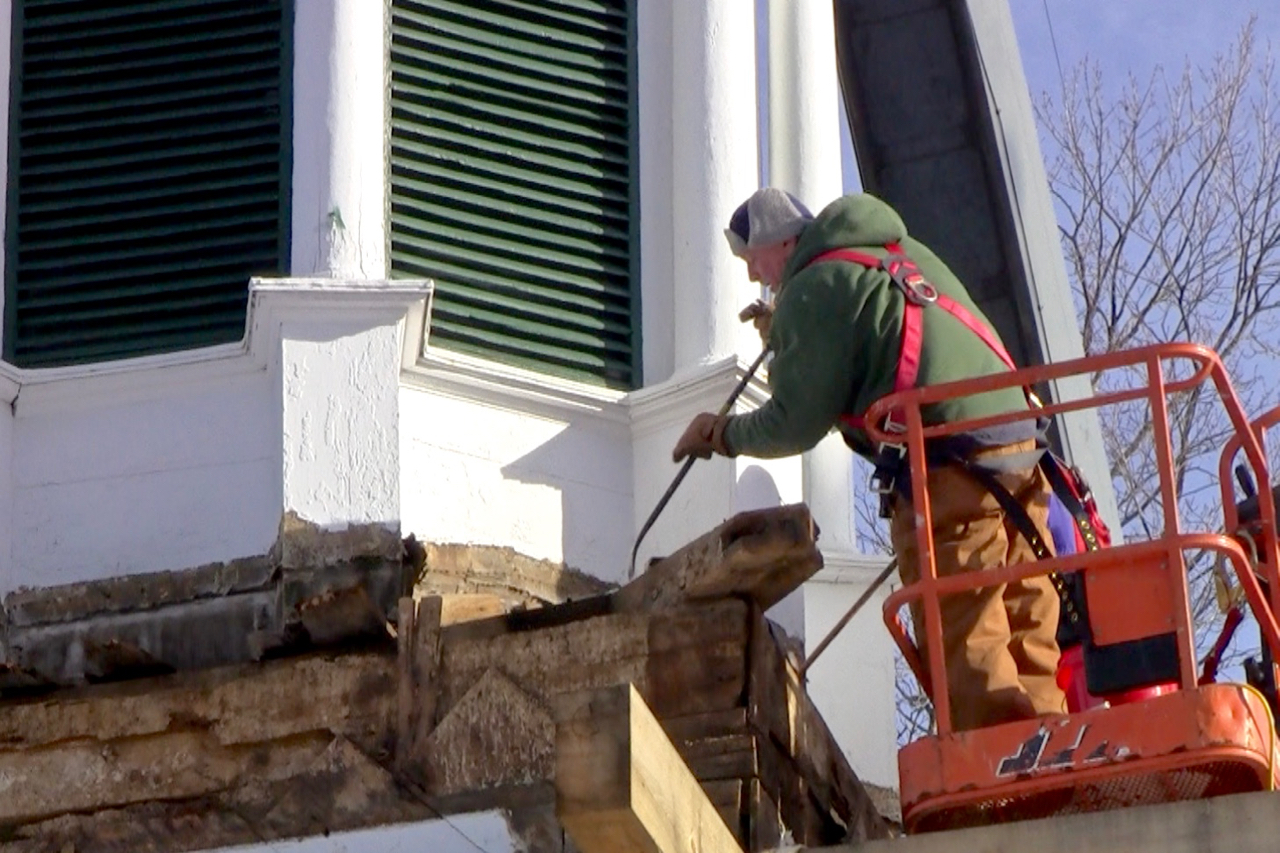
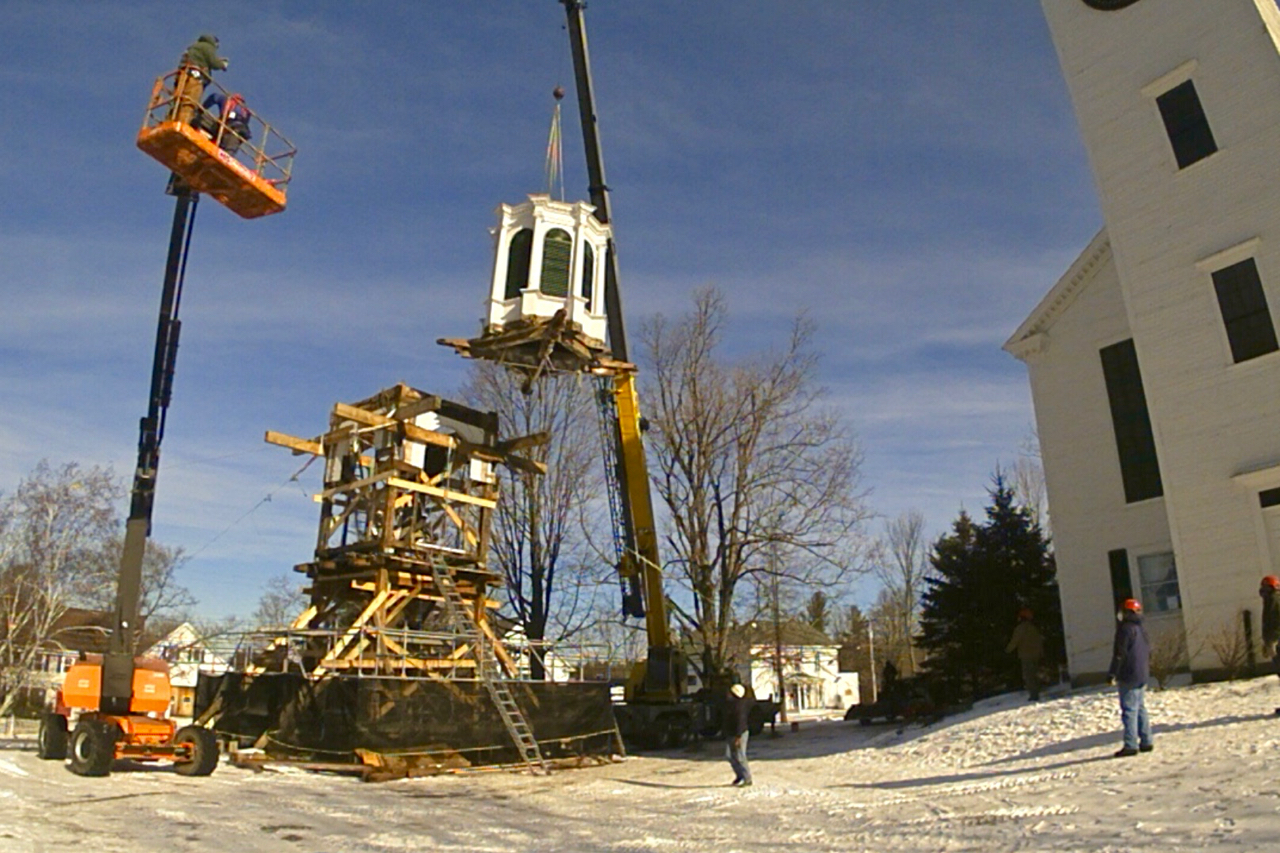

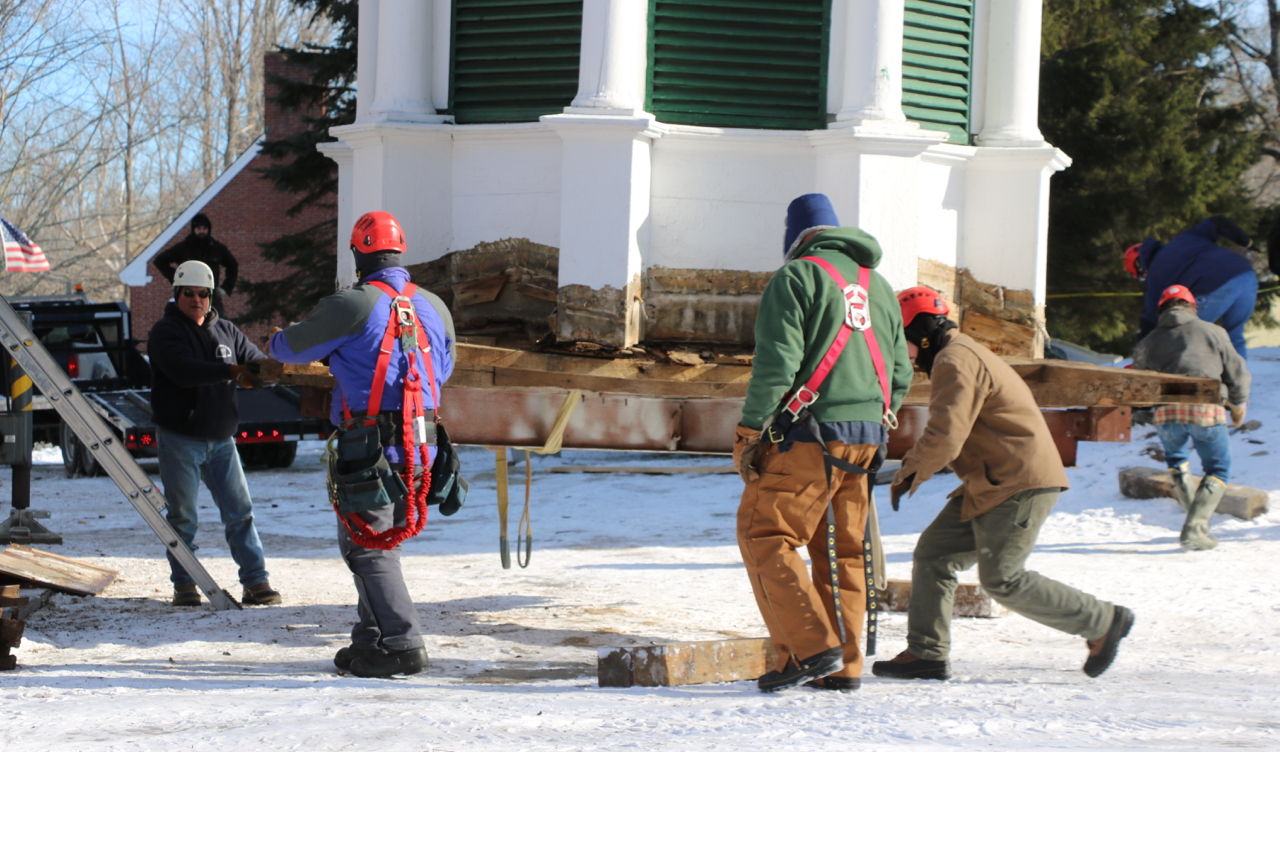
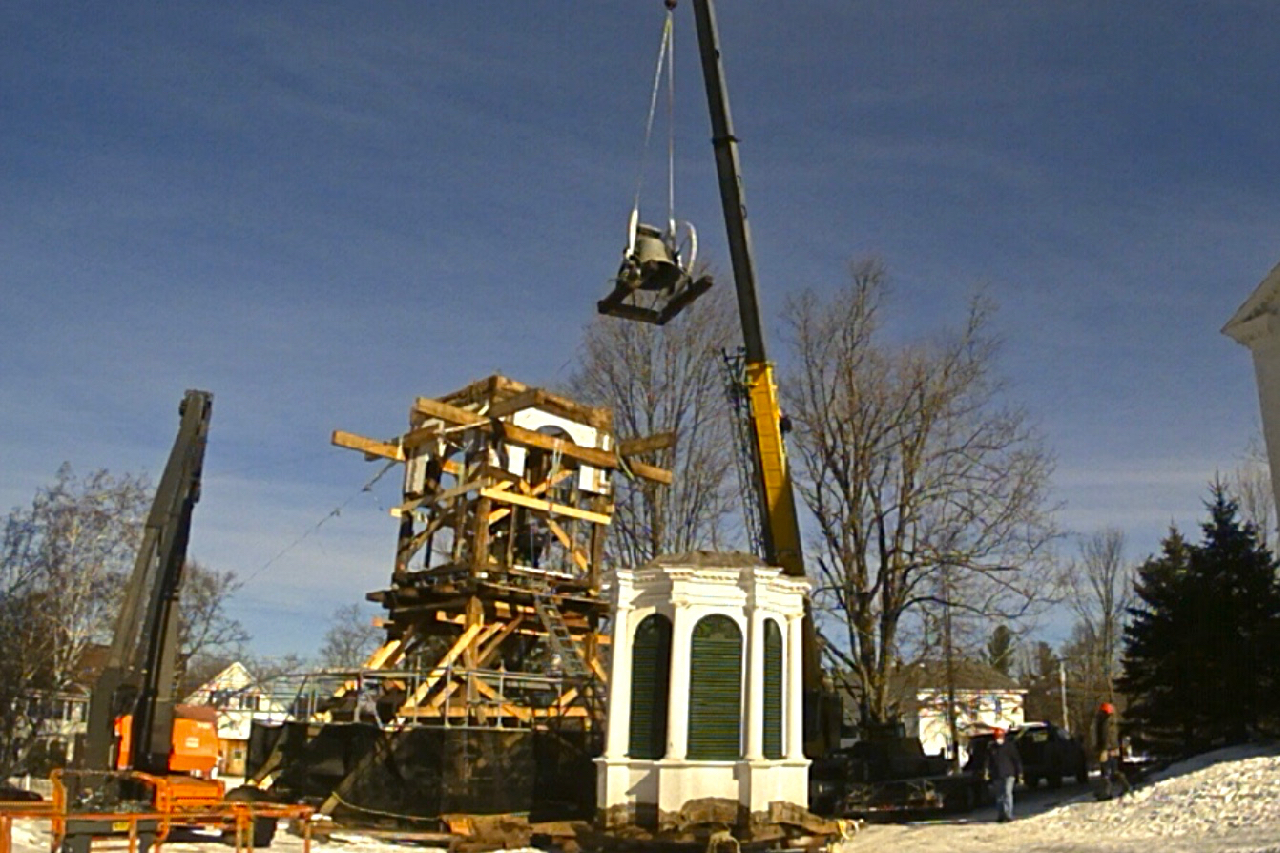
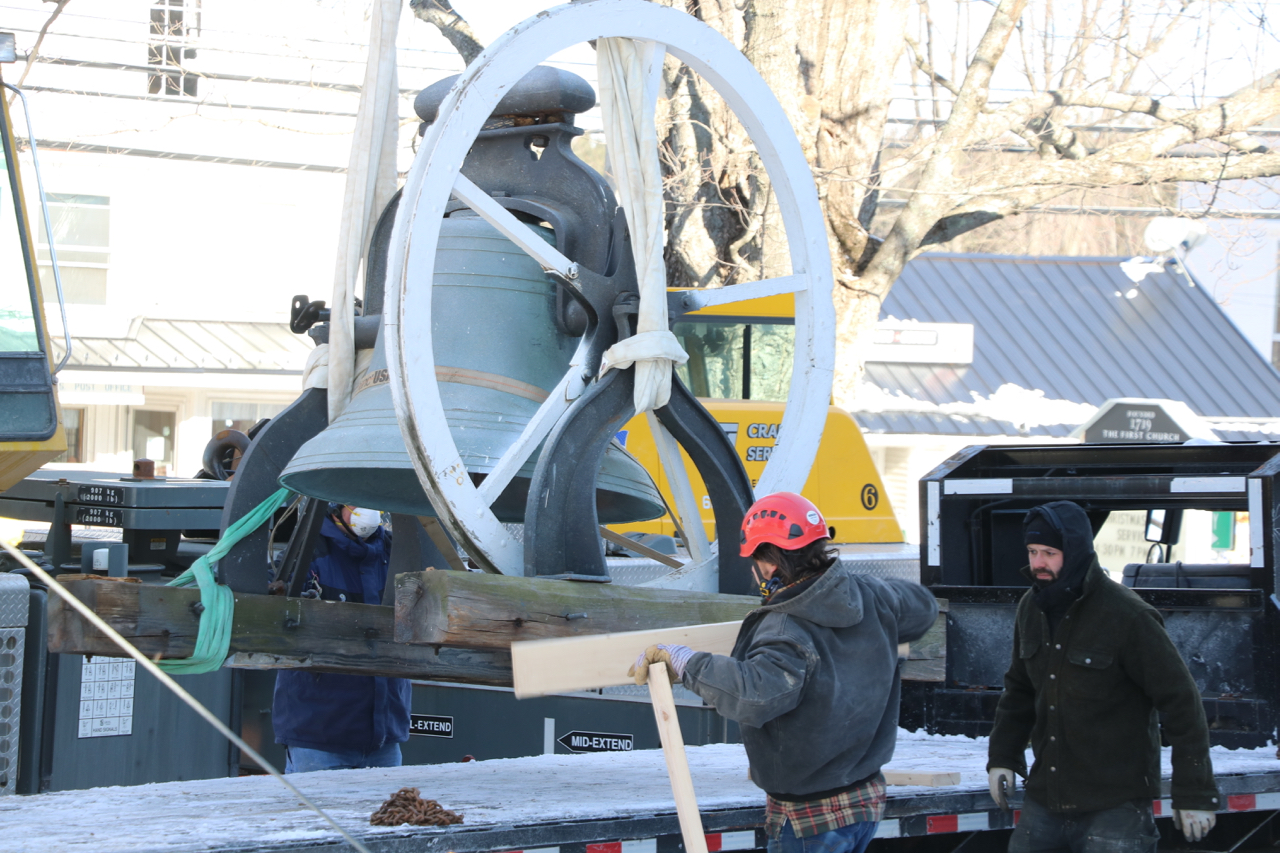

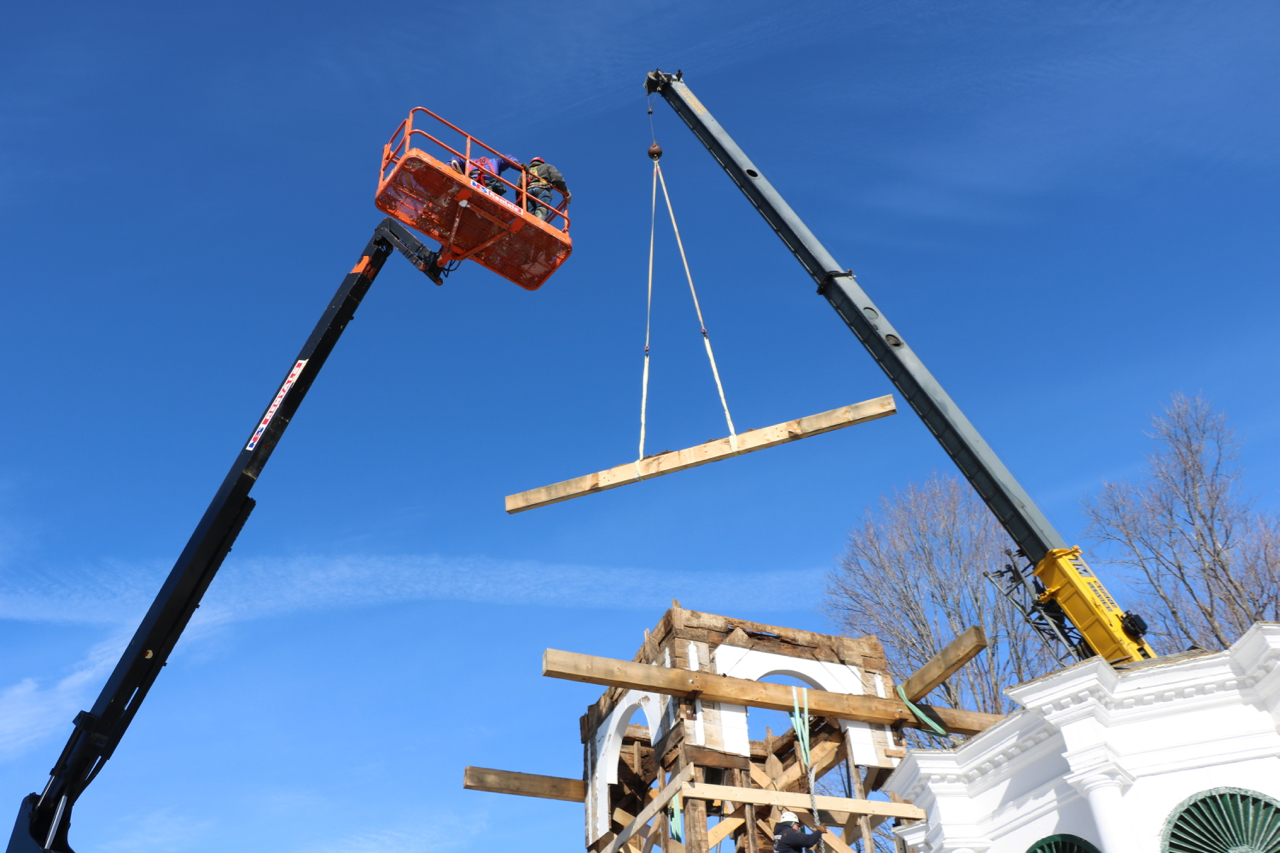
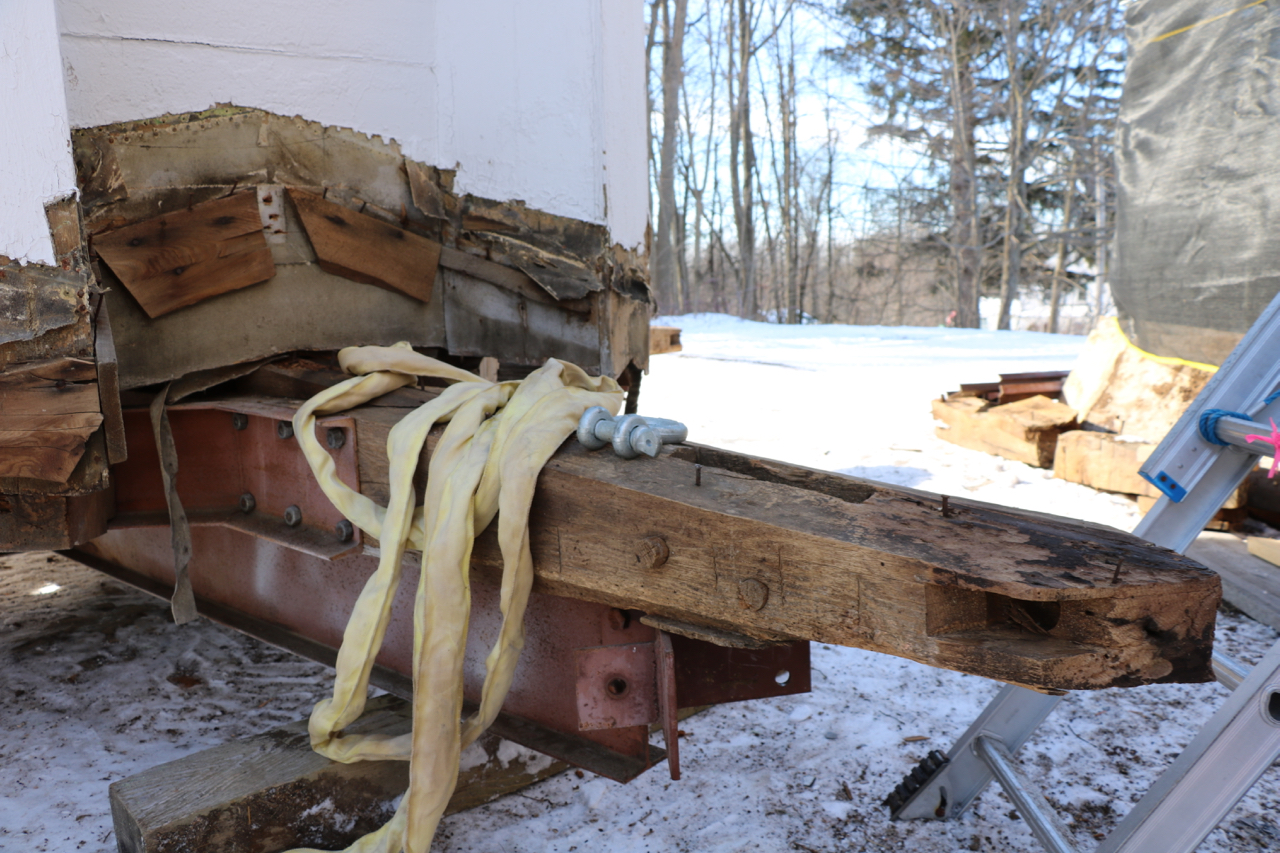
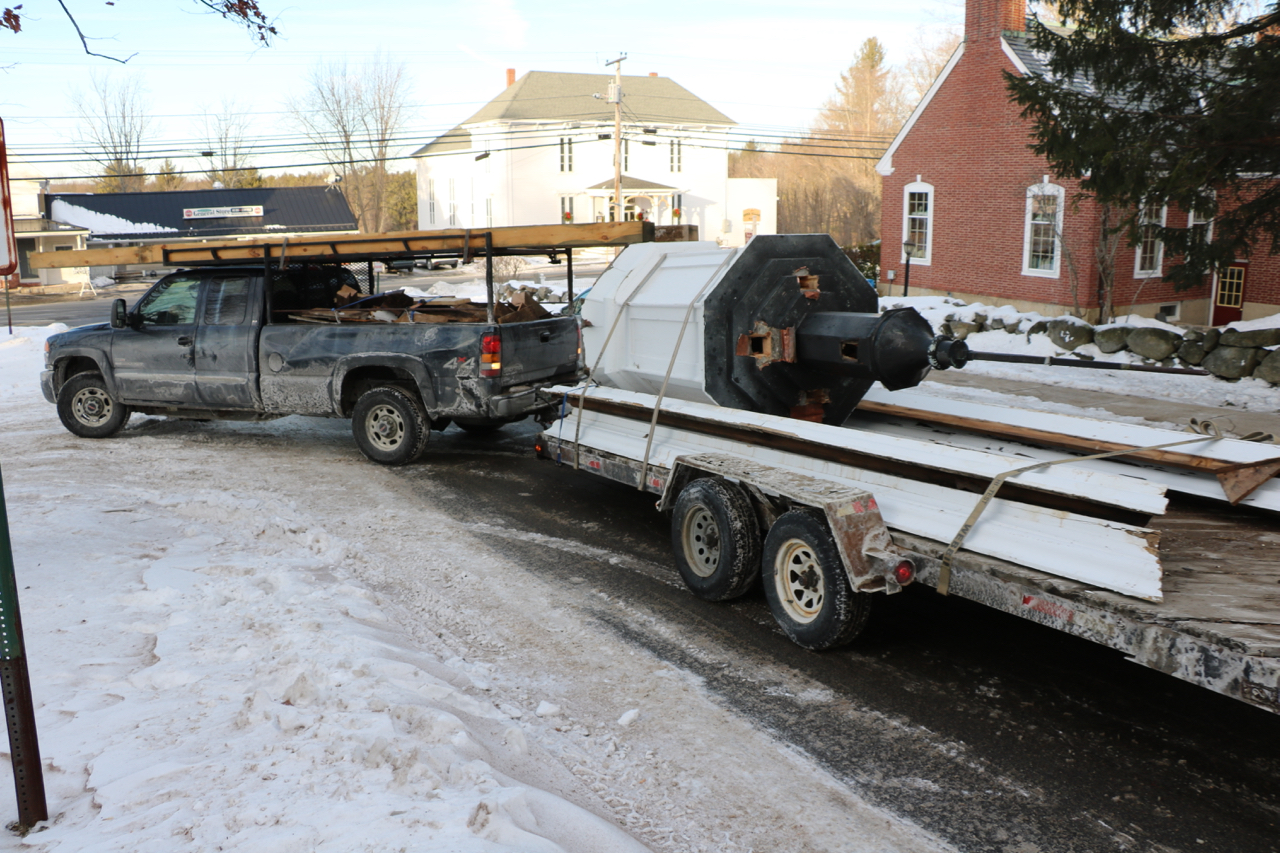
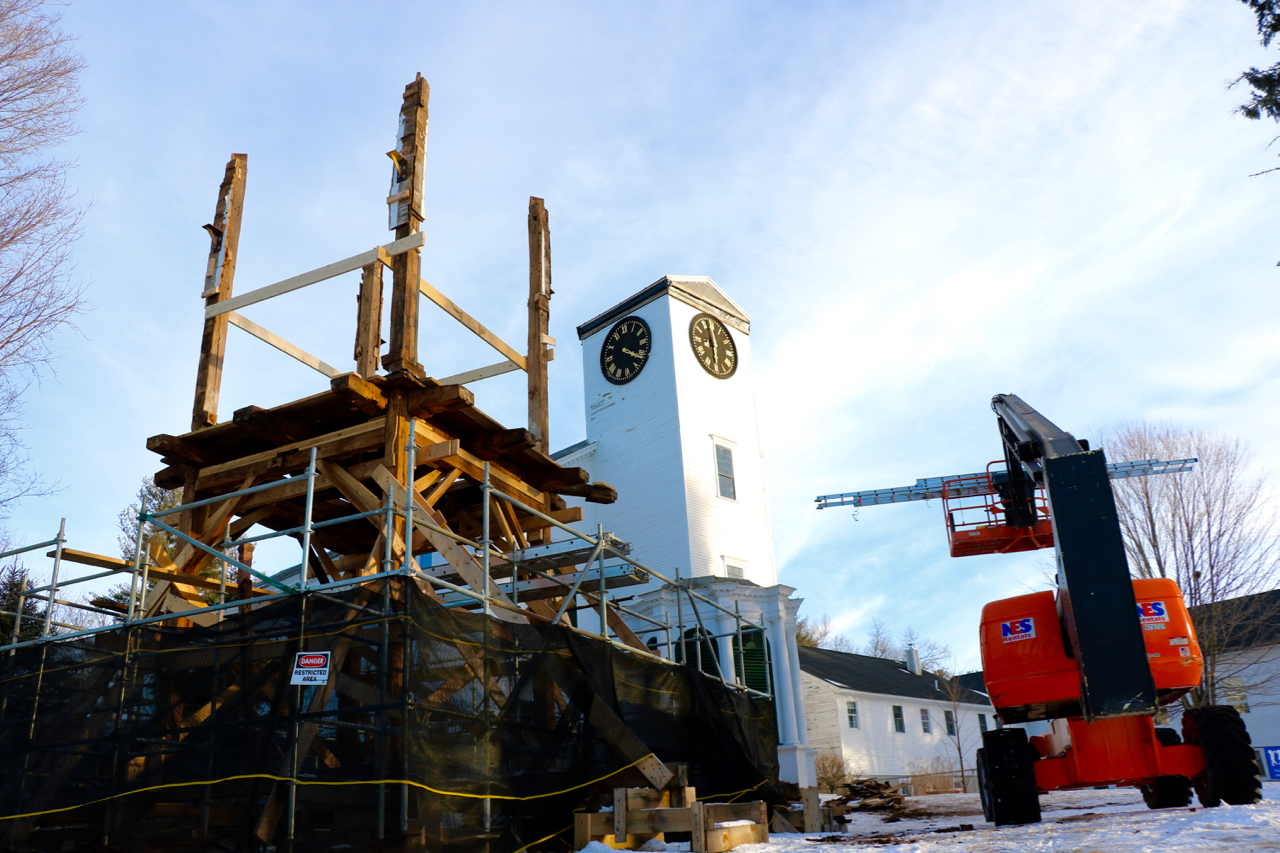
The slow, tedious disassembly and documentation work then continued another two weeks or so after crane day.
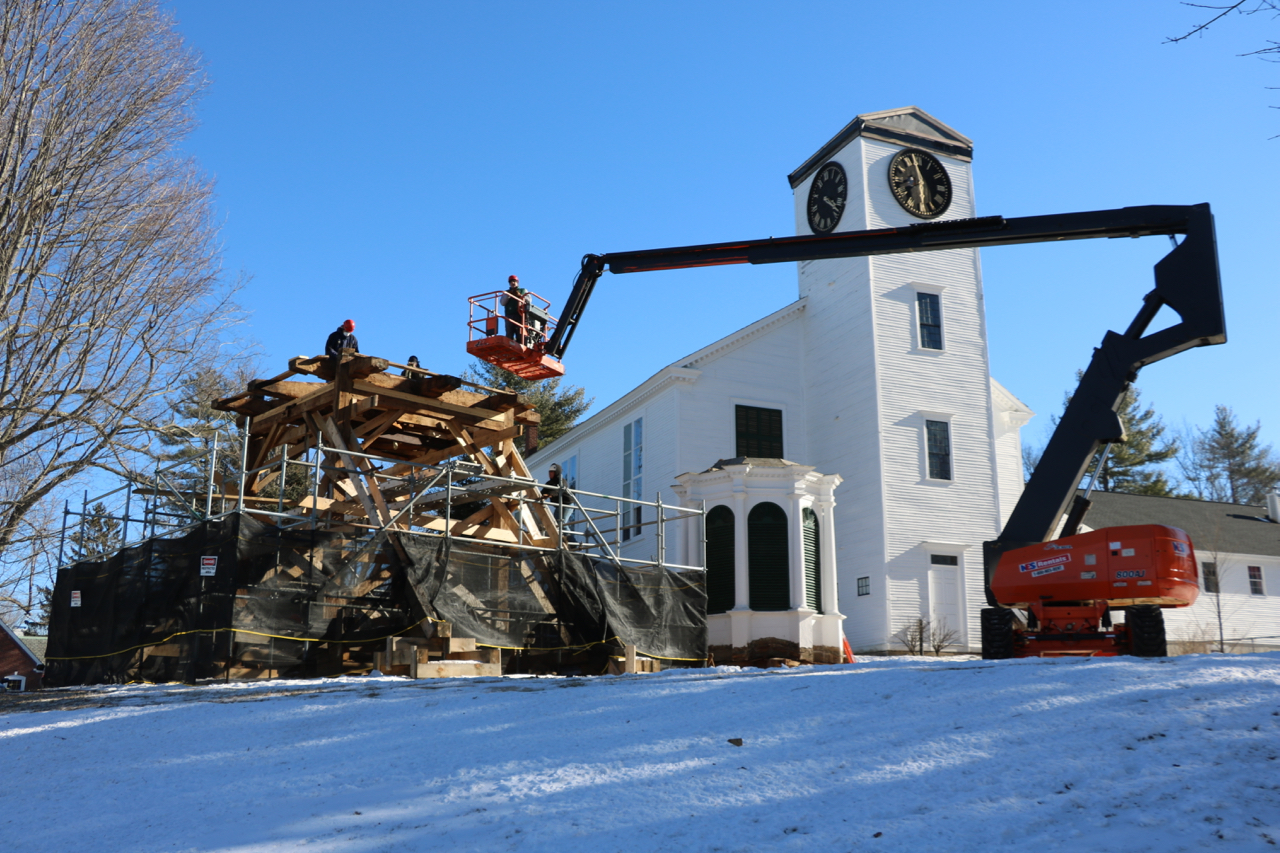
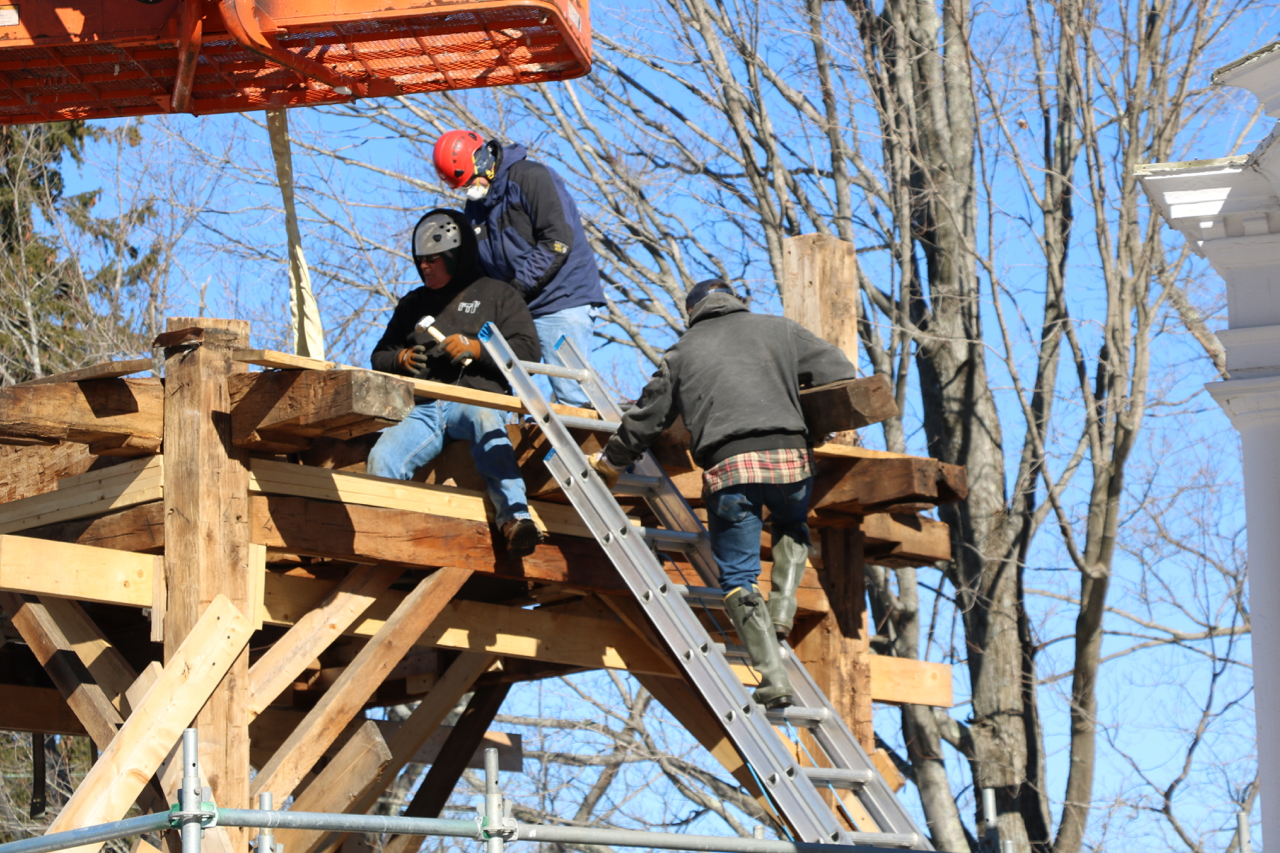
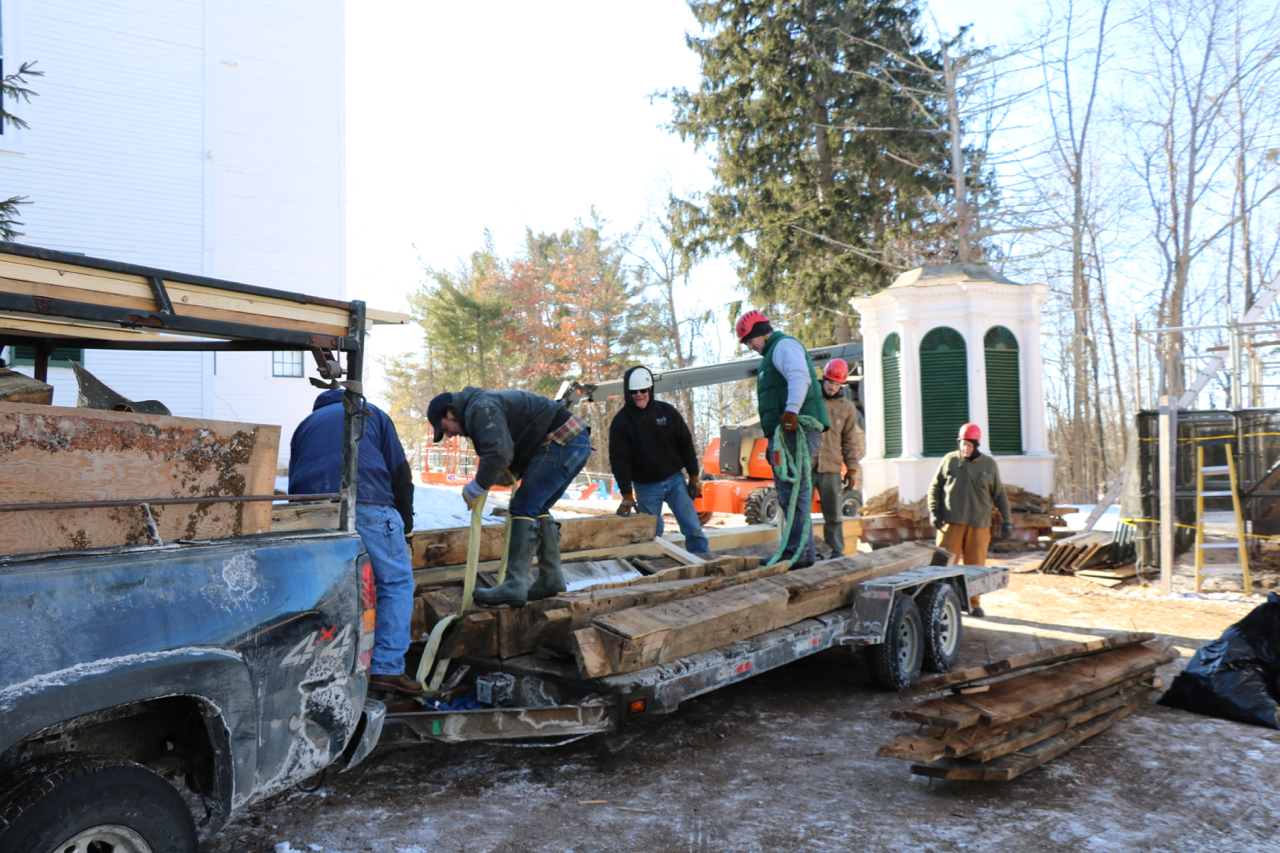

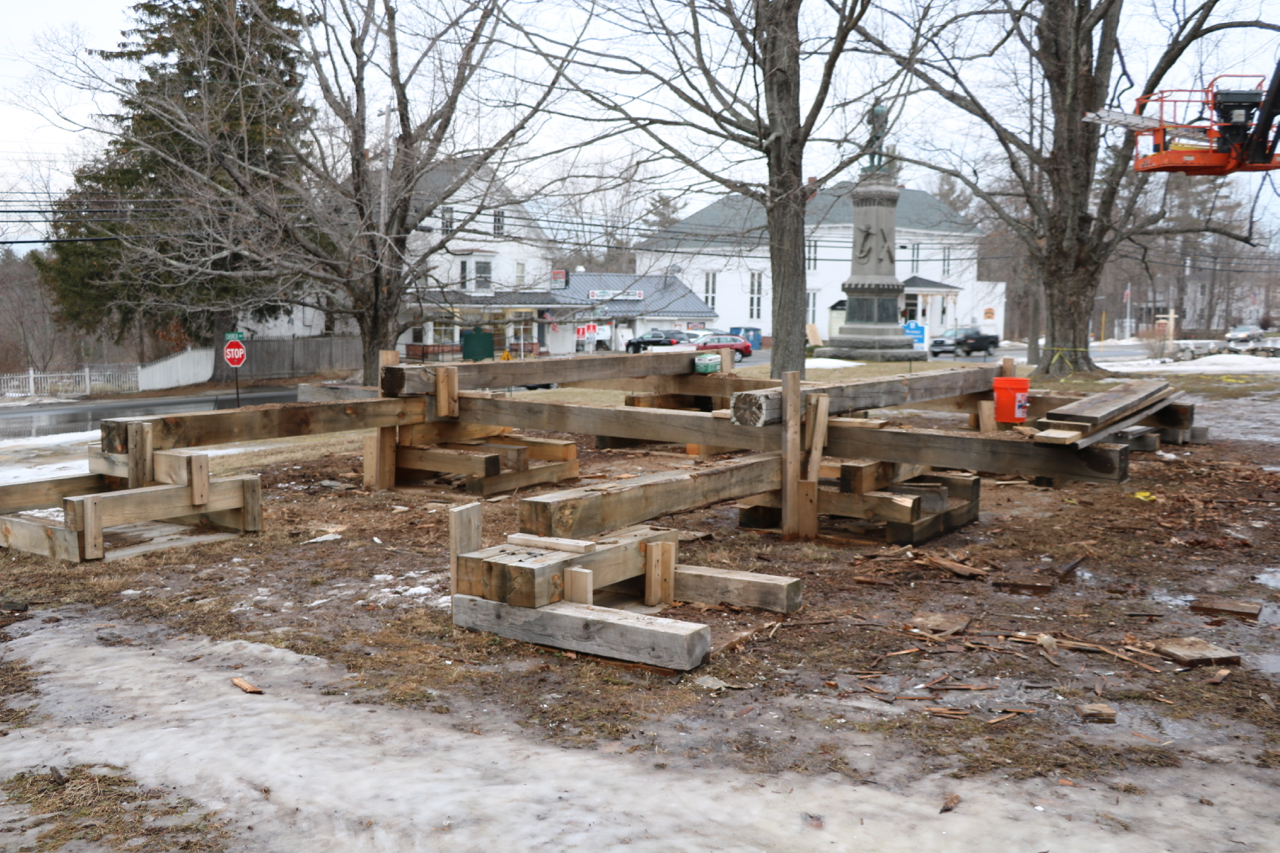
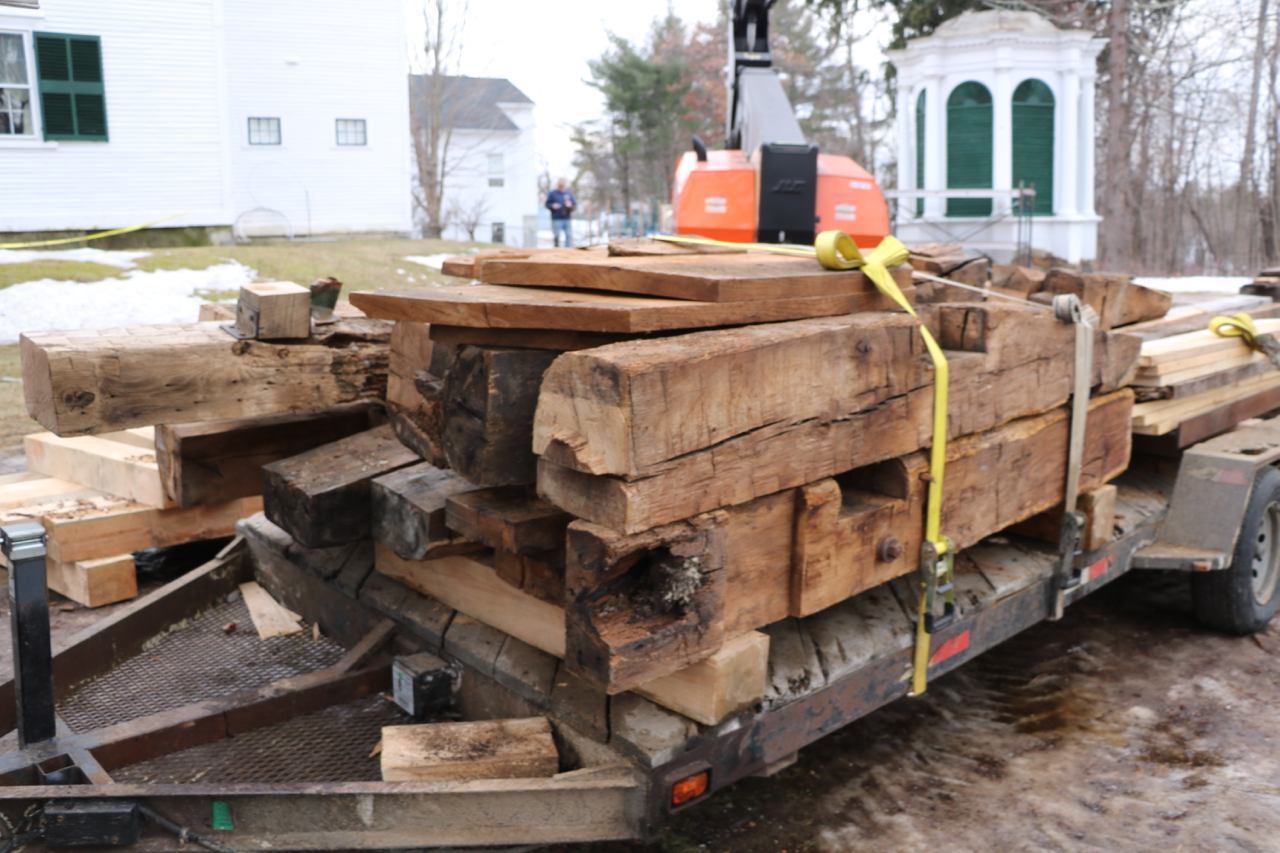
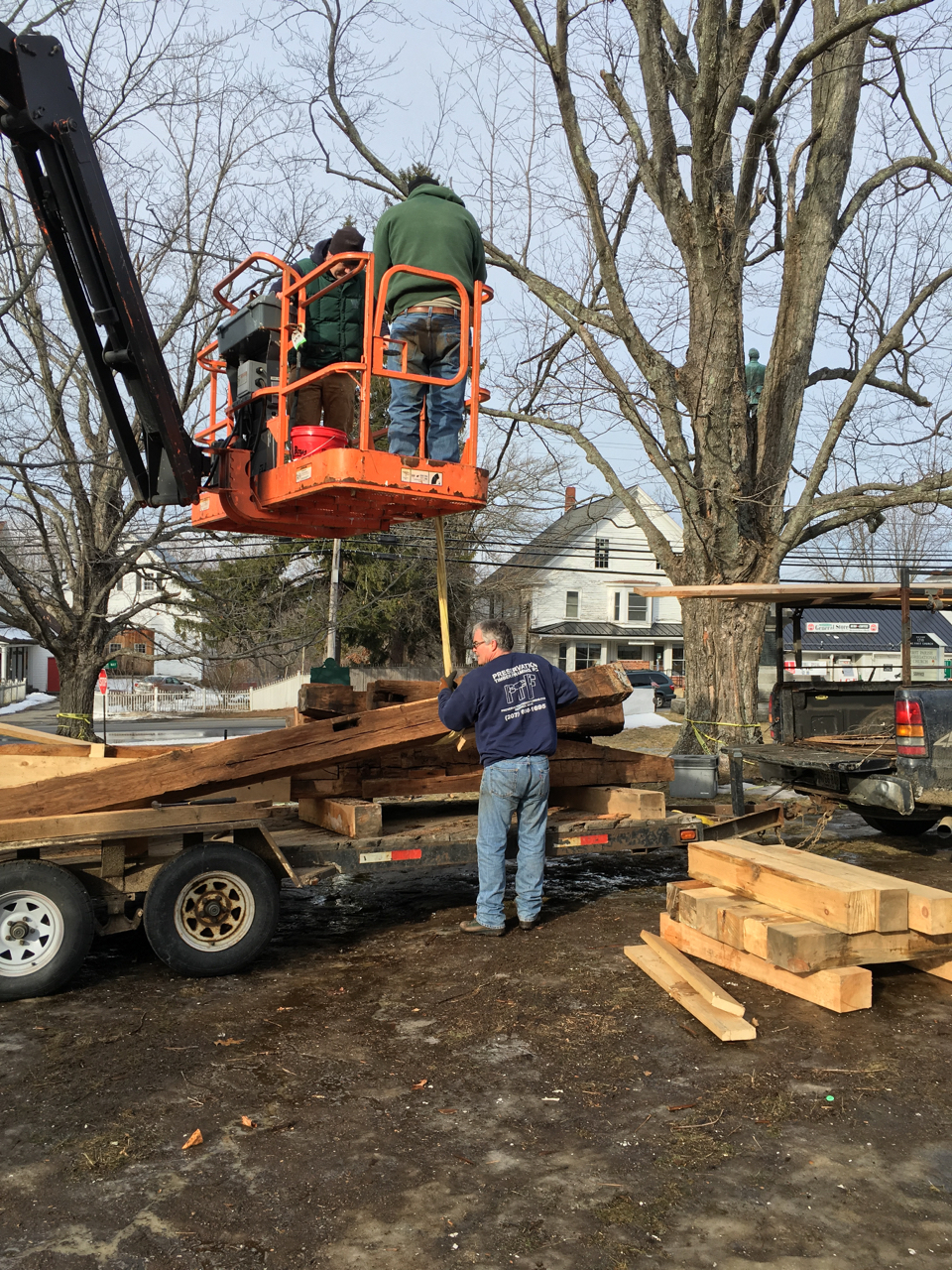
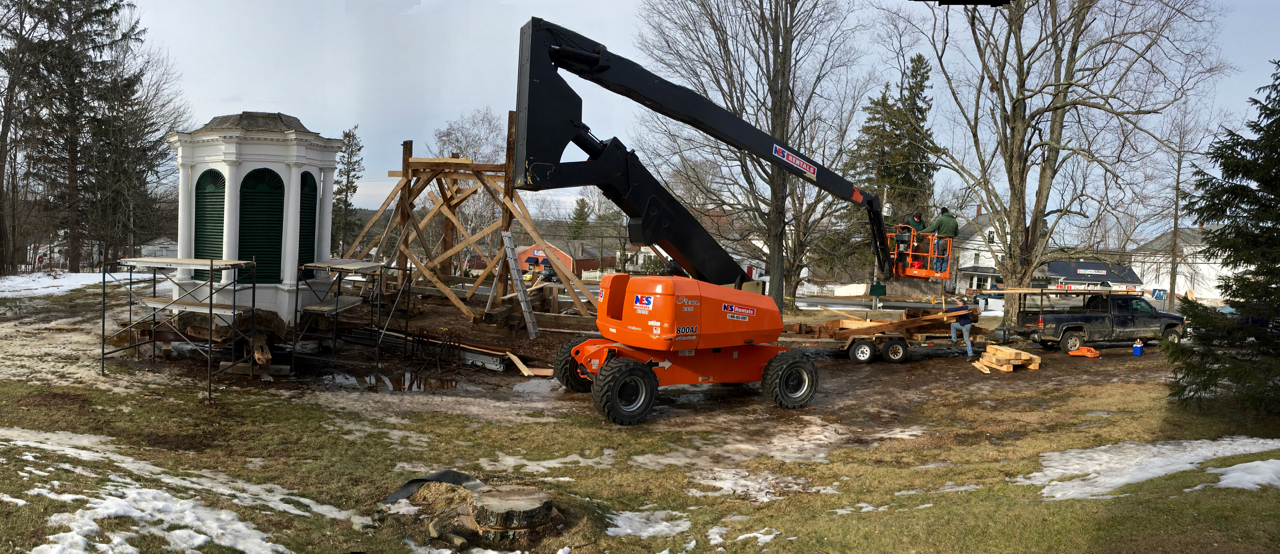
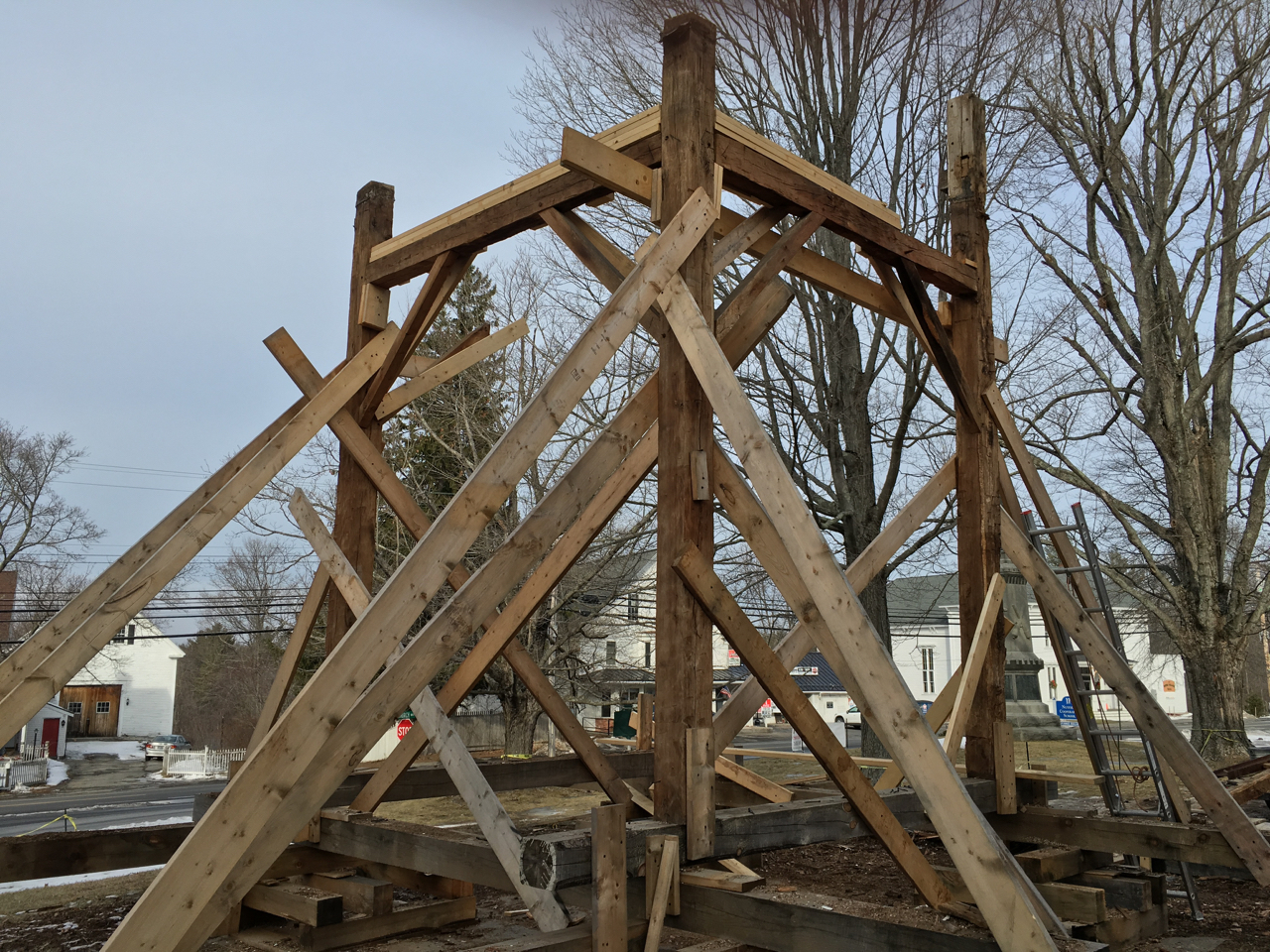
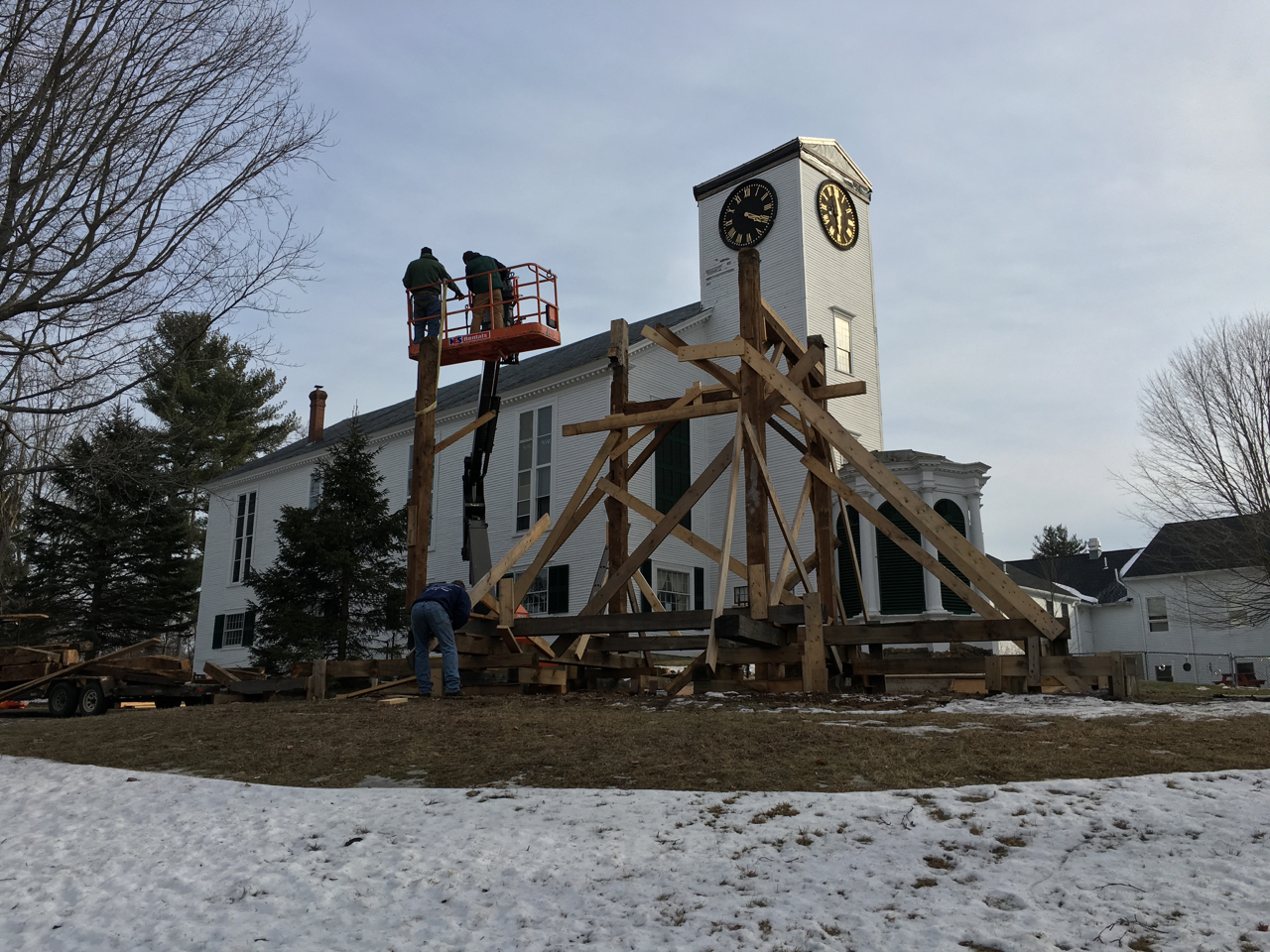


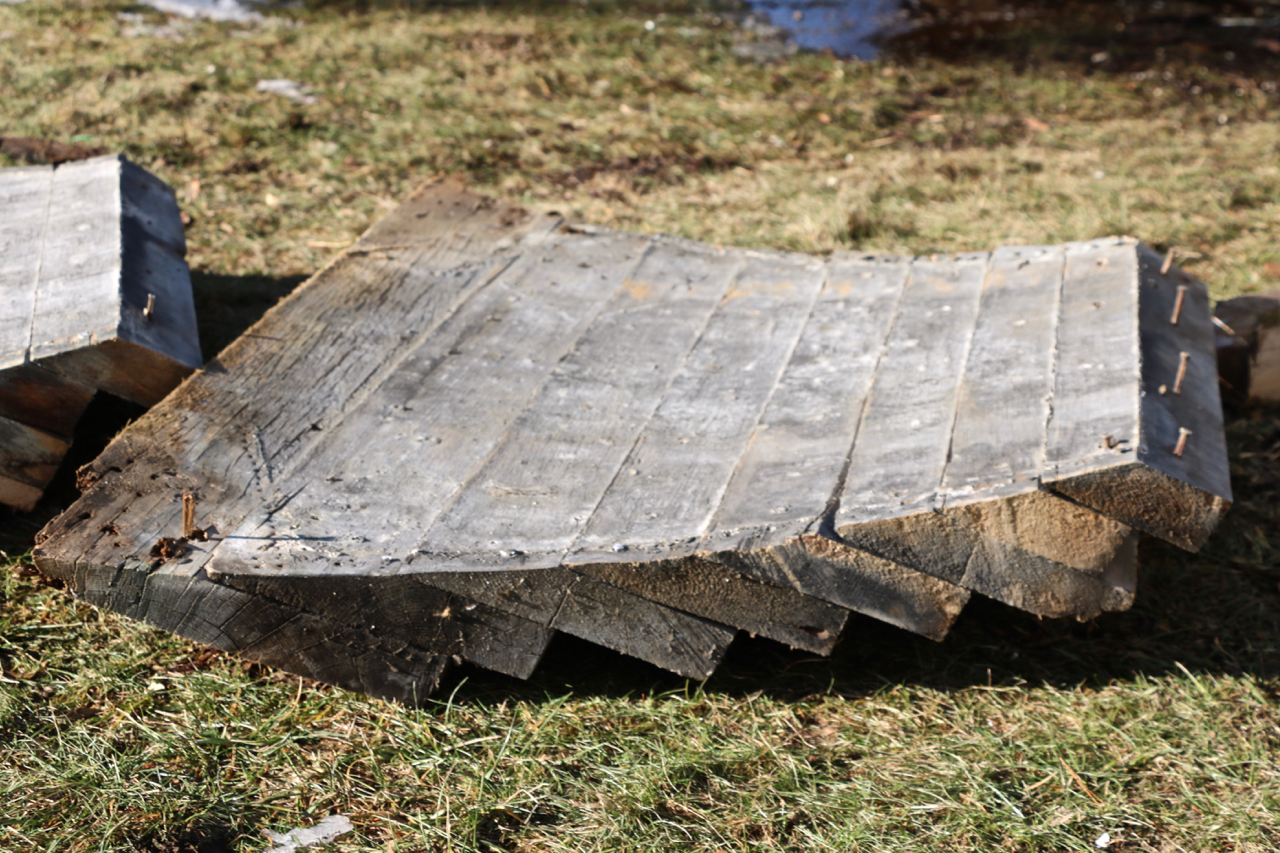
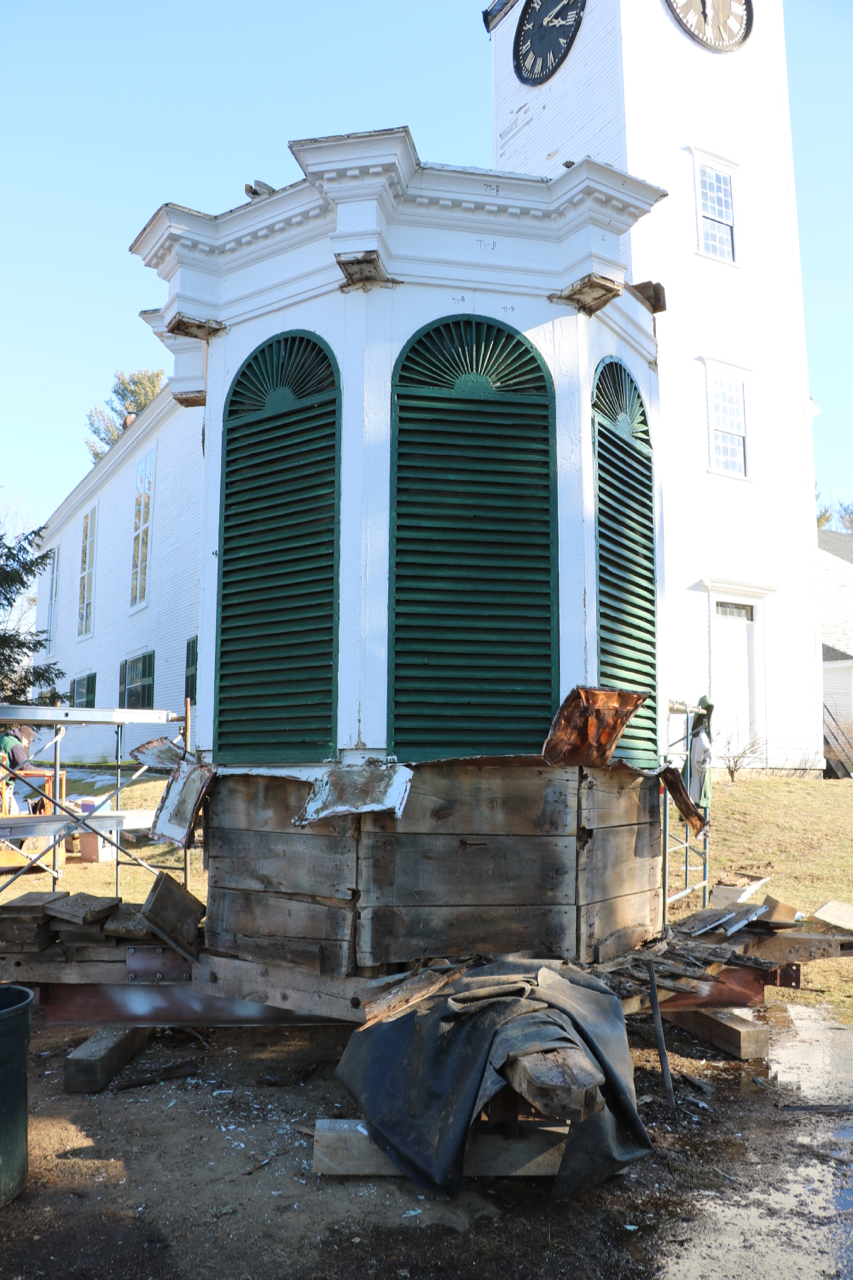
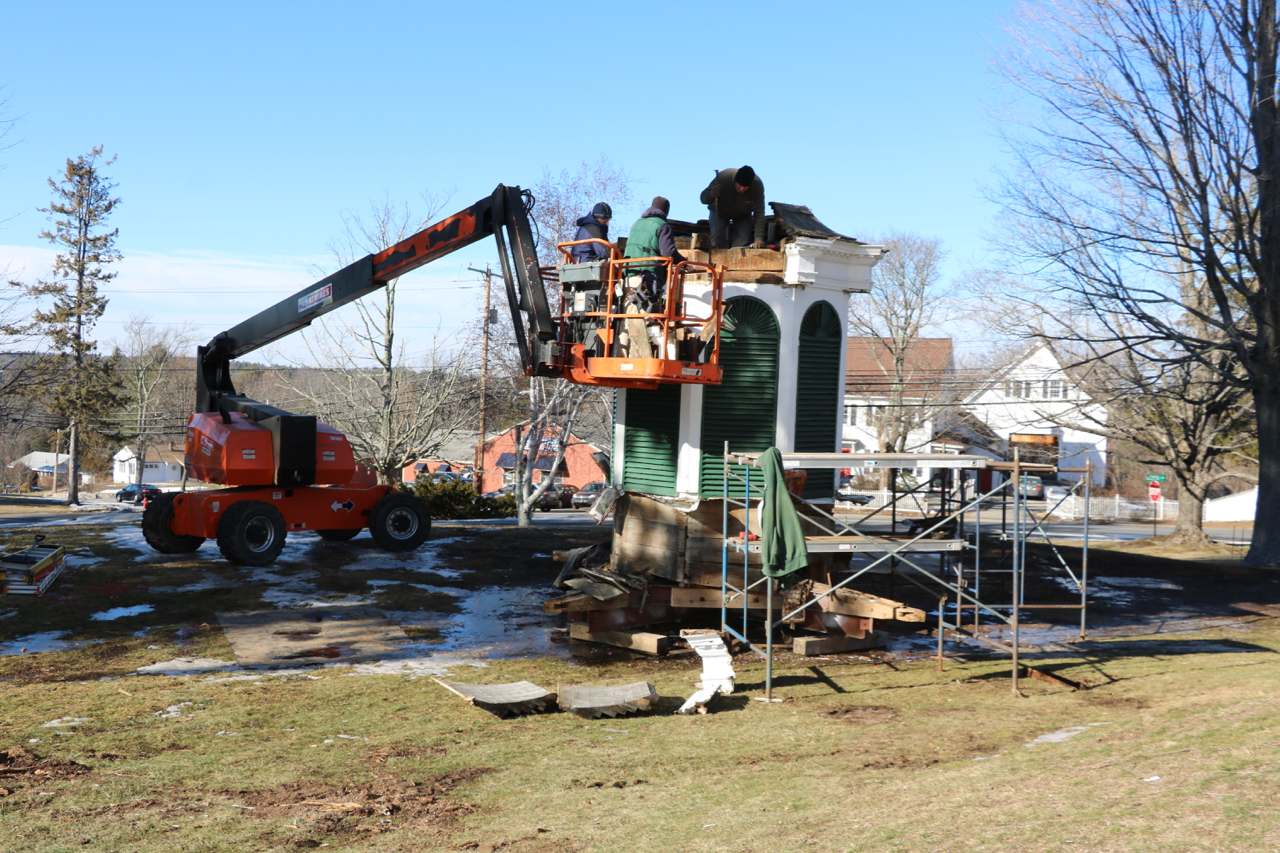
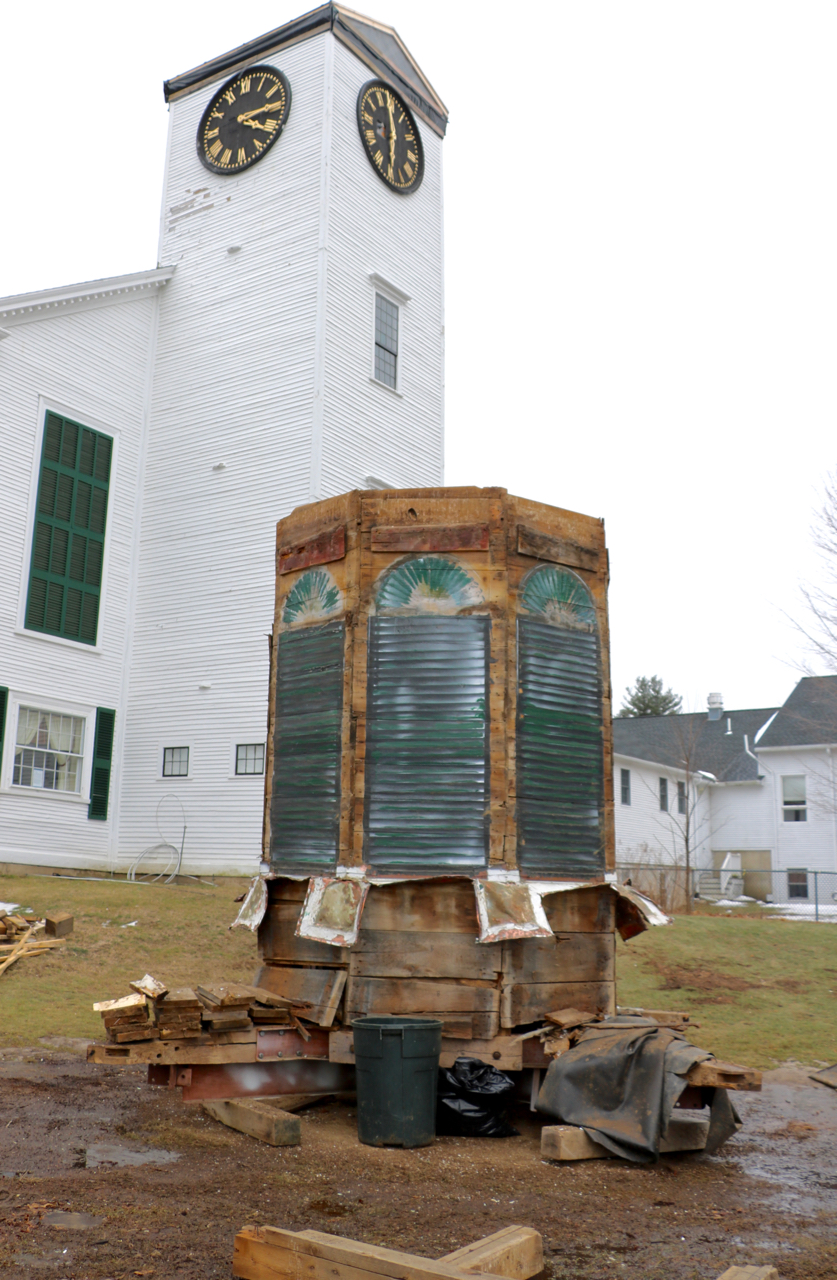
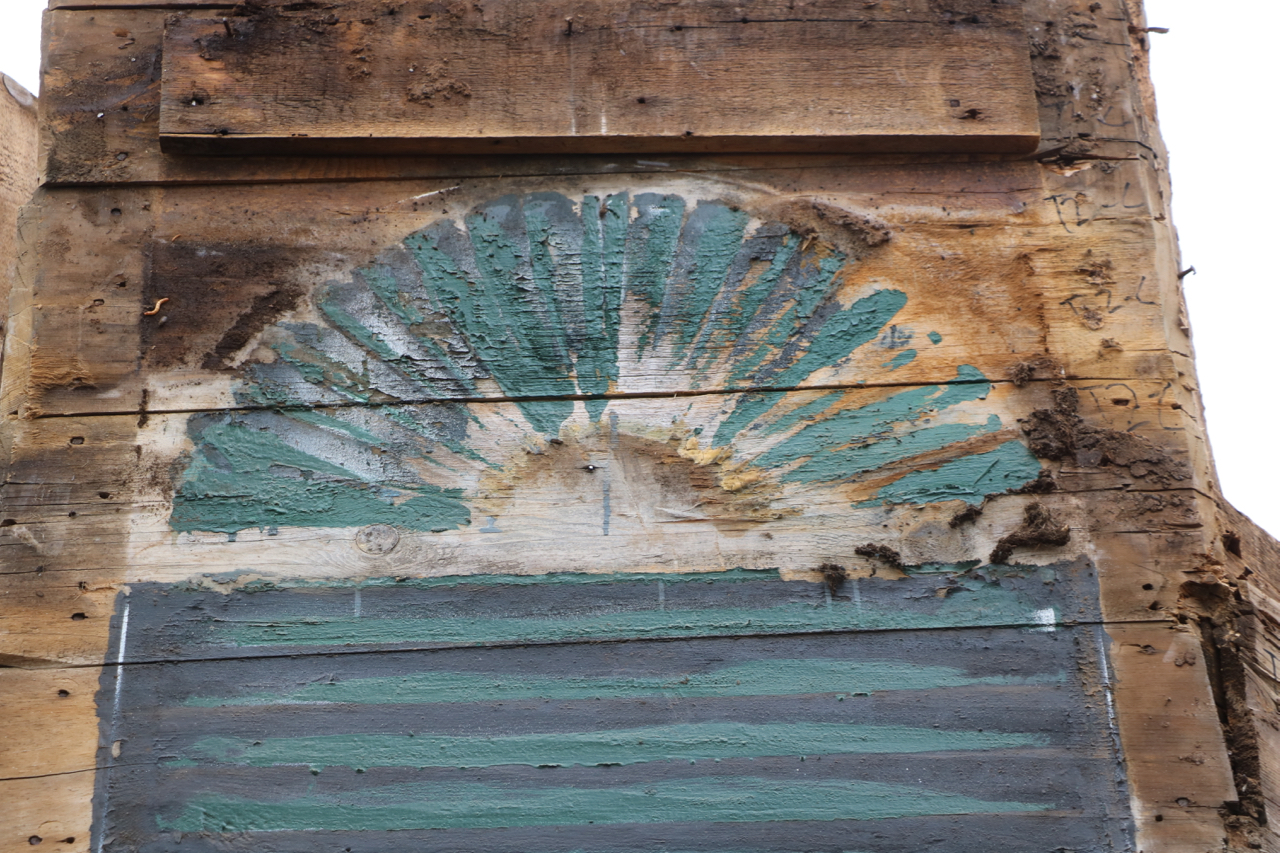
Fresh snowfall on the clean, empty lawn.
All the Tower Top elements are now safely stored at PTF's facility in Nottingham. The major work to repair and restore the Top will mostly take place over next winter. PTF's experts will reuse every element possible, but most pieces will have to be freshly crafted using the decayed originals as models. They'll even seek out the same species of wood as used originally (mostly white oak), and mimic the old carpentry methods.
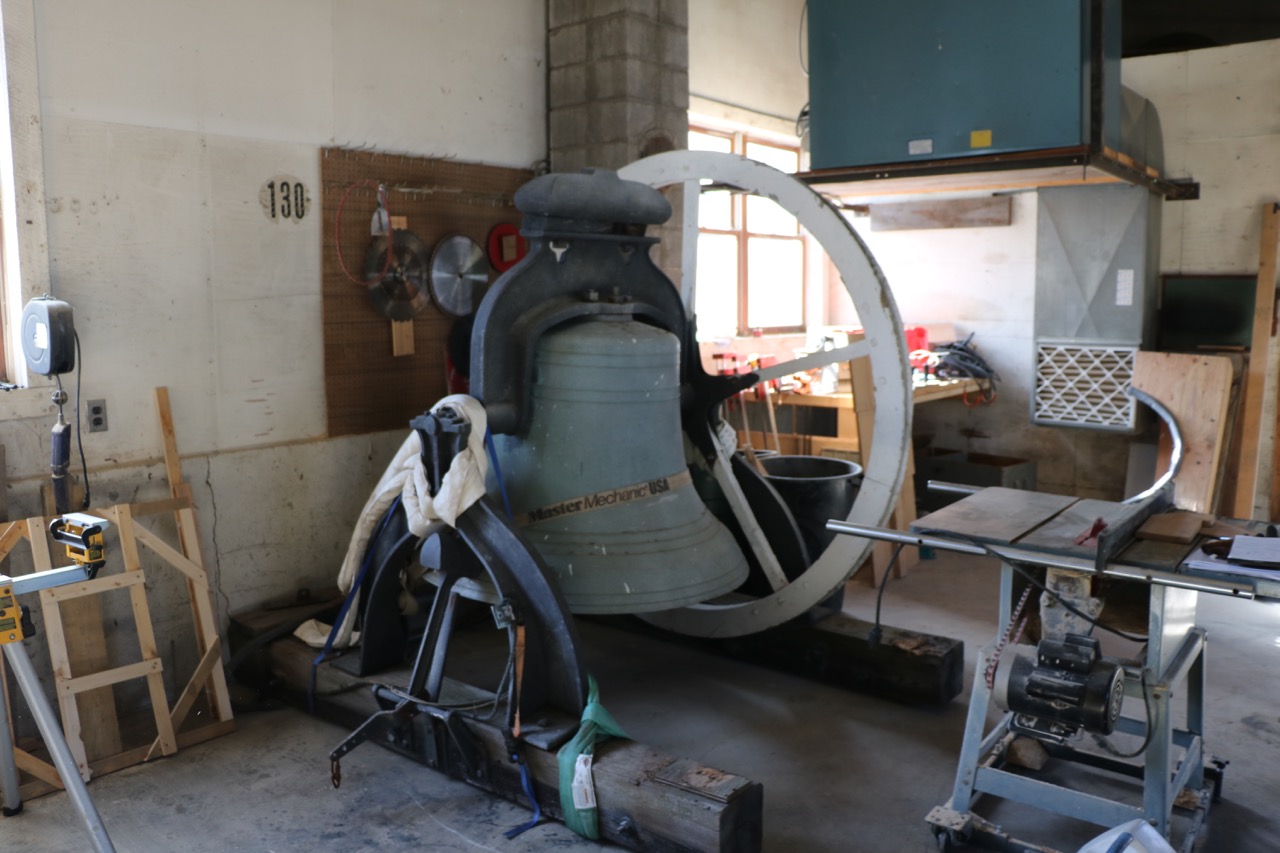
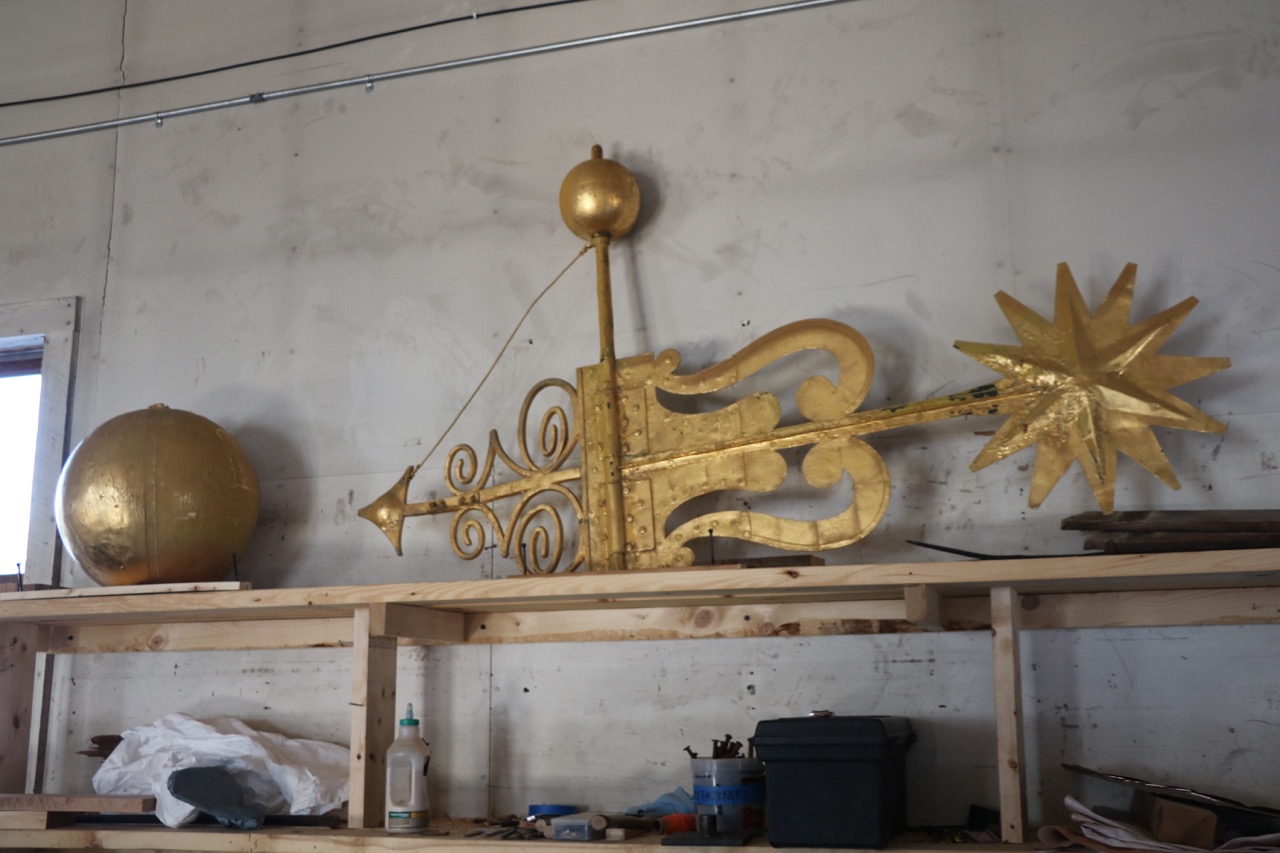
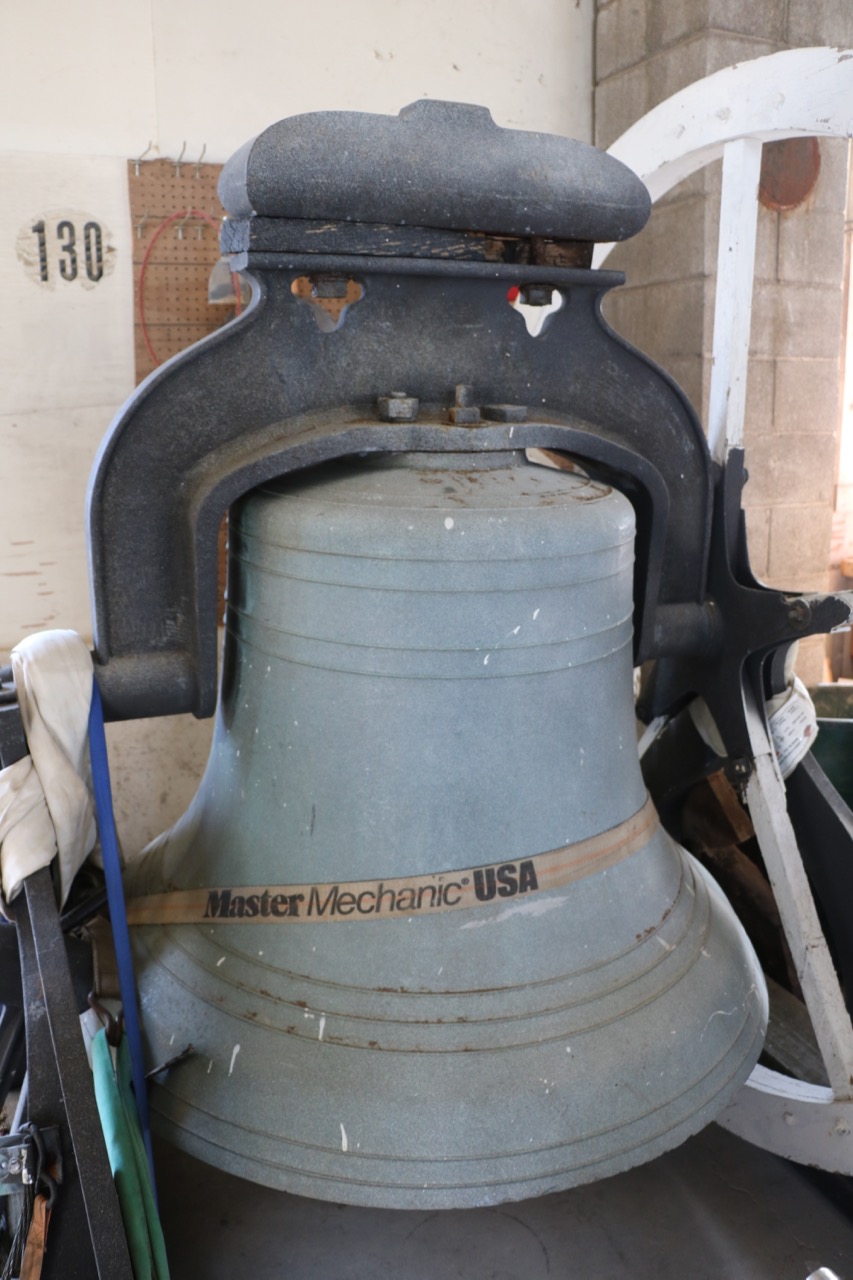
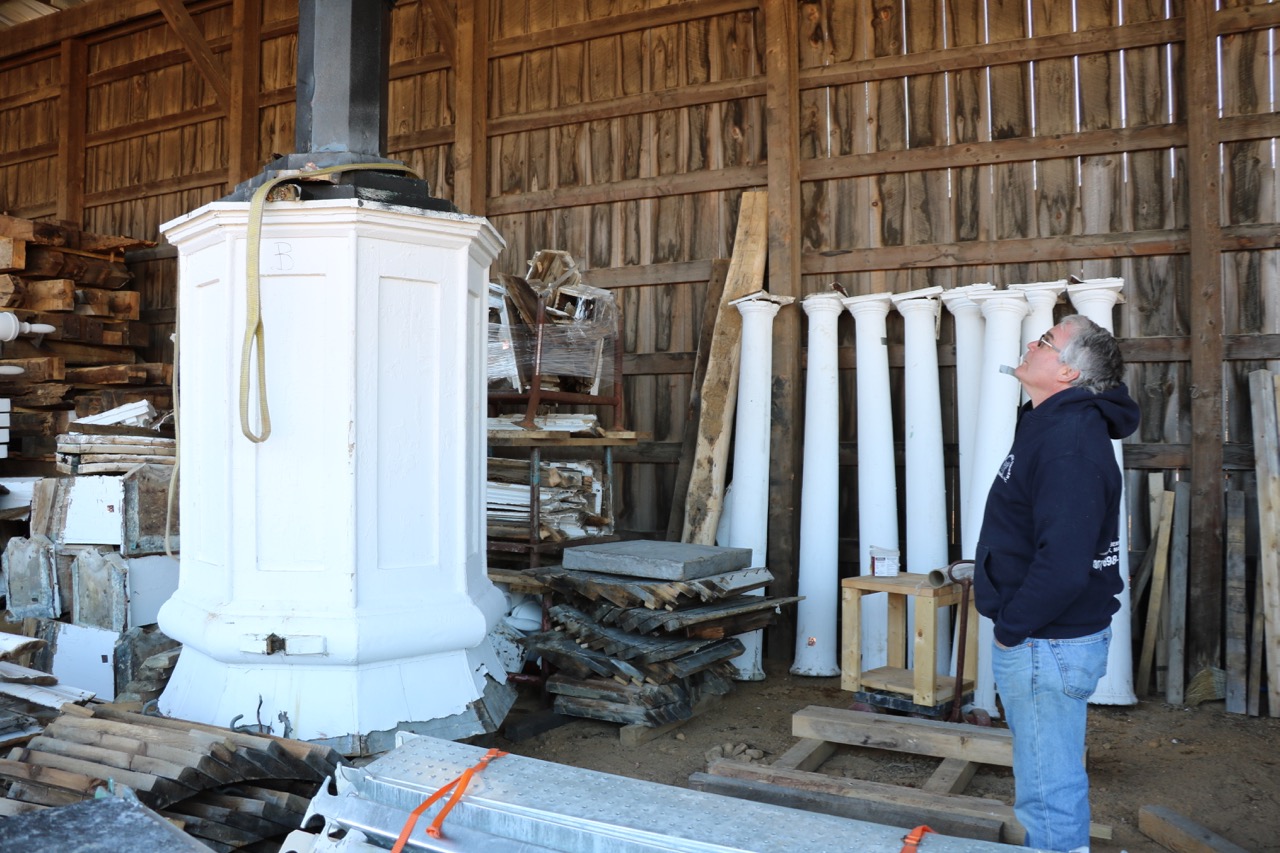
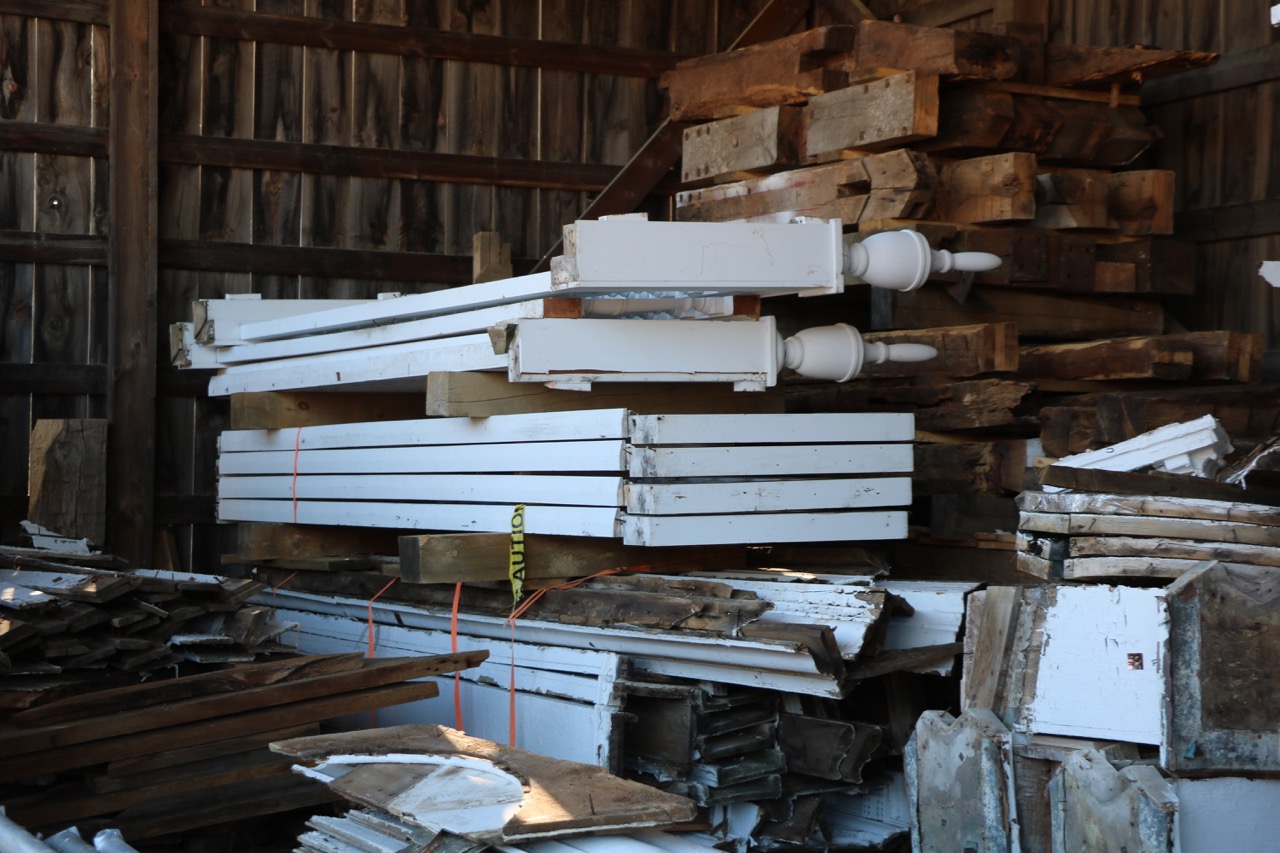
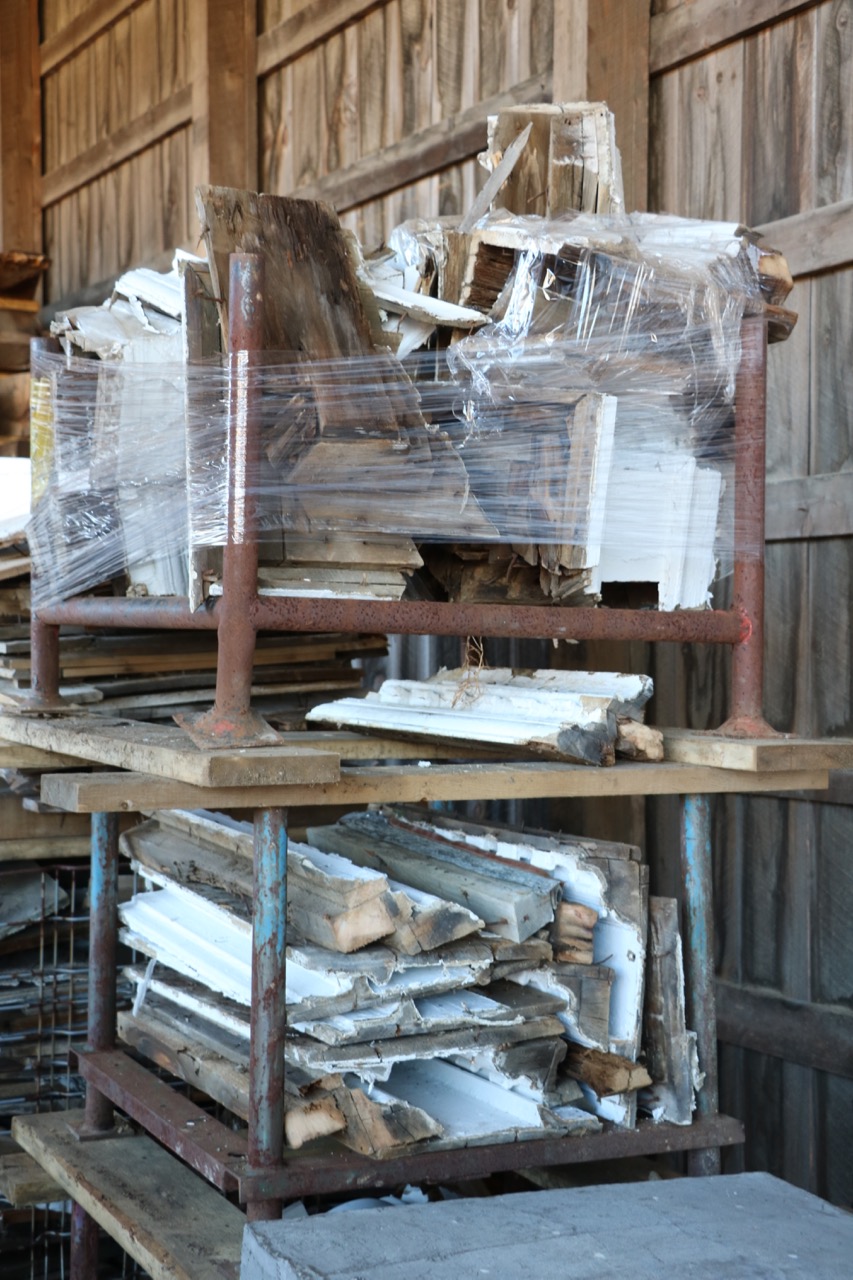
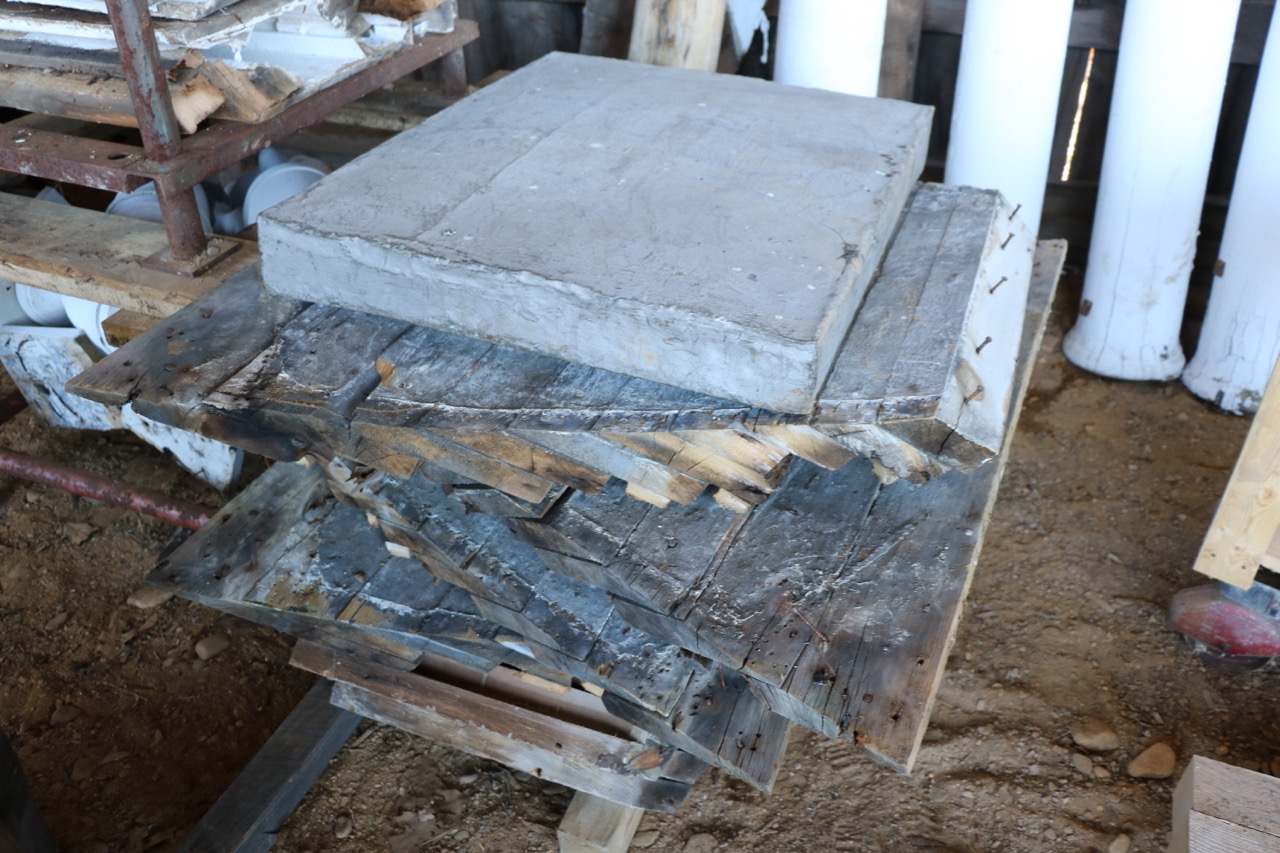
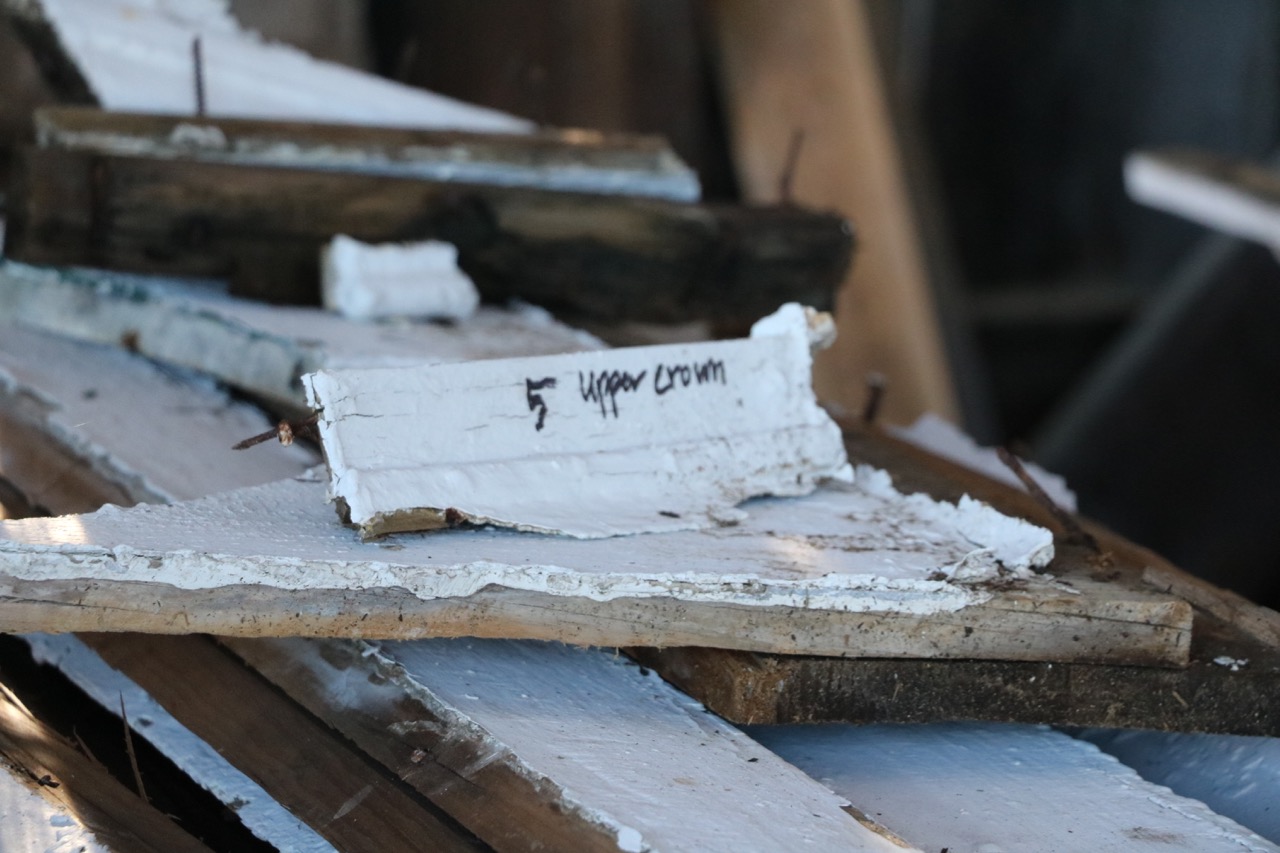
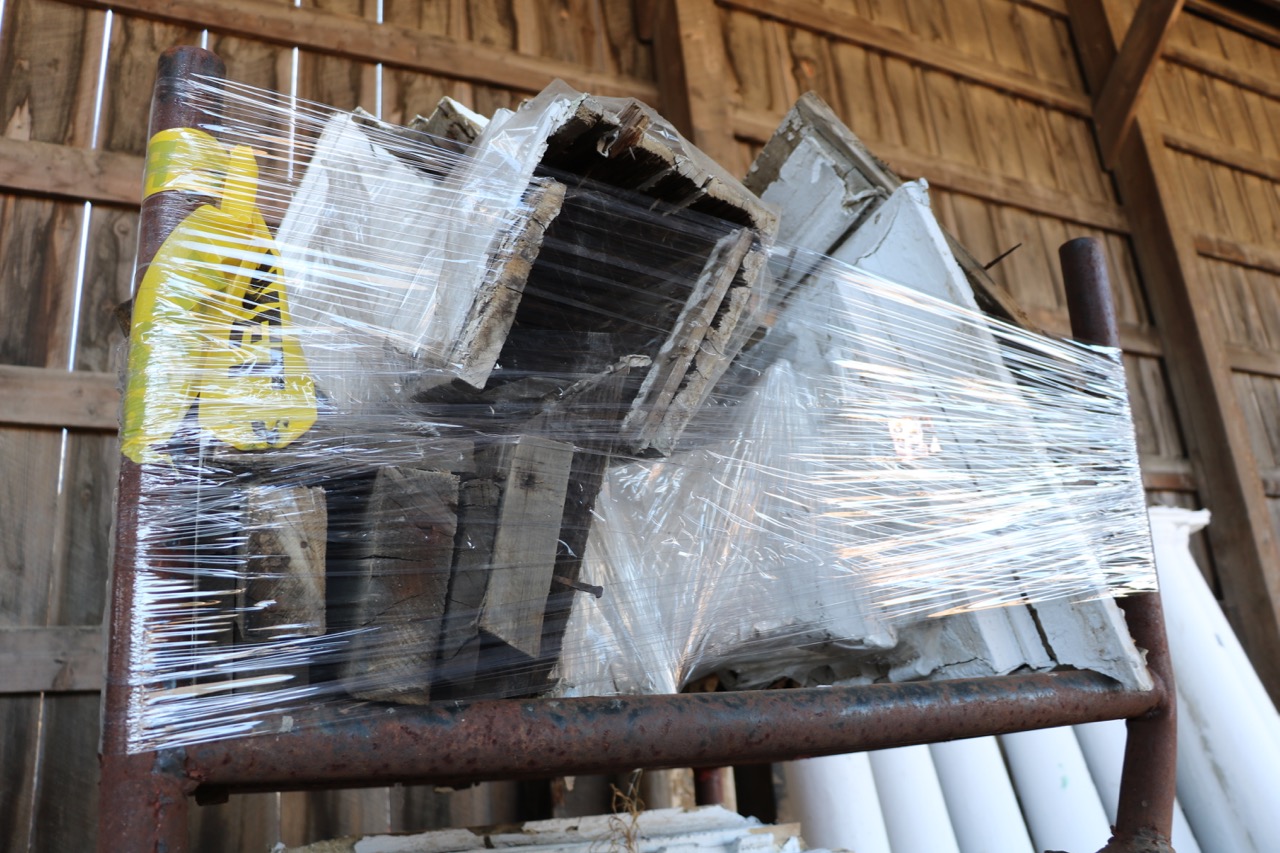
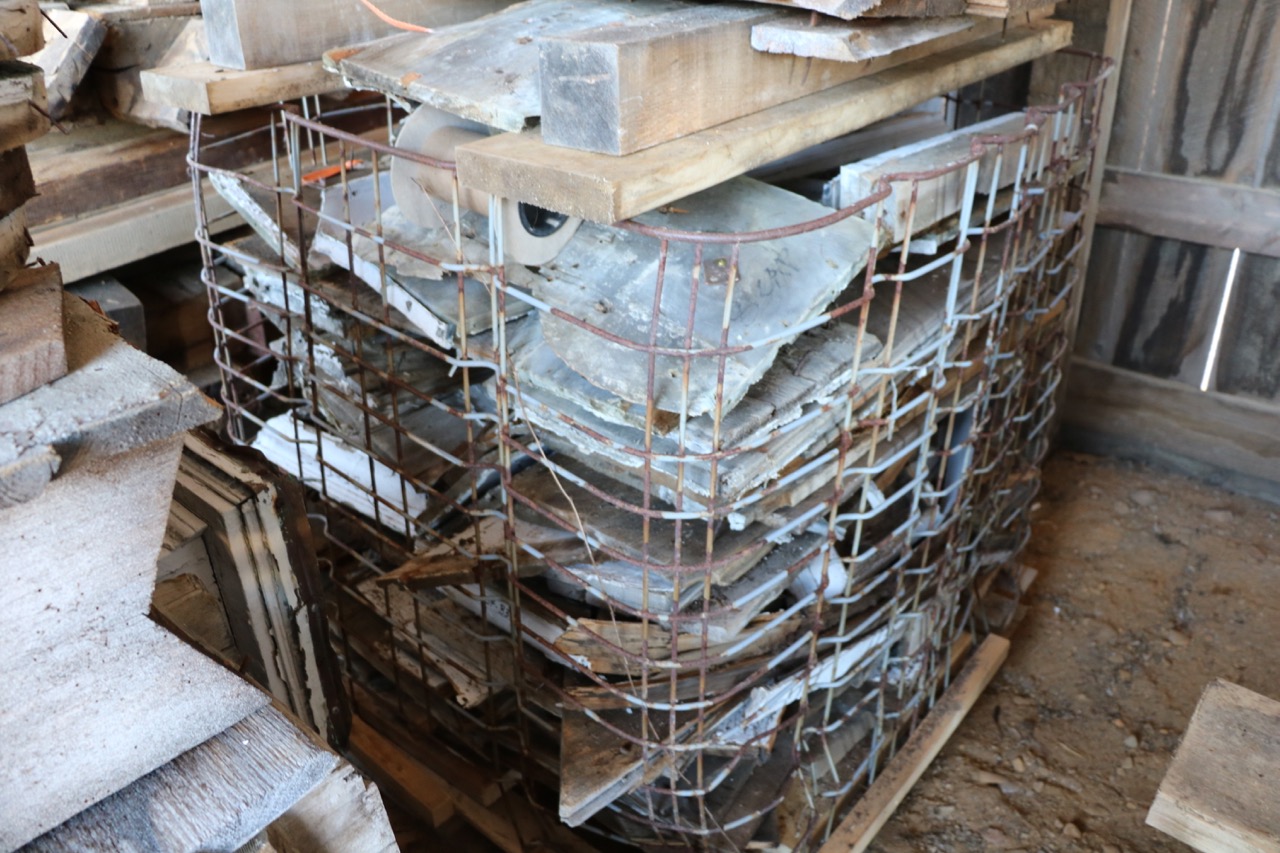
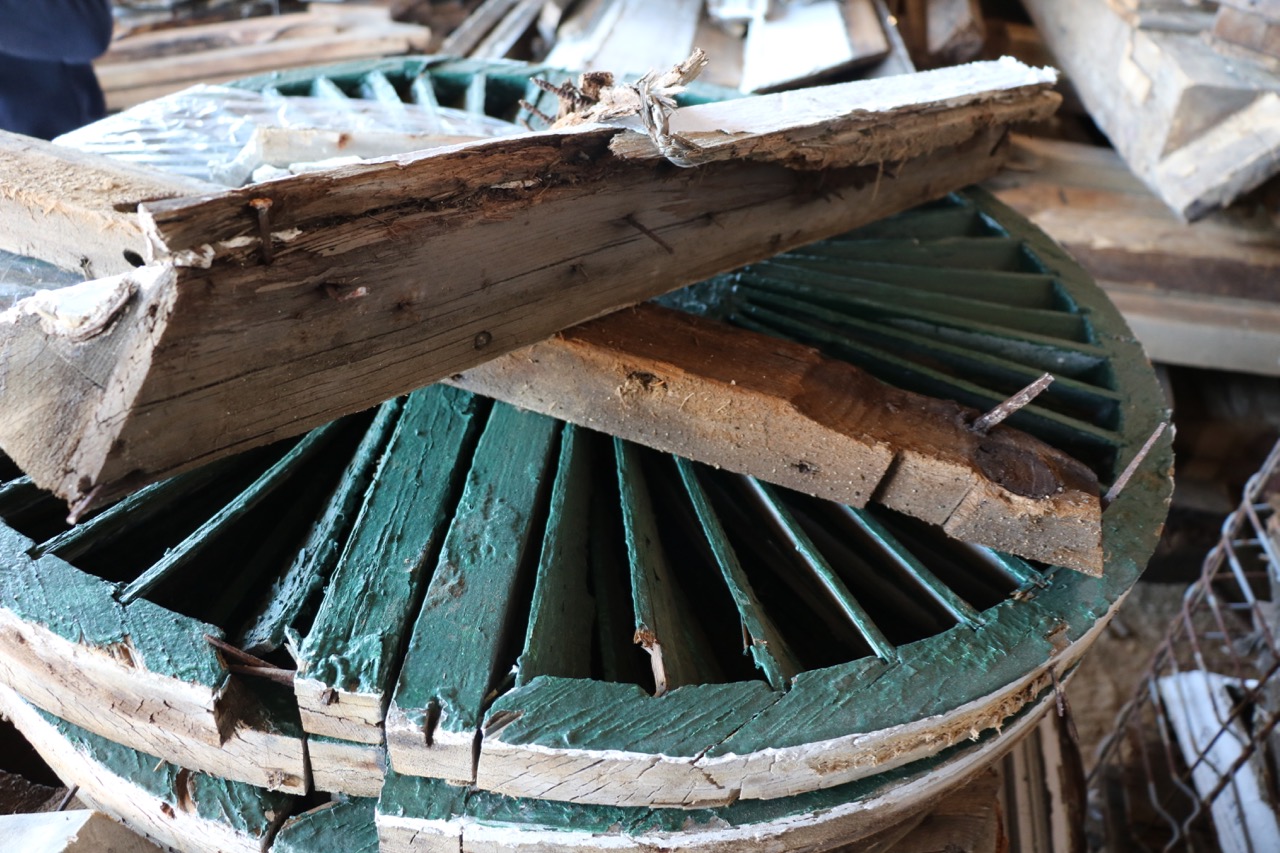
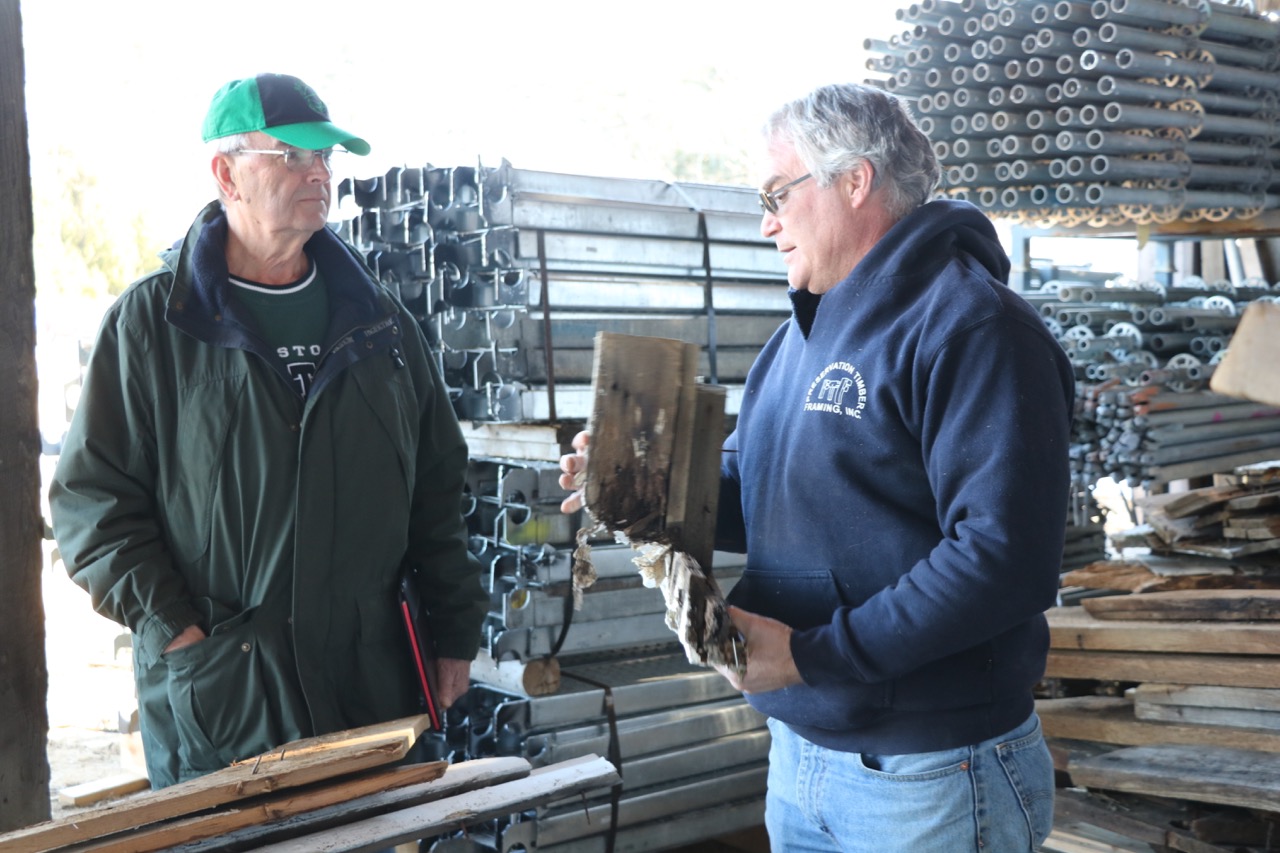
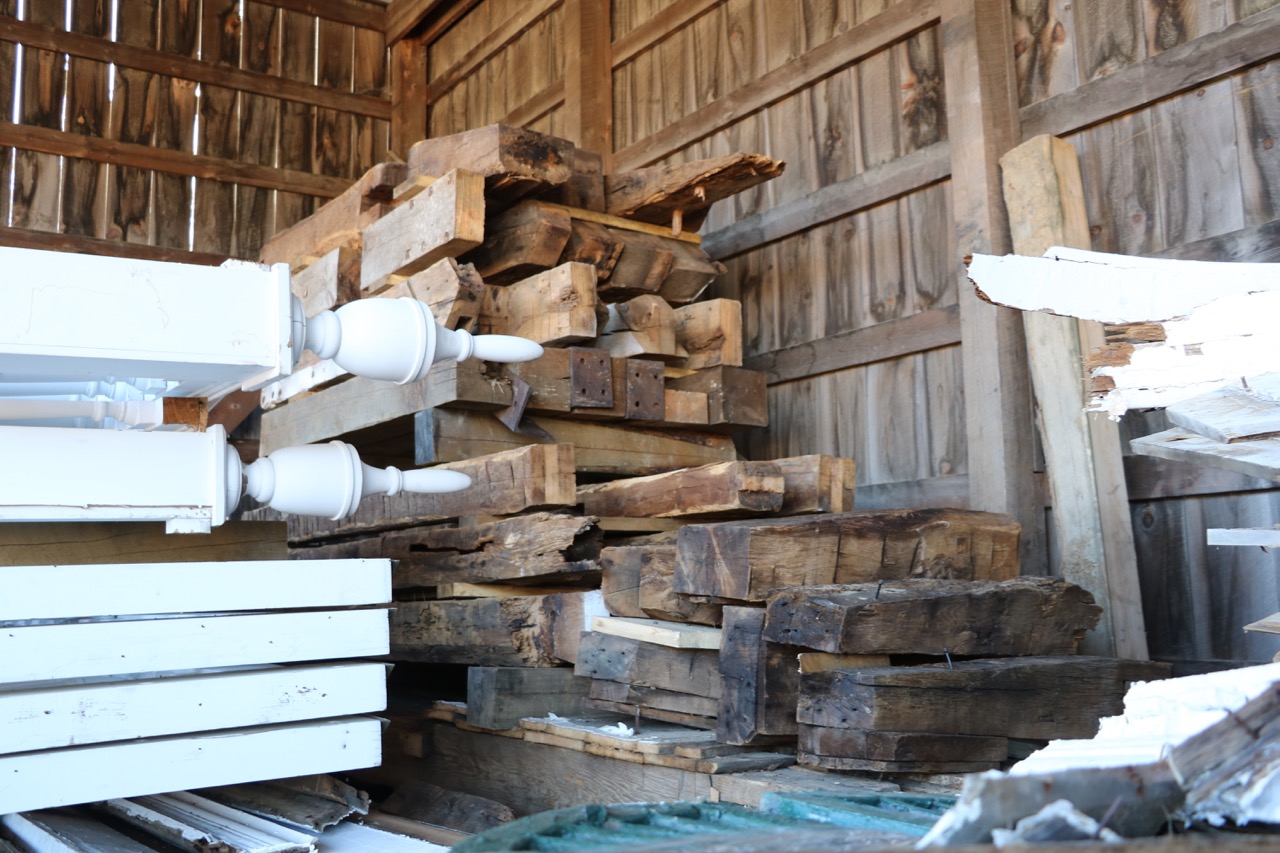
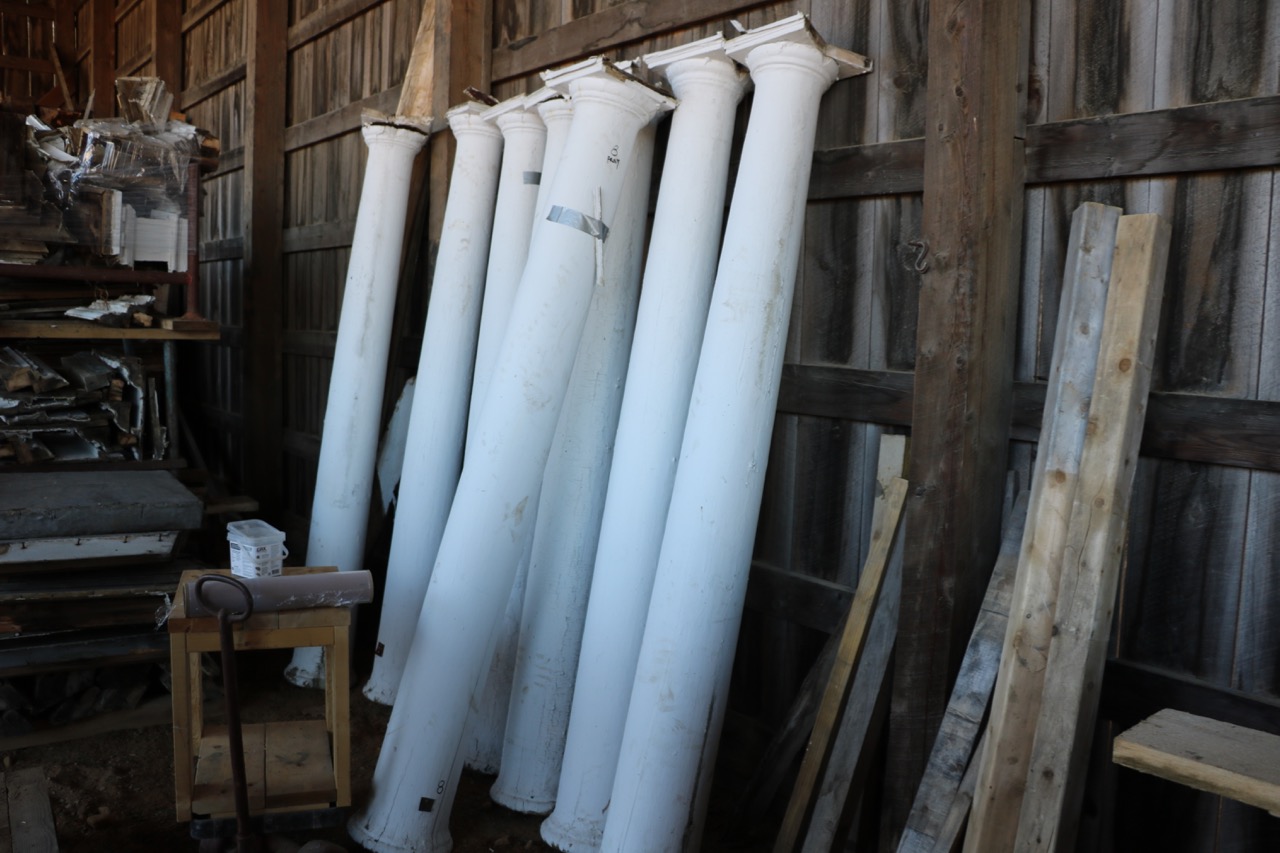
If all goes according to the current construction—and fundraising—plans, the team will rehabilitate the base of the Tower in the Spring and early Summer of 2017 (along with working on the roof and rest of the timber frame). Then towards the end of that Summer the restored Tower Top will be returned to the site, reassembled, and flown back to its proper home on top of the Tower Base.
First Parish's Pastor Dr. Rev. Deborah Roof is very much looking forward to pulling the long rope at the foot of the Tower staircase to ring the glorious swinging bell for the first time in decades.
The Tower Top is Leaving the FPC Meetinghouse
FPC lowered the unsafe Meetinghouse Tower Top to the ground in September, where it provided an impressive view at the top of East Derry hill through the holidays. Now it is being dissembled and transported to keep it safer from the weather as it undergoes two years of repairs and restoration.
In the process of taking down the Tower Top last September, FPC's expert contractor Arron Sturgis of Preservation Timber Framing (PTF) discovered it had even more decay and damage than anticipated.
With Top firmly on the ground, further inspection led Arron to recommend that FPC dismantle and store the the lantern and belfry off-site. There were several good reasons for this, including:
- To avoid any further damage from the weather,
- To secure the valuable weathervane and bell, and
- To make repairs of the complex structure and intricate detail more efficiently in the shop.
FPC agreed, and the work for this subproject began with the new year.
Preparing for Dissasembly
Once the ground froze (very late this year), a rented four-wheel drive, diesel, "man lift" arrived to help the PTF team with their next tasks.
First they thoroughly documented the lantern and belfry with photographs, measurements and notes. Unlike a normal construction job where demolition is done as quickly as possible, in the "Rehabilitation" class of historic preservation FPC is pursuing here every original piece of wood will be either repaired and reused or replaced using the same species if possible. Most of the trim elements here are early Eastern White Pine, with white oak being used where needed for structural strength.
With documentation in hand, the team then carefully removed the weathervane, finials, railings, trim, and roofing, and determined the best cut lines to break the structure into pieces that will fit on a trailer.
They made a fascinating discovery along the way.
Identifying One Source of Damage
After removing the 1990's copper sheathing on the upper lantern roof, they found layers of wooden shingles and an oiled sailcloth covering. Underneath was a scrawled signature and date. The signature is so far illegible, but the date clearly reads "November 1916"!
Apparently at that time they modified the flatter original roof to achieve the more graceful curved line we're used to seeing. The sailcloth covering was an acceptable measure for its day, but required regular maintenance to remain watertight.
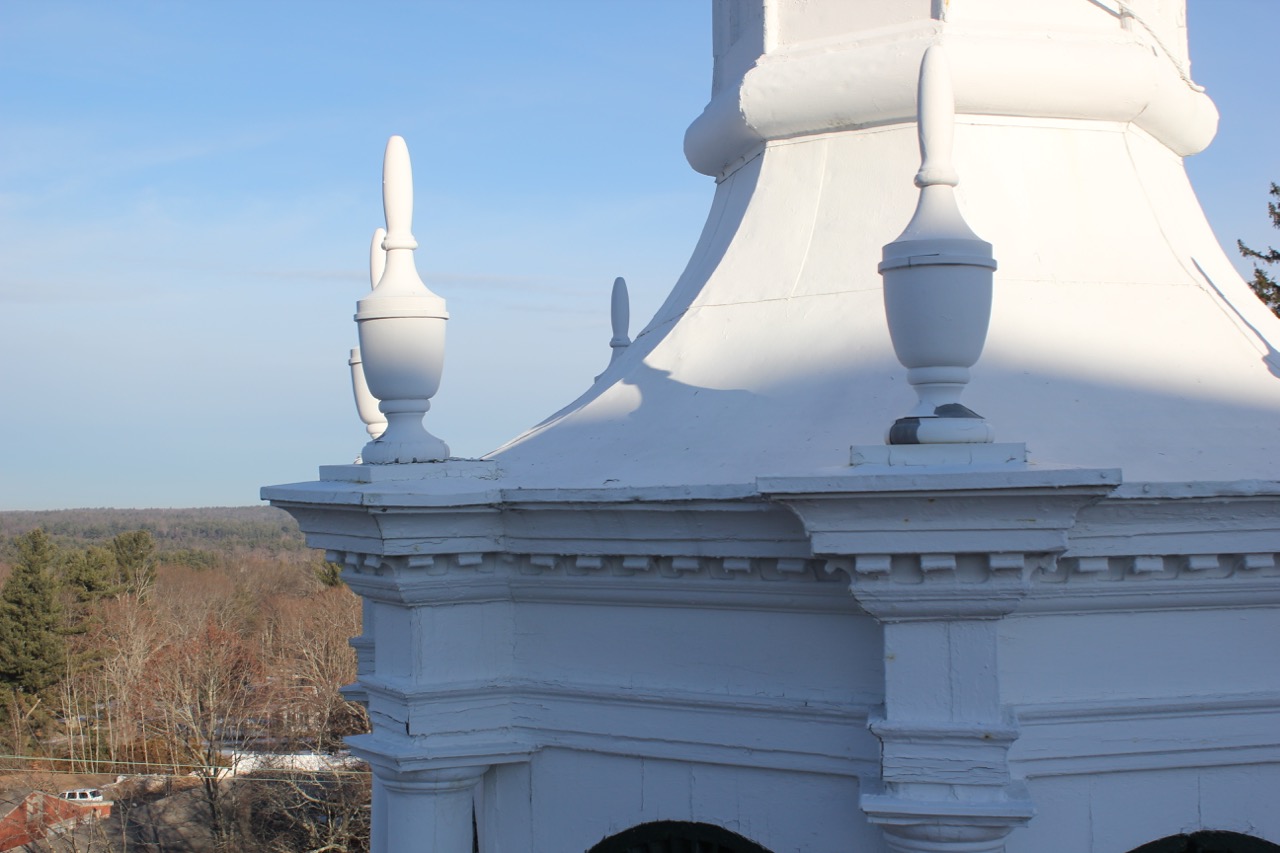
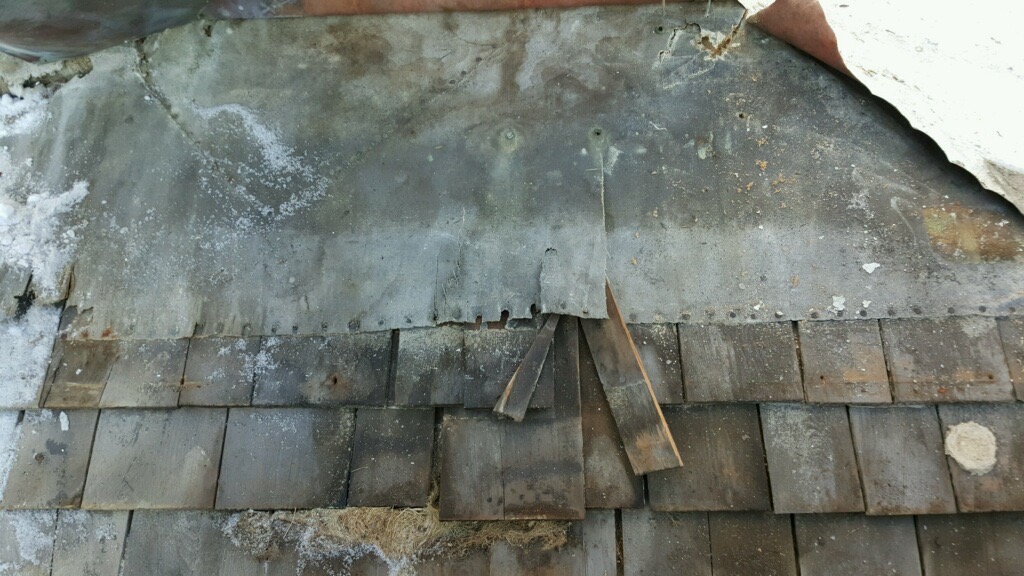
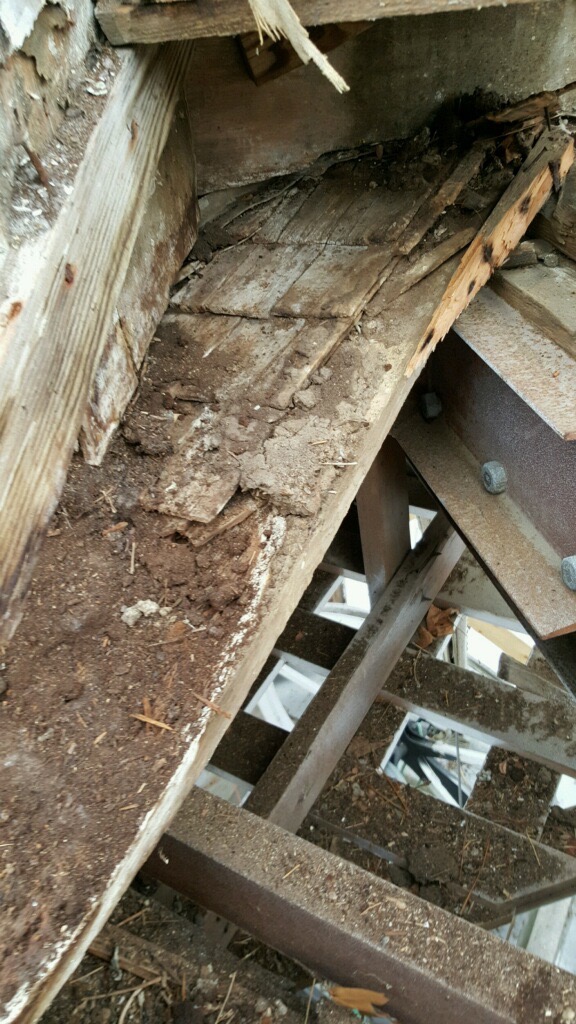
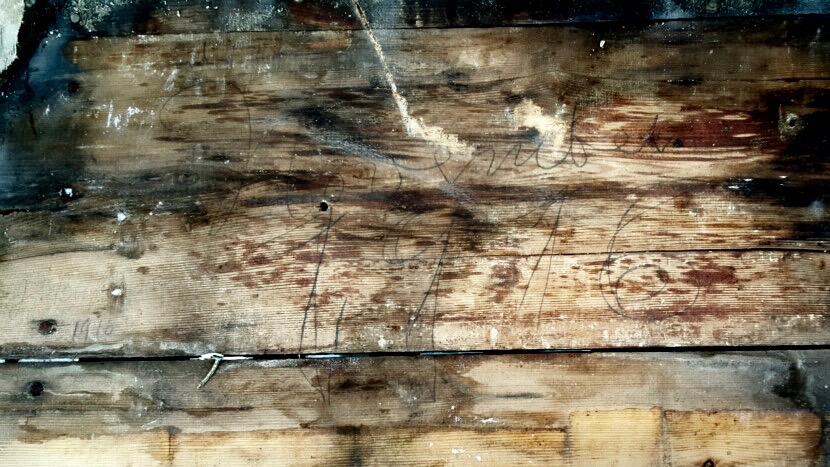
We know that the church was in severe financial trouble in at least the 1930s, so such maintenance was no doubt a very low priority. Water getting in through this roof (before the copper was applied) likely caused much of the internal lantern damage we see today.
Ready for Another Crane Day
As we write this post, the Lantern and Belfry are almost ready for disassembly and transport to their new temporary home.
A 30-ton crane—smaller than that used in September but still substantial!—is scheduled to do this job on Wednesday, January 20 (weather permitting).
The crew will execute the pre-calculated cuts to free the upper lantern, then break the lower lantern and belfry into smaller chunks. The 2,200 pound bell will also be lifted out, and with multiple trips everything will hopefully be delivered to the new site by the end of the day.
That new site is a a huge former lumber mill 35 minutes away in Nottingham, NH. There PTF has a large heated workshop and a much larger covered storage shed.




Two Years Away
Once in Nottingham, the Tower Top can be very carefully restored under excellent (warm!) conditions. There is no rush on this because other phases of the Meetinghouse Rehabilitation work must be completed before the Top can be replaced on the Tower.
Starting soon after this coming Easter in mid-April 2016, church services will switch from the Sanctuary in the Meetinghouse to the function hall in the modern Currier Building. Everything inside at risk from construction work will be moved or secured, and other preparations executed.
Then the Meetinghouse with the Tower base attached will be lifted several feet in the air.
The Meetinghouse floor is just slightly out of level.
Repairs and excavation will be done, and a cement foundation will replace the original granite blocks on rubble foundation we still see today. (A facade sliced from the current granite will cover all exposed cement.) The building will then be lowered, and experience a state of levelness it hasn't seen for several decades.
All the red and yellow timbers need repair or replacement.
In the next summer construction season starting Spring 2017, attention will be focused on rehabilitating the timber frame throughout the Meetinghouse, especially the roof and the west-end wall with attached Tower base. It's after that work is complete that the then-restored Tower Top can return for reassembly and lifting back in place.
Ringing the Bell Once Again
The Tower Top will have had quite an adventure, flying down in September 2015, majestically standing as a new mini-landmark through the holidays, moving to Nottingham in January 2016 for loving restoration, then finally retaking its lofty perch in probably August of 2017. There it will be ready for another century of unique and beautiful community service.
The poor structural state has kept FPC from ringing the Tower bell for several years now. Everyone is very much looking forward to that moment when it can loudly swing once again.
Tower Takedown Videos
Early videos of the FPC Meetinghouse Tower Takedown.
Here are two video views of Takedown Day, Wednesday Sept. 9, 2015, at First Parish Church in East Derry, NH. Read more and see many photos in the blog post for Takedown day.
Big day for the Meetinghouse Rehabilitation effort at First Parish Church in East Derry, NH, with the lift and landing of the damaged tower top. Great work by lead Preservation Timber Framing and also Keeley Crane Service. (Sept. 9, 2015; six minutes)
A quick, time-lapse view of the top lift and landing.
See also the live webcam and saved time-lapse views on the First Parish Church website.
Tower Takedown Day (Sept. 9, 2015)
Photos of the tower top lift and landing, the new roof flying up, and the top secured on the lawn.
FPC Tower Takedown Day (Wednesday, Sept. 9, 2015) began before 7:00 a.m. The crew from Keeley Crane Service in Portland, Maine, started by transferring counterweights from four waiting flatbed trailers to the bed of the crane.
Arron Sturgis and the large crew from Preservation Timber Framing (PTF) then made final plans with the crane team, and began “flying up” and securing the four long bearing timbers.
They finished through-bolting the thick bearing timbers to the even thicker vertical support timbers inside the tower about 11:30, and released the bearing timbers from the crane. The crane crew then changed to the long strap rigging needed for lifting the tower top.
The gathered viewers waited patiently as the team carefully positioned that rigging so as to support the top without damaging the trim work and weathervane. (The weathervane is secured to the tower by a 7’ metal rod buried inside the lantern structure, and PTF had determined it was safer to leave the weathervane in place than to try removing it while still up high on the tower.)
Finally all was ready and the lift began about 1:30.
They slowly raised the top a few inches to check it, then smoothly pulled it out and set it down.
The PTF crew then scrambled to secure the top to the waiting base of timber cribbing, with lumber side supports (and later tensioned steel cables) to support it.
Meanwhile the view out the top of the tower had become dramatically different, with blue sky exposed again for the first time since the tower was constructed 190 years ago.
The crew up top prepared the tower base for its new roof, while the crane crew changed the rigging once again. Then they flew down the first piece of steel to be removed out of the tower. (Repairs in the 1990’s employed steel beams, brackets, and lag bolts, which are failing now; going forward we are using historically-accurate timber frame construction methods that should provide a century or more of service.)
Raising and securing the new roof was then straightforward. The crane crew packed up and left, and the Tower Top Takedown Day that many people had worked hard to achieve was successfully completed.
By two days later, PTF had cleaned up the job site, and secured the tower top with scaffolding and debris netting. Next they will study and report on the actual state of the tower top and base — now easier to determine — and work with the FPC Building Advisory Committee to plan the best next steps.
Tower Takedown: The Day Before, Sept. 8
Final preparations, and the arrival of the crane.
A large Preservation Timber Framing crew hustled today to make the final preparations for the takedown tomorrow.
They disassembled the layer of scaffolding around the tower top, and reassembled it around the cribbing where the top will rest on the ground. (They'll move more scaffolding to completely surround the top after the takedown.)
In the morning, three flatbed arrived with the heavy weights that will counterbalance the massive top when lifted by the crane.
The crew made a ramp for the crane to drive over the curb, and laid out the heavy fiberglass mats that help protect the lawn from crane. And in the afternoon the crane arrived! It is indeed huge.
Now the new roof is trimmed out and ready to fly up, the cribbing on the ground is all set, and the final plans for attaching the bearing timbers to the belfry and then the crane to the bearing timbers have been made.
The action begins early tomorrow!
Tower Takedown: Friday, Sept. 4
The reinforcing and rigging work Preservation Timber Framing could do early is complete. Today they brought in more lumber for supporting the top on the ground, cleaned up the job site, and marked off some of the safe viewing areas for the Takedown (Wed. Sept. 9, 10:00 a.m. - 12:00 noon).


